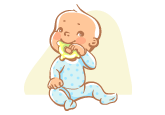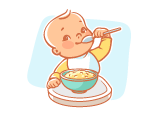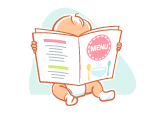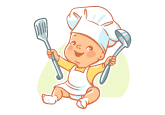Diet Plan (6 Months+)
Diet Plan Chart
6
6 Months Old Baby Food Ideas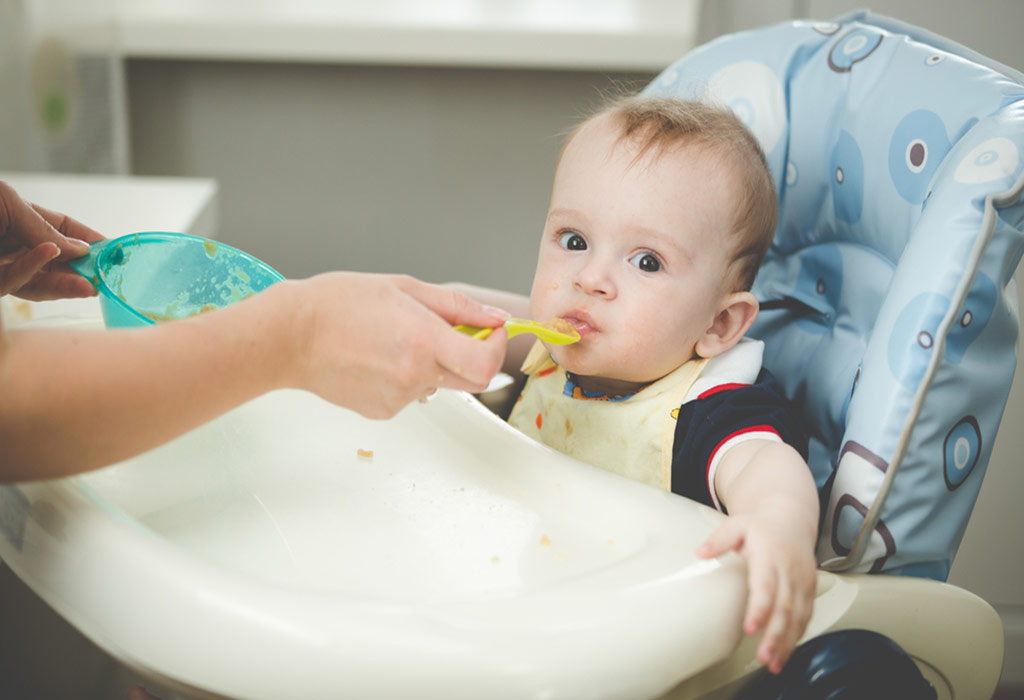

Congratulations, your baby has hit the half-year milestone. In the first six months of the baby, she would have gained all the nutrients from the mother's milk. It is now time for your baby to start tasting solids and relish the food around them.
Nutrient Requirements of 6 Months Old Infant
Here are the nutritional components in baby food for 6 months old:
Calcium: Calcium in food is essential for their bone and teeth development.
Iron: Iron helps carry oxygenated blood to all the developing parts of the body.
Zinc: Zinc helps cell repair and growth.
Fat: Fat insulates the baby and helps in brain development.
Carbohydrates: Carbohydrates are the primary source of energy and fuels their day-to-day activities.
Protein: These are a must for growth as they act as building blocks for cells.
Vitamins: Different vitamins contribute to the growth of the baby differently, and almost all the vitamins including Vitamin A, B1, B2, B3, B6, B12, C, D, E and K are essential to the baby.
Minerals: Minerals like sodium and potassium directly influence the growth of the baby.
How Much Food Should Your Baby Eat?
Typically, a six-month-old baby is still primarily breastfed or formula fed. Besides this, solid food can be introduced at one primary meal of the day, preferably breakfast or lunch. Introduce only one food and observe the baby by continuously feeding the same food for at least three days. If the baby responds well and does not show any signs of allergy, then you can try other food varieties.
Best Foods for Six-Month-Old Baby
As recommended by expert paediatricians, salt and sugar can be avoided for babies until the age of one, as it puts unwanted stress on their kidneys.
Options for healthy food for six month old baby include:
Fruits puree: Fruits can be steamed and mashed or pureed to be given as their first solid food. The popular fruits that are given as baby foods are apple, banana, pear, avocado, papaya and peach.
Vegetable puree: Vegetables such a sweet potato, potato, carrot, sweet pumpkin, French beans etc. can be steamed and given either as finger food or as a puree.
Pulses Soup: Variety of pulses, especially lentils can be boiled with water and the soup of the lentils, which contains the nutrient extract of it, can be given as a source of proteins to babies.
Rice porridge: Rice is a good source of carbohydrates and vitamins for babies. Broken rice can be given as porridge, made in breast milk or formula milk.
Cereal porridge: Porridge can also be made from a variety of single grain cereals like wheat, millets, barley, oats, etc. in breast milk or formula milk. These cereals can be dried and powdered together or separately, to make a mix for the gruel.
Vegetable soup: A variety of vegetables can be boiled in water, and the stock can be used for making soup.
Yoghurt: Although cow's milk is not allowed until the age of one for babies, unsweetened yoghurt can be given in moderate amount as an alternative to purees.
What If Your Baby Is Allergic To Particular Food?
An allergic reaction to any food in the form of diarrhoea, vomiting, rashes, constipation or pain in the stomach can be a cause for concern. If there is an allergic reaction, immediately stop the food that you have been giving the baby. If the allergic reaction is life-threatening, seek medical assistance immediately. Avoid the allergy-causing food and retry it after a few months.
6 Month Old Baby Food Chart/Meal Plan
You can prepare a meal plan or a chart for your baby's food routine and follow it as much as possible to incorporate a variety of healthy options. You can use the chart below to design your own 6 month baby food schedule according to your baby's food preference.
Day of the week
Breakfast
Lunch
Dinner
Monday
Breast milk/formula milk
Apple puree
Nap time
Vegetable soup
Breast milk/formula milk
Rice porridge
Breast milk/formula milk before nap time
Tuesday
Carrot puree
Any fruit puree
cereal gruel
Wednesday
Rice porridge
Sweet potato puree
fruit puree
Thursday
Finger Millet
Mashed banana
stewed apple
Friday
Stewed apple with cinnamon
Lentil Soup
Semonlina pudding
Food Recipes for 6 Months Baby
Here are some interesting baby food recipes for 6 month old that are a blend of different tastes and flavours, for your baby to try and explore.
1. Apple Stew With Cinnamon
Ingredients:
Apple – 1
Water
Cinnamon powder
How To Prepare:
Cook the peeled and diced apple slices in boiling water.
Alternatively, you can also cook them in a pressure cooker for two to three whistles.
Take the steamed apples and blend them in a mixer jar. You can also sieve it to thin the consistency of the stew.
To this, add a pinch of cinnamon powder and mix well.
Apple stew is ready.
2. Mango Puree
Ingredients:
Mango – 1
How To Prepare:
Peel and remove the mango pulp.
Blend the pulp to a paste or sieve it.
As the fruit has natural sugars, serve without any added sweeteners.
3. Oatmeal
Ingredients:
Powdered Oats – 1 cup
Water
Breast milk or formula milk – as per requirement
Banana – 1/2
How To Prepare:
In a pan, boil 2 cups of water.
Once the water starts boiling, add the cup of powdered oats slowly to the water and stir continuously to avoid forming lumps.
Once the oats are cooked, add 2 tablespoons of milk.
You can add the banana paste to give a nice flavour to the dish.
4. Sweet Pumpkin Puree
Ingredients:
Sweet pumpkin – 1/4
Water
How To Prepare:
Deseed a small pumpkin and remove the pulp. Dice it into small cubes.
Boil 2 cups of water and add the pumpkin cubes to it. Cover the lid and let it cook for a few minutes.
Mash or blend the cooked pumpkin to a fine paste and feed your baby. The natural sweetness of the vegetable gives a good taste to the dish.
5. Rice Porridge
Ingredients:
Powdered rice – 1 cup
Water
Breastmilk/formula milk – as per requirement
How To Prepare:
Take water and boil it in a pan.
Slowly, add the powdered rice and cook it well.
Take care to avoid formation of lumps.
Top up the cooked rice with 2 tablespoons of milk and stir well.
6. Potato Puree
Ingredients:
Potato – 2
Breast milk/formula milk – as per requirement
How To Prepare:
Select potatoes that don’t have soft spots or cracks.
Wash them and peel the skin off. Dice it into small cubes.
Add them to a cooker half-filled with water, and cook for 1-2 whistles.
Transfer the cooked potatoes to a bowl and mash them with a spoon.
Add breast milk or formula milk.
Delicious potato puree is ready.
7. Sweet Potato and Carrot puree
Ingredients:
Sweet Potato – 1
Carrots – 2
Water
How to Prepare:
Select sweet potatoes and carrots that also don’t have soft spots or cracks.
Wash them and peel the skin off. Dice it into small cubes.
Add them to a cooker half-filled with water and cook for 1-2 whistles.
Transfer the cooked potatoes and carrots to a bowl and mash them with a spoon until very soft.
Now serve and let your baby enjoy!
Feeding Tips
Feeding babies can be a daunting task for mothers. Here are some tips to make your baby’s mealtime happy and stress-free.
Always start with just one or two spoons and give more only if your baby likes the taste.
Introduce only one new fruit or vegetable at a time and observe her reaction to it, before starting with another foodstuff.
Follow the 3-day rule and note down all the new dishes and ingredients you’ve fed your baby. This makes troubleshooting easier if she has an allergic reaction.
Do not lumpy foods or finger foods to babies as small as six months. It can sometimes cause gagging and even choking.
Decide on a calm and quiet place for feeding like the living room or the kitchen.
Avoid distraction feeding, i.e. don’t feed your baby by getting her to watch something on a TV or mobile screen.
Prepare and store baby food in sterilised steel or glass bowls instead of plastic containers.
Give only homemade food as your baby’s digestive system is still underdeveloped.
Introducing solid foods to babies can be tricky, and mothers may feel confused as to what food is right for their baby. Most of the time, babies love to eat foods that are of varying tastes, textures and colours. A little effort towards tingling their taste buds can go a long way in successful feeding.
7 Months Old Baby Food Ideas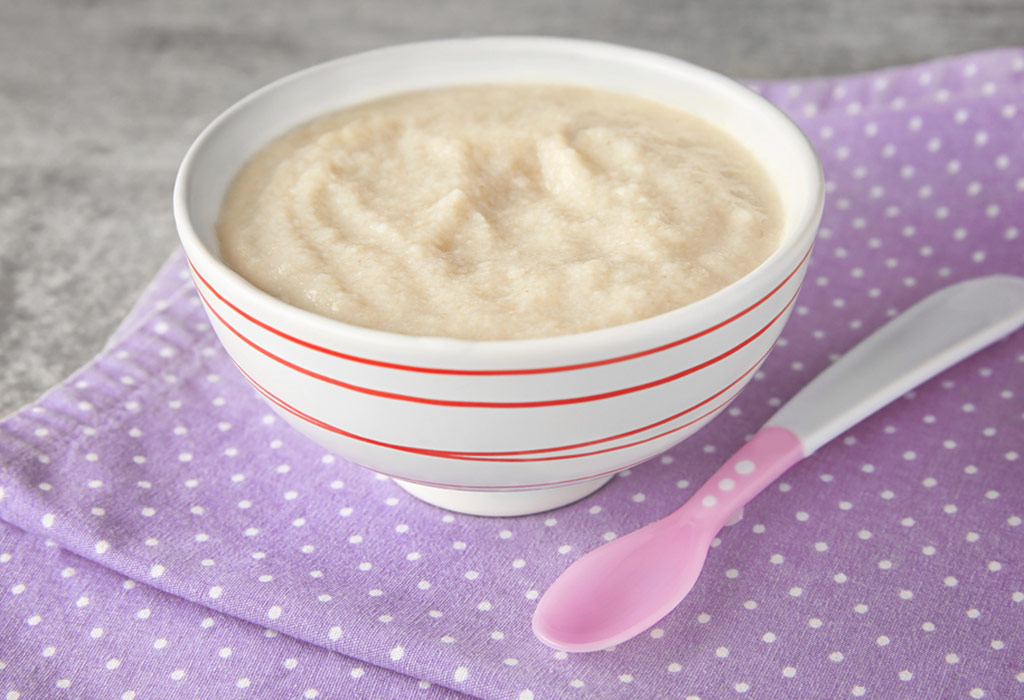

When your baby hits the seven-month mark, he gears up for some important physical milestones like sitting up, teething, etc. Providing the right kind of nourishment in this critical growth period is very important for the baby. During this time, the baby receives the essential nutritional supplements from both the breast milk/formula milk and from solid food. Here are some amazing options for healthy food for a 7-month baby that you can incorporate into your child's diet.
Video: Food Ideas for 7 Month Old Baby
https://www.youtube.com/watch?v=CEqJ0gePZBY
Best Foods for Seven Month Old Baby
After introducing a few solid foods to your baby at six months, you can slowly diversify the options and incorporate more variety in their food by the next month. Here are some interesting options for solid food for 7 month baby.
1. Fruit Puree
Fruits are a great source of vitamins, minerals and fibre. Fruits like apple, pears, papaya, banana, watermelon, avocado, etc. are great options for a snack or a meal.
2. Vegetables
Vegetables contain essential multi-vitamins and minerals. It can be given as a meal by steaming it and making a puree. Steamed vegetable wedges can also be given as an excellent snack.
3. Porridge
Porridges made from single grain cereals make for a great nutritional supplement for babies. Cereals like rice, wheat, oats, barley, millets etc. can be processed and powdered to make a porridge mix.
4. Meat Puree
Meat and chicken are high protein and carbohydrate foods that can be introduced to babies in the form of puree.
5. Egg
Egg is a popular source of healthy fat and protein. It can be given to babies as bite-sized pieces after boiling it.
6. Cheese
Cheese made from pasteurised milk is available widely in the market. It is a food rich in fat, protein and vitamins.
Quantity of Food Per Day
Typically, babies who are seven months old take three solid food meals and two snacks in between. Breastfeeding in the morning and night with some mid-day feeding sessions are also part of the routine.
Typically, babies consume about a quarter cup of puree or porridge in a single meal. Based on the demand, you can increase the quantity. Babies also consume an average of 800-900 ml of Breast milk or formula milk.
7 Month Old Baby Food Chart/Meal Plan
Following food, the schedule helps immensely in planning and preparing the baby meals. It also helps in incorporating a variety of recipes that balance the nutritional requirements of the baby. Here is a sample 7-month-old baby food schedule that you can follow to design your own chart.
Day of the week
Early Morning
Breakfast
Mid-Morning
Lunch
Evening Snack
Mid-evening
Dinner
Night
Monday
Breastmilk
or
Formula Milk
Oatmeal porridge
Apple
Porridge
Breastmilk
or
Formula
Ghee Rice
Yoghurt (Flavoured with fruit)
Breastmilk
or
Formula
Millet porridge
Breastmilk/formula milk before nap time
Tuesday
Pear Puree
Broken Wheat porridge
Lentil soup
Yoghurt with rice
Wednesday
Rice cereal
Rice with curd
boiled vegetable bowl
Rice porridge
Thursday
Wheat Pancakes
Fish Puree
Carrot badam kheer
Barely porridge
Friday
Lentil and rice puree
Carrot and sweet potato puree
Banana
Apple and pear puree
Food Recipes for 7 Month Old Infant
Many babies would have started having a tooth or two by seven months of age. Even if they do not have well-sprouted teeth, they would definitely have stronger gums which give them a tendency to chew on finger foods for a long time. Here are some homemade baby food recipes for 7-month-olds.
1. Wheat Pancakes
Ingredients
Wheat flour-1 cup
Jaggery syrup- ¼ cup
Water- as per requirement
Fennel seeds-1 teaspoon
How to Prepare
To the wheat flour add jaggery syrup and mix well.
Dilute with water to a semi-solid consistency
Add fennel seeds to the batter and mix. Allow it to rest overnight or for a few hours before preparing pancakes.
In a pan, grease with ghee and pour it in the shape of pancake.
Cook on both sides with ghee and take it out to serve.
2. Finger Millet Apple Porridge
Ingredients
Finger millet flour-1 cup
Apple- ½
Ghee-1 teaspoon
Water-as per requirement
How to prepare
Cut and peel the apple into small cubes. Steam it in water or in a pressure cooker and mash it well to a smooth paste.
In a pan mix the water and finger millet flour to a smooth paste and cook it in low flame till it bubbles.
To this mixture add the apple puree and cook further for five minutes.
Switch off the heat once it's cooked and add a spoonful of ghee.
3. Millet Porridge
Ingredients
Homemade millet powder-1/2 cup
Water- 1-2 cups
Breast milk/formula milk- ½ cup
How to prepare
In a vessel, mix the millet flour with water and stir continuously to make a smooth paste without lumps.
Switch on the heat and cook the mixture well till it starts to form bubbles.
At this stage reduce the heat and add the milk to bring it to the required consistency.
As an additional flavour, you can add the puree of any fruit to give it a sweetness.
4. Carrot and Sweet Potato Puree
Ingredients
Large sweet potato
Carrots
A pinch of cinnamon
Cumin seeds- ¼ teaspoon
Water
How to prepare
Chop the carrots and sweet potatoes into small cubes
Add to a pan with hot water and boil still soft
Mash the carrots and sweet potato mixture in a puree after draining out the water
Add a pinch of cinnamon for a zesty taste and serve
5. Pear Puree
Ingredients
Pear-1
Water/milk-1/4 cup
How to prepare
Clean and peel the pear.Cut the fruit into small pieces after taking out the seed.
In a pan of boiling water, cook the fruits for a few minutes with closed lid.
Mash the cooked pear with a blender or a mixie.
Add water or milk to the puree to bring it to the right consistency.
6. Lentil Soup
Ingredients:
Red lentils- 3 tablespoons
Carrot- 1
Onion- 1/2 an onion
Water- as required
Oil- 1 teaspoon
How to Prepare:
Finely chop the onion and carrot.
Heat the oil in a pan, on medium flame, add the onions and cook till translucent.
Add the carrots and sauté for 2-3 minutes.
Add the lentils to the pan.
Pour water till the lentils are covered and allow to boil.
Cook for 15-20 minutes until the lentils are soft.
Cool down completely, and puree into a soup consistency.
Warm it up before serving to your baby.
7. Carrot Milk Pudding
Ingredients:
Carrot- 2
Almonds - 5
Milk- 3/4th cup
Sugar- 3 tablespoons
How to Prepare:
Wash, peel, and cut the carrots in halves.
Add water and pressure cook for 2 whistles.
Once completely cooled, grind into a smooth puree.
Transfer to a pan, add sugar and milk, and simmer for 5 minutes.
Serve warm.
Feeding Tips
Here are some important tips for feeding your seven-month-old baby,
Do not force feed your baby. Different babies have different appetites and taste preferences. Look at the wet and soiled diaper count to determine if they are getting enough food. Supplement them with a generous amount of breast milk or formula milk to make up for the nutritional requirements.
When introducing a new food, always wait for three days. This gives time for the body to react to the food and also show symptoms of an allergic reaction. In a case where the baby has an allergy to a particular food, stop it for a few months and retry again.
Keep a dedicated place for having food, to establish proper eating habits. This habit, creates a connection between the place and food, in the baby's mind, making feeding sessions less strenuous for the parents.
Encourage the babies to explore food by giving them finger foods. At this age, babies tend to have a strong urge for biting and finger foods greatly help them soothe the gums. This also gives them a first-hand experience with the texture and taste of their food.
Avoid feeding with a distraction. This takes them away from the fun of enjoying their food.
Gagging or chocking is an important hazard in babies, especially when they eat food with lumps or when they chew off a large piece of finger food. Try to monitor the baby while he or she is eating and react immediately in the event of the baby having a chocking episode.
Clean fruits and vegetable properly before giving. Fruit and vegetable purees can be used as a snack option than as a meal. Try to avoid mixing milk with the fruit as it interferes with the digestion.
Clean and sterilise the utensils used for making baby food, as babies tend to catch infection very soon. Make use of a good food processor to prepare baby food without lumps.
Seven-month-old babies require a healthy and nutritious diet to fuel their growing body and brain. It is also a transitory phase where they start taking solid food and start developing their taste buds. Exposing them to as many vegetables and fruits will go a long way in establishing good eating habits.
8 Months Old Baby Food Ideas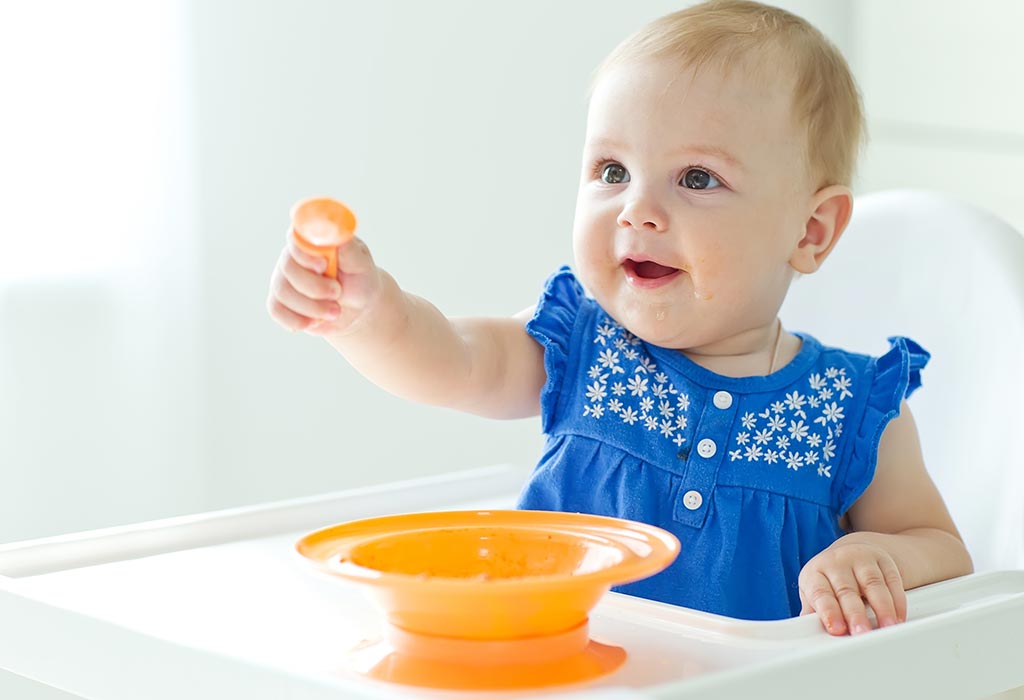

Your eight-month-old baby is at a very interesting stage of growth. With a tooth or two, your baby is grinning its way to become a toddler. By eight months of age, babies master the art of gulping down mashed food and even slowly start chewing on the foods which are more solid. Nutritious food that challenges their chewing skills will perfectly suit the dietary requirements of an eight-month-old baby.
Video: Food Ideas for 8 Month Old Baby
https://www.youtube.com/watch?v=ZlUV5s_InLg
Best Baby Foods for an Eight-Month-Old
A wholesome diet that comprises of the right quantity of carbohydrates, protein, vitamins and minerals is essential for a growing eight-month-old baby. There are many natural food substances that offer a right mix of these nutrients. Typically, food for an 8-month-old baby include one or more of the following.
1. Fruits
Fruits are an excellent source of a variety of vitamins, minerals and other micro nutrients. Apart from the regular fruits like apple, banana, papaya, pears, etc., you can additionally include some fruits like kiwi, strawberry, pomegranate, etc. Fruits that are cut in the shape of long cubes make for excellent finger foods for babies.
2. Vegetables
At eight months of age, your baby can move on from mashed vegetable puree to chewing on small cubes of steamed vegetables. A variety of vegetables can be incorporated into the baby's diet, by adding it to rice or by making a steamed vegetable bowl. Vegetables like cauliflower, broccoli, Asparagus,green peas, pumpkin can be slowly introduced into the diet.
3. Fish
Fish is a very nutritious food that can be given to babies as small as eight months. Fishes like tuna, salmon, hamour etc. that are rich in omega 3 fatty acids are very good for the growth and brain development of babies. Fish can be given to babies in the form of a puree or as soup.
4. Tofu
Tofu is made out of soy milk and cow's milk respectively. They are protein-rich and are very good for developing babies. Tofu can be used for babies who have an allergy to paneer because of lactose intolerance.
5. Chicken
Chicken is believed to be one of the healthiest foods for babies. It can be typically started at the age of seven months or more and is usually given as soup or as a puree. The broth or the juice in which the chicken is cooked is also a nutritious drink for babies.
6. Cheese
Cheese made out of pasteurized milk is a great source of calcium for growing babies. The processed cheese available in the market makes for a great snack for babies to munch on.
7. Egg
Egg is a wholesome food that contains both good fat and healthy proteins. An egg can be given to babies as a snack by boiling them and feeding them as bite-sized pieces. Some babies have an allergy to egg, and you must watch out for any warning signs of allergy in babies.
8. Yogurt
Thick yogurt made from cow's milk can be given to babies, especially in summers. There are many fruit flavoured yogurts available in the market that make for excellent snack options for babies. They not only provide good bacteria for the gut but also serve as a great source of essential vitamins and minerals.
How Much Food should a Baby Eat at this Stage?
Most often eight-month-old babies feed actively but sometimes get distracted away from food due to their newfound mobility. Babies who start crawling by this age, usually feed on the go as they show more interest in exploring the things around them. A typical eight-month-old baby follows a schedule that includes three solid meals and two snacks along with at least two sessions of breast or formula feeding.
Food Schedule
Here is a sample food schedule for an eight-month-old baby.
Morning- Wake up and nurse for a few minutes (About 200 ml)
Breakfast- 1 cup of puree or any breakfast
Mid-morning snack- half a cup of fruit/yoghurt/boiled vegetable
Lunch- 1 cup of cereal
Nap time
Evening snack- breastfeeding or formula milk (about 200ml)
dinner- 1 cup of porridge/puree/cereal
Night- feed to sleep
8-Month Baby Food Chart/Meal Plan
Here is a sample chart that you can use as a guideline for your eight-month-old baby.
Day of the week
Early morning
Breakfast
Mid-morning snack
Lunch
Nap-Time
Evening snack
Dinner
Night
Monday
Breast milk/ formula milk
Rice porridge
Carrot puree
Rice with dal
Cheese
Rice porridge
Breastmilk/ formula Milk before nap time
Tuesday
Oat meal porridge
Boiled egg
Rice with vegetable
Yoghurt
Whole wheat bread with vegetable
Wednesday
Meat puree
Apple puree
laban or yoghurt with Lentil puree/soup
Lentil soup
Millet porridge
Thursday
Broken wheat porridge
Banana
Idli with dal
Apple stew with cinnamon
Rice with vegetable
Friday
Fish puree
Vegetable soup
Chicken puree
boiled vegetable bowl
Rice porridge
Food Recipes for 8 Months Old Baby
Apart from the regular puree foods that your baby is now used to having, you can try some of these new recipes to tickle your baby's taste buds. Here are some interesting homemade baby food recipes for 8 months old
1. Brocolli Soup Recipe
Broccoli is nutritious and tastes delicious too. Here is how you can make broccoli soup for your baby.
Ingredients
Butter-1 teaspoon
Broccoli florets- 1 cup
Pepper powder- a pinch
salt- a pinch
How to prepare
Add butter in a pan and allow it to melt
Add broccoli to it and saute for a few minutes.
Cover the same and allow it to cook.
Once the broccoli cools, blend it to a fine paste in a blender.
In another pan, add a small piece of butter and ass the broccoli mixture to it. Allow it to cook and add salt and pepper powder to it. Feed the baby once it cools down.
2. Fish Puree Recipe
If you love eating fish, your little one will like it too. Learn the recipe of fish puree. It’s easy-to-make and tastes delicious!
Ingredients
Cleaned and prepared fish
water-1 cup
How to prepare
In a vessel add water and keep it on fire.
In another smaller vessel take some cleaned and chopped fish and place it inside the vessel containing water.
Allow it to cook. The colour changes to white on getting cooked completely.
Grind the cooked fish to a puree and add salt and jeera powder to taste and serve.
3. Apple Porridge Recipe
Finger millet is high in proteins, calcium, and iron. It also helps a baby gain weight and you know apples are always good. So include finger millet in your baby’s diet by making yummy apple and finger millet porridge!
Ingredients
Grated apple- 1 cup
Millet flour- 1 tablespoon
ghee- 1/2 teaspoon
water-1.5 cups
How to prepare
Take one cup of water and add the millet flour to it. Mix the contents well without lumps.
Switch on the heat and place the pan.
Stir continuously till you see the bubbles farming.
In this stage, add the grated apple pieces to the porridge.
Allow the apple and millet mixture to cook well. If the porridge becomes very thick, dilute it with water and bring it to the required consistency.
Once it is cooked, switch off the gas and add a drop of ghee before feeding.
4. Carrot Wedges Recipe
Ingredients
carrot cut into wedges- 1 cup
salt- a pinch
pepper powder- a pinch
ghee- 1 teaspoon
How to prepare
Cut the carrot into wedges and keep aside.
In a pan boil water and when it comes to boil, add the carrot pieces.
Allow it to cook to a biting consistency.
Add ghee and saute carrot pieces in a pan.
Add salt and pepper powder to it, to give taste.
Once it cools down, allow the baby to chew on it.
Feeding Tips
Breast milk or formula milk still remains as a primary food for eight-month-old babies. Besides the solid food intake, doctors recommend one or two sessions of feeding for babies up to one year of age.
Strictly avoid using cow's milk for your baby, until one year of age.
If there is a history of any food allergy in the family, especially for dairy products, egg, nuts, etc., watch out for any warning signs. Also, speak to your doctor about the possibilities of your child inheriting such allergies.
Avoid deep fried foods and try to incorporate more steamed fruits and vegetables.
Always feed the baby in a particular position and location every day. This develops a strong connection in their mind between food and the place of a feeding.
Keep the consistency of the food a little grainy and do not mash it completely. It greatly helps eight-month-old babies to transition from mashed food to solid food.
Avoid the addition of salt and sugar in food for babies within one year of age. Many doctors advice against the use of both, as it puts unnecessary stress on the kidneys.
Many eight-month-olds get easily distracted by food, as they develop mobility with crawling and are curious about things around them. During such phases of low food intake, try to feed small quantities with increased frequency.
Babies tend to gag or choke while nibbling on finger food. They sometimes accidentally bite off a large chunk of food. Parental attention is very important while your baby is chewing on solids.
Prepare and store baby foods in steel or glassware. Avoid the use of plastic as it contains harmful chemicals that have a likelihood of entering the food.
At eight months of age, babies move around quite a lot and spend a lot of their energy in exploring the things around them. To fuel their physical and mental activities, a healthy balanced diet is a must. Planning your baby's food chart well in advance and sourcing fresh fruits and vegetables can help in providing the best nutritious food to them.
9 Month Old Baby Food Ideas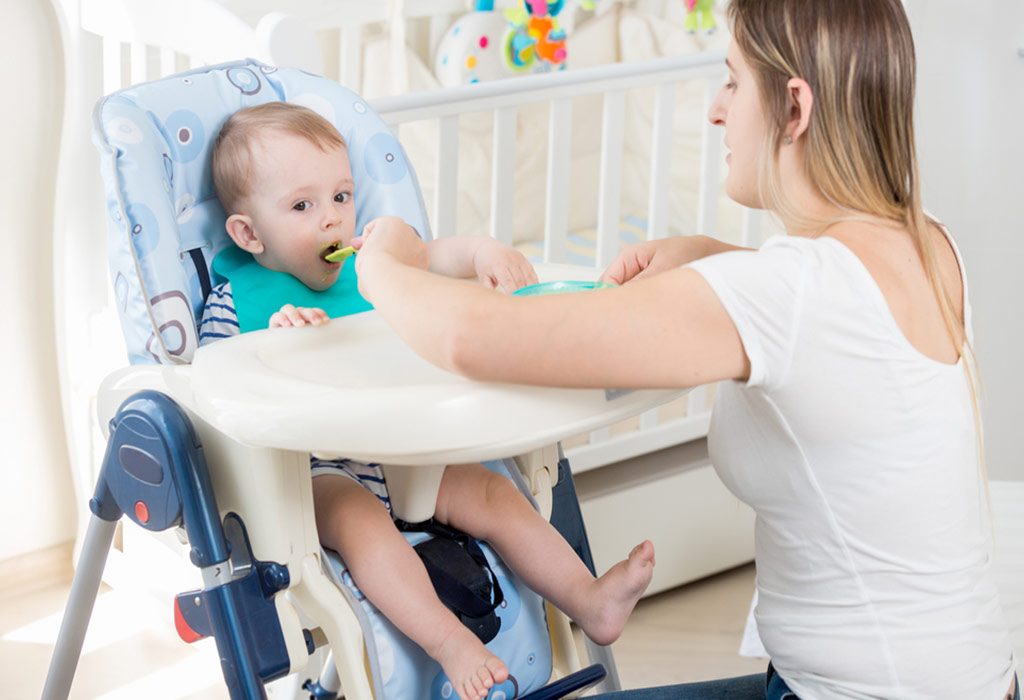

With thousands of options, multiple voices of advice, the initial stage of parenthood isn't the least bit easy. Amidst staying up all night and diaper duties, feeding healthy food to your baby may become daunting.
Here are various ideas, tips and recipes to keep you and your baby happy and content.
Video: Food Ideas for 9 Month Old Baby
https://www.youtube.com/watch?v=HEA7UsR0i8k
How Much Food Should a Baby Eat at this Stage?
While your baby may not be able to consume everything that you eat, their taste buds will be delighted with the introduction of new food and flavours. While it will be scary and troublesome for most new parents to figure out what to give and how much to give their child, know that there is no golden rule by which you must operate. Do not place unnecessary stress on the food itself and remember to keep it nutritious and as natural as possible.
Babies in this age category generally can have anywhere ½ tablespoon of an entire spoon. As the experience is new for your baby, he/she will nibble on the food, spit it out if they don’t like the taste. Remember that a baby’s tummy is the size of a person’s fist and it doesn’t take a lot to get them full. Also since their taste buds are still developing, they may not like all the different kinds of food you give them. Some of them will like vegetables, some will like fruits, and some will even determine what texture of food they like. It can be either in puree form or mashed or even small tiny chunks. Trial and error are crucial at this stage to understand your babies preference.
Don’t forget though that your baby is also getting all the nutrients required for a formula or breast milk. Make sure that your baby is eating three meals a day in addition to the milk.
Best Food for Nine Month Old Baby
Your baby will be adventurous or developing into becoming a fussy eater with the introduction of new food so make sure you pick the best and delicious tasting food for them.
Some of the food you can start with for your 9-month-old Indian baby is:
1. Fruits
Berries such as blueberries, melons, cranberries, dates and figs, cherries, citrus fruits cut into 1/4th their size can also be given to your child. Always ensure these are completed cooked and either pureed or mashed before serving your baby
2. Vegetables
Broccoli, Asparagus, potatoes, eggplant, cauliflower, mashed potatoes, onions, parsnips all which can be cooked and mashed
3. Meat and Egg
Eggs, chicken and fish which are thoroughly cleaned and cooked should be served. Do not give any raw meat or runny eggs.
4. Water and Juices
Your baby’s digestive system is still developing so make sure he gets plenty of water. Try making natural juices (no sugar) at home instead of processed juice.
5. Cheese and Other Dairy Products
Cream cheese, cottage cheese ghee, butter can be given in very small quantities to your baby.
6. Cereals
Cooked quinoa, millets, whole wheat pasta (softened), rice and oatmeal are tasty options to give your baby
7. Grains
Toast, small pieces of flatbread, crackers
8. Legumes
Mashed lentils, beans, soups made from legumes
9. Spices
As your little one’s taste enhances, try using small quantities of cloves, coriander, mustard, fennel, fenugreek, nutmeg, cinnamon, cardamom, bay leaf, turmeric, garlic while making their food.
9 Month Old Baby Food Chart/Meal Plan
Make sure your baby’s food is soft to prevent choking. Here is a detailed schedule of what you can give your child at meal times and as snacks:
Day
Breakfast*
Mid-Morning Snack*
Lunch*
Afternoon Snack*
Dinner*
Monday
Steamed pear puree
Veg Soup
Carrot and Sweet potato puree
Apple fingers
Homemade Cerelac
Tuesday
Apple and cinnamon puree
Boiled egg
Carrot and zucchini puree
Grape
Oatmeal porridge
Wednesday
Carrot and peas puree
Mashed potatoes
Cottage cheese and soft toast
Papaya
Wheat almond porridge
Thursday
Oats Pancake
Breadsticks
Plain rice
papaya mash
Finger Millet porridge
Friday
Rice cereal
Pumpkin sticks
Flavoured rice
Carrot fingers
Oats Apple Porridge
Saturday
Wheat cereal
Yoghurt
Vegetable puree
Frozen banana
Chicken soup
Sunday
Mashed banana pancake
Blueberries/cherries
Vegetable rice with tomato sauce
Sweet potato fingers
Brown rice cereal
*Source: https://www.mylittlemoppet.com/diet-chart-for-9-month-babies-2/
*Introduce small portions and then depending on your baby’s taste and appetite increase the portion. Never force your baby to finish the food
Food to Avoid
It is important to serve your baby clean and fresh food. Be alert and notice the texture of food which your baby prefers so that you can incorporate more of it into the next meal. While your child can now happily join you at family meals, here are a few foods that must be avoided at all times.
1. Honey
It contains bacteria that can cause serious illness in your child, by damaging the intestines and leading to a rare syndrome called infant botulism. It can also be damaging to a baby’s emerging teeth
2. Some Types of Fish
Shark, swordfish or marlin contain high traces of mercury which can affect a baby’s nervous system. Also, avoid shellfish to avoid food poisoning
3. Whole Nuts
Do not give whole nuts to your child until they turn Five, in order to avoid choking
4. Sugar
Sugary food is bad for your kids growing teeth. These include ice-creams, biscuits and sweets
5. Salt
Do not add salt to your baby’s food as the kidneys cannot cope and avoid salty foods such as namkeens, chips altogether. Babies should have less than 1 gm of salt a day
6. Citrus or Acidic Fruits
Some infants may suffer from acidity due to citric fruits. However, a dash of lemon is allowed in purees
7. Peanuts/Tree Nuts
This is sensitive food and may cause allergic reactions in your baby. It is typically introduced 1 year onwards.
8. Whole Milk
These can cause tummy issues and should also never be supplemented with breast milk. It can also hinder absorption of iron which is crucial to an infant’s growth
Can you Give your Baby Finger Foods and Snacks?
Nine-month-old babies are generally ready for finger food and snacks. They have what you can a ‘Pincer grasp’ a skill with which they can pick up small objects with their thumb and forefingers. If your baby has started picking up small objects with his/her fingers without any support and can chew small bites of food then it's time to introduce finger foods for 9 month old baby.
This can be cooked carrots, apples, pear, cucumber, that can be chewed well by baby teeth. Cut all of them into small, long shapes for your baby to hold and nibble on. Be cautious and never leave your child alone while they have finger food.
If your baby has still not picked up things with their fingers, waiting for a month or two before introducing finger food
You can include one or two snacks between meal times for your 9-month-old baby. Give small quantities of food at regular intervals can help weaning easy in the future. Make sure that this does not affect breastfeeding.
Homemade Baby Food Recipes for 9 Month Old
Here are a few recipes for you to whip up quickly to delight your baby at home.
1. Pumpkin and Thyme Puree
An easy and simple recipe which are full of beta-carotene, potassium and iron.
Ingredients:
1 small organic pumpkin
½ tsp of fresh thyme
1-2 cups of water, vegetable stock or breast milk
How to Prepare
Cut the pumpkin and peel away the skin. Scoop out all the seeds and then put it in a blender or food processor. Add water or vegetable stock till you get desired consistency. Start adding thyme and start blending more.
Once you have the puree, cook in a cooker for 10-15 minutes (1 or 2 whistles)
2. Quinoa and Banana Mash
Nutrition rich and dense meal which can be great for lunch or dinner
Ingredients:
1/2 banana
Pinch Cinnamon
3 Tbsp cooked quinoa
1 Tbsp whole milk yoghurt
How to Prepare
Mash the banana in a bowl. Separately cook 3 tbsp of quinoa with no oil in a separate pan with water (10-12 minutes). Add the cooked quinoa to the banana along with yoghurt and stir to combine the ingredients.
You can also add powdered cinnamon (a pinch) for taste. Serve cold.
3. Lentil and Rice with Vegetable Mix
An great recipe for your child, when you are first introducing rice and vegetables
Ingredients:
½ cup rice
½ cup kebtuk
1 cup mixed vegetables washed properly and chopped into small pieces (carrots, peas, potatoes and beans)
1 teaspoon ghee
A pinch of turmeric
½ tsp cumin seeds
chopped coriander leaves
How to Prepare
Clean the rice and lentil and soak in water for thirty minutes. Heat the ghee in a pressure cooker. Now add the cumin seeds till they crackle. Follow it with lentil and rice and then vegetables. All these can be sautéed, followed by a pinch of salt. Add water and pressure cook this for 3-4 whistles, till everything is well- cooked.
Mash lightly with a spoon.
4. Wheat Flour Porridge
Wheat Flour Porridge is a food recipe for 9 month old baby
Ingredients
2 teaspoon wheat flour
Butter
Sugar
Cardamom
½ tsp ghee
2 cups hot water
Formula or breast milk
How to Prepare
Heat ghee in a pan and add the wheat flour, butter, sugar and cardamom. Roast it, stirring continuously. Once the mixture is slightly roasted and gives off a nice aroma, slowly add hot water. Keep stirring to avoid lumps and bring it to your desired consistency. Your baby will love the smooth texture of ghee. Turn off the heat.
Once the mixture is a little cool, add milk to adjust the consistency and add flavour. You can add banana puree or apple sauce for sweetness.
5. Finger Vegetables
Finger foods for 9-month-old baby are perfect for a mid-morning or evening snack
Ingredients
1 Carrot
1 Pumpkin
1 Sweet Potato
1 Zucchini/ Cucumber
How to Prepare
Cut any or all of the vegetables into long slices which your child can grasp in their fingers. Steam them in a pressure cooker for 5-7 minutes. Serve hot.
6. Oats Pancakes
These pancakes are super easy to make and delicious, as well.
Ingredients
1/4 cup oats
1 medium banana
1/4 cup milk
How to Prepare:
Mash the banana in a bowl, and add the milk. Mix well and add oats. Mix until well blended. Heat up a pan and add 1-2 drops of oil. Add 3-4 tablespoon of the mixture, and let it cook on one side. After 30 seconds to a minute, or until slightly brown, flip and cook well. Serve warm.
7. Vegetable Soup
This is a comfort food, especially in the winters and monsoon, and easy to make for your baby.
Ingredients
1/2 carrot chopped
3-4 beans chopped
10 peas
1/2 tomato chopped
1/2 potato finely chopped
1/2 tablespoon ghee
Pinch of pepper
How to Prepare:
Pressure cook all the vegetables in 2 cups of water for 3 whistles. Let them cool, and blend into a smooth puree. Reheat the puree, add water if required, as well as the pepper. Serve warm.
Feeding Tips
Start by taking any solid food that you want to introduce to your child in a big spoon and give them little nibbles off the spoon.
All vegetables and fruits should be given to them at this stage but create a schedule and discuss it with your paediatrician before deciding. This can help avoid any allergies or reactions your baby may have.
Follow a ‘4-day rule,’ i.e. wait for 4 days before introducing a new food in order to check for allergies.
Time flies and soon your little nine month old will be walking and running. Make the most of this time by introducing healthy food habits and make it a foundation of their childhood.
6
10 Month Old Baby Food Ideas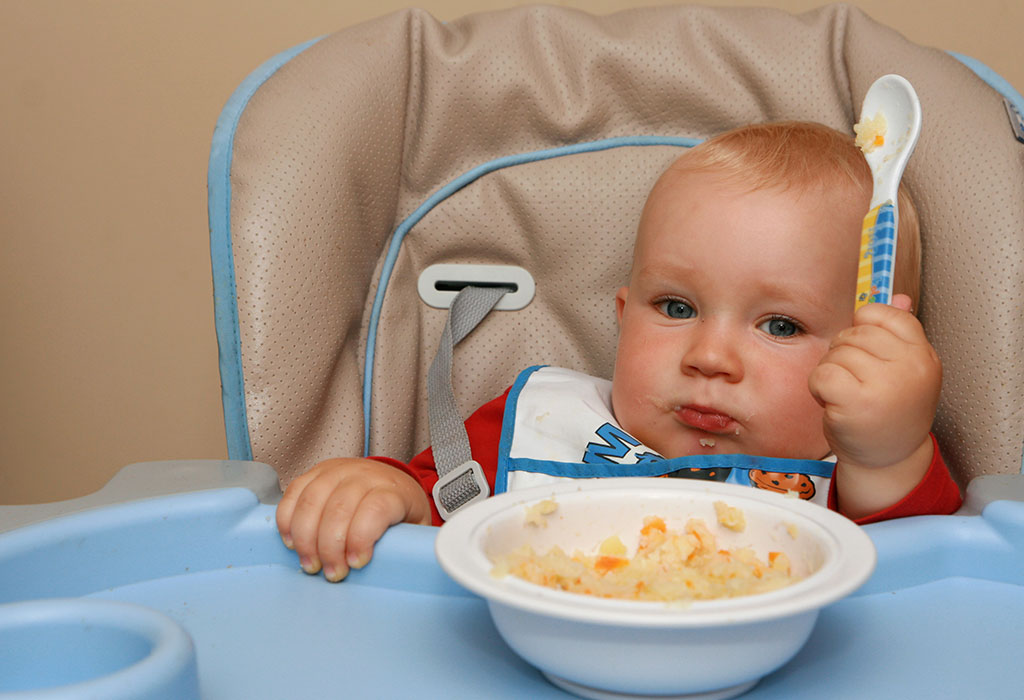

Having a baby for the first time is a reason for joy and happiness in everybody’s lives. However, this period can also be marked by uncertainties. Whether it is the food you are feeding your baby or health scares, there are many times when you will need guidance. Here we discuss how and what to feed a 10-month-old baby.
Video: Food Ideas for 10 Month Old Baby
https://www.youtube.com/watch?v=weS_5b6njk4
Nutritional Need of Babies at this Age
The amount of calories your baby will need at this age is entirely dependent on your baby’s weight. As a general rule of thumb, your baby will need anywhere between 90 to 120 calories per kilogram of weight. According to the experts, this translates to 793 calories for male babies and 717 calories for female babies. Your baby will need all the main food groups as you would. You can follow the basic food pyramid chart in order to understand the ratios of fruits, vegetables, and grains. Apart from this, you need to make sure that your baby is getting the adequate amount of calcium and iron in her diet. This is essential for her physical and mental development.
How much Food can your Baby Eat in a Day?
As with nutritional needs, the quantity of healthy food consumed will be dictated by your baby’s needs and appetite. However, as a general rule of thumb, you can assume that your baby will need the following quantities of food.
Between ¼ to ½ cup of cereal
Between ¼ to ½ cup of fruits
Between ¼ to ½ cup of vegetables
2 to 3 tablespoons of dairy
4 tablespoon of protein or meat
Best Foods for Your Ten Month Old Baby
One of the main things that you must remember is that at this age you will only be supplementing breast milk with regular food. So while you do continue to breastfeed, you can slowly start to replace a few meals with regular and solid food that also includes finger food. However, there is no hard and fast rule as to when you must stop breastfeeding entirely. This is a decision that you must make independently after consultation with your doctor. If you do decide to wean your baby, there are some of the best foods that you can give your baby.
Whole wheat porridge or bread
Rice and Chickken Stew
Rice with vegetables
Oatmeal porridge
Homemade milkshakes with fresh fruits
Boiled or scrambled eggs
Vegetable soup
Homemade fruit puree
Meat and fish puree
10 Month Old Baby Food Chart/Meal Plan
Here is a baby food chart that you can follow for creating a meal plan for your ten-month-old baby. However, it is recommended that you introduce each new food item one at a time. Wait for three days before you introduce another food item as it is the perfect window to observe if your baby has any allergies. This will also let her get used to the flavour. You can make some changes and develop a 10 month old baby food schedule that suits your baby.
Day of the Week
Early Morning
Breakfast
Mid-Morning
Lunch
Afternoon
Dinner
Late night
Monday
Breast Milk/ Formula
Cereal with grated apple
Cut papaya
Rice with chicken broth
Breast Milk/ Formula
Oatmeal porridge
Breast Milk/ Formula
Tuesday
Breast Milk/ Formula
Oatmeal porridge with banana
Banana slices
Vegetables, rice, and grilled fish
Breast Milk/ Formula
Chicken soup and toast
Breast Milk/ Formula
Wednesday
Breast Milk/ Formula
Egg yolks with toast
Grapes
Vegetable puree with Tofu
Breast Milk/ Formula
Bread with vegetables
Breast Milk/ Formula
Thursday
Breast Milk/ Formula
Millet porridge
Rusk
Rice with vegetables and wheat bread
Breast Milk/ Formula
Fruit puree
Breast Milk/ Formula
Friday
Breast Milk/ Formula
Cottage cheese sandwich
Cut melon
Rice and pumpkin curry
Breast Milk/ Formula
Rice with vegetables
Breast Milk/ Formula
Saturday
Breast Milk/ Formula
French toast
Steamed carrots
Whole wheat bread and vegetables
Breast Milk/ Formula
Rice and steamed fish
Breast Milk/ Formula
Sunday
Breast Milk/ Formula
Millet porridge
Steamed apples
Lentil puree
Breast Milk/ Formula
Sweet potato puree
Breast Milk/ Formula
Homemade Baby Food Recipes
Below are recipes that you can use when introducing healthy food for 10 months old baby. These recipes are full of nutrients for all-round development.
1. Semolina With Vegetables
Ingredients:
½ cup semolina
½ cup diced mixed vegetables like carrots, peas, beans, and boiled potatoes
1 cup water¼ teaspoon cumin seeds
A pinch of turmeric
A pinch of salt
¼ teaspoon oil or ghee
How to prepare:
In a pan, go ahead and roast the semolina until it gives a toasty aroma. Take care to stir continuously as it can burn quickly otherwise. Keep aside in a bowl. In a pan, heat the oil or ghee. Wait until hot and add the cumin seeds so that they crackle. Add the mixed vegetables along with turmeric and salt. Sauté for about 5 minutes. Add the semolina and water and stir continuously to ensure that any lumps are removed. Stir until desired consistency is reached. Be sure to keep the consistency a bit loose
2. Lentil Puree
Ingredients:
¼ cup pigeon peas or lentil
¼ cup rice
2 ½ cups water
One tomato, diced
¼ teaspoon oil or ghee
¼ teaspoon cumin seeds
A pinch of asafoetida or hing
¼ inch ginger piece kept whole
Salt to taste
How to prepare:
Wash and clean the lentil and rice until the water runs clear. Put the rice for 30 minutes in water. Do the same with the lentil. Drain the lentil and rice and place it in the cooker with the water and turmeric and cook until done. We add more water in order to keep the cooked food watery. Once the lentil and rice are cooked, and the cooker cools heat the oil or ghee in a pan. When the oil starts to shimmer, add some cumin seeds. Add the hing, ginger, and tomato and sauté for a few minutes, around five minutes. Add the cooked rice and lentil mixture along with all the excess water. Add salt to taste and let the mixture boil for a few minutes. Keep the consistency lightly watery. You can remove the ginger piece as your baby will not like its taste.
3. Scrambled Eggs
Ingredients:
One egg
2-3 tablespoons of whole milk or formula or breast milk
1 tablespoon grated fresh cheddar cheese or any other fresh cheese
1 teaspoon olive oil
Salt to taste
Pepper to taste
How to prepare:
Crack open the egg into a bowl. Add the milk and whisk for a couple of minutes. Then add the grated fresh cheese and mix. Heat the pan with the olive oil. Stir the egg mixture continuously until the eggs are fully cooked. Check for salt and season accordingly. You can also add some finely cut vegetables for a variation in flavour.
4. Chicken and potato soup
Ingredients:
½ cup peeled and diced potatoes
½ cup diced chicken
½ cup diced onion
½ cup fresh grated cheddar cheese
2 garlic cloves
2 tablespoons butter
2 cups water
Salt to taste
Pepper to taste
How to prepare:
In a large pot, heat the butter. Once simmering, add the onions and cook until they turn transparent. Add the garlic and sauté for a couple of minutes. Add the potatoes and let it get some colour from cooking in the butter. Add the water and bring to a boil. Add the cheese bit by bit while continuously stirring. Bring to a boil once again and add the diced chicken. Cover the pot with a lid and let it cook for 10 minutes until the chicken is fully cooked. Season with salt and pepper according to taste and the soup is ready. If you have cut the potatoes and chicken small enough, your baby might like to eat them like it. However, if you think your baby is finding it difficult, then you can use an immersion blender and make the soup into a smooth consistency.
5. Couscous wheat porridge
Ingredients:
¼ cup broken wheat or couscous
1 cup water
1 teaspoon roasted almond powder
Apple or banana puree
How to prepare:
Place the broken couscous and water in a cooker and cook for three whistles. Once the cooker cools completely, transfer its entire contents into a blender and mix into a smooth consistency. Put all the contents into to a bowl and add the almond powder and mix. Add the banana or apple puree for sweetness.
Feeding Tips
Make sure that you sterilize the cutlery your baby uses by submerging them into a vessel filled with hot water for at least five minutes.
Be sure to taste the food before you give it to your baby to ensure that it is at the right temperature.
Avoid salt as much as you can. Instead, you can get the flavouring from food sources like cheese.
Be sure to adjust the ingredients according to what your baby likes to eat.
Only introduce one solid baby food at a time.
Keep a lookout for symptoms of allergy for up to three days after introducing a new food.
Feed your baby with breast milk on demand. This is apart from the timings mentioned in the chart above.
Be sure to consult with your paediatrician before introducing any new food.
Feeding a 10-month-old is a period of experimentation. As your baby begins to distinguish between flavours and starts to have favourites, you will be able to develop meal plans that your baby truly enjoys. Keep the food pyramid in mind when planning meals and be sure to consult with your paediatrician on what you can and cannot feed your baby.
11 Months Old Baby Food Ideas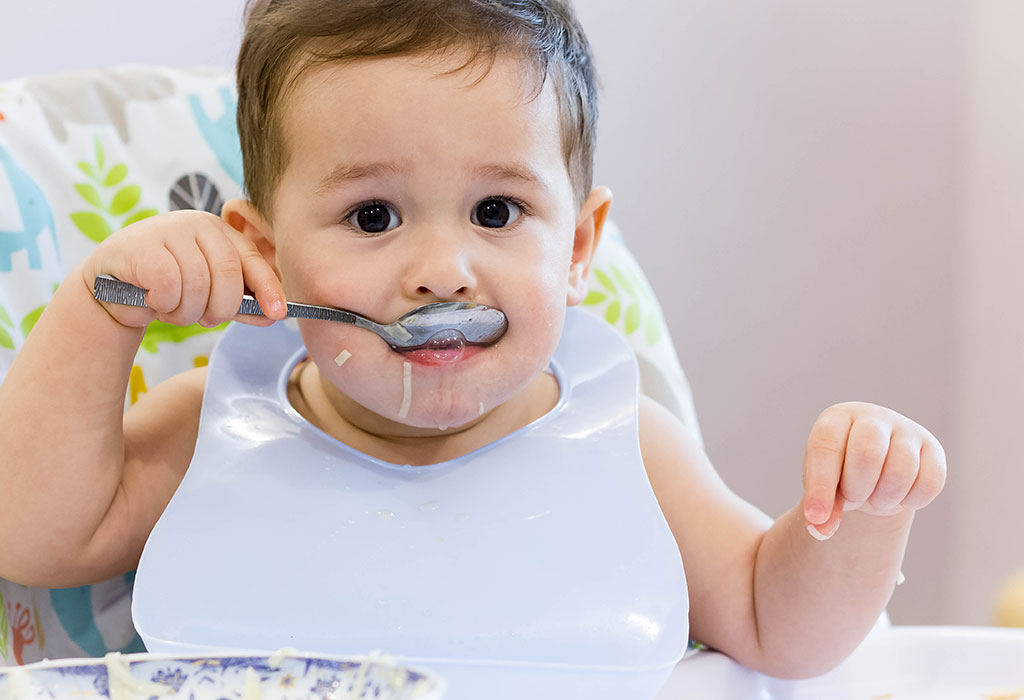

By the time your baby is 11 months old, he is likely to be able to eat on his own. You can give your baby the same food as the rest of the family after mashing it or cutting it into small pieces to help him chew and digest it better. Be sure to watch over your child during meal and snack times to make sure he does not choke on any food.
How Much Can a Baby Eat at This Stage?
By the time they are 11 months old, most babies can eat a wide range of items like fruits, vegetables, and meat. Three meals and a snack alongside formula or breast milk are what an average 11-month-old baby needs each day. The meal and snack timings will depend on your baby’s daily routine as well as yours.
How Much Quantity Per Day?
Your baby’s appetite will vary depending on his level of activity and his growth spurt to a large extent. The following is an approximate estimation of the quantity of food your baby needs each day:
Up to half a cup of cereal
Up to half a cup of vegetables
Up to half a cup of fruits
Up to 3 tbsp of dairy
Up to half a cup of mixed cereals
Up to 4 tbsp of meat or other proteins
How to Check If Your Baby Is Getting Enough Breast Milk or Formula
While feeding your baby, a few concerns are bound to creep up every now and then. You might wonder if your child is getting enough milk or formula every day – here are some ways in which you can assess this:
Breastfed Baby:
If your baby appears content after every feed, it is an indication that he is getting enough milk.
When you experience a let-down, it is an indication that breastmilk is being replenished on a regular basis.
Check your baby’s urine and see if it is clear and odourless. That is a sign of a well-fed baby.
Your baby has regular bowel movements.
Formula-fed Baby:
Convert your baby’s weight into pounds and multiply it by 2 and 2.5 to get two values that will be considered as lower and upper ranges for the amount of formula your baby needs each day.
As your baby approaches his first birthday, the formula feed is likely to decline to just one big feed per day.
See if your baby wets a minimum of six diapers in a 24-hour period.
Best Foods for Your Eleven-month-old Baby
It is important to cultivate healthy eating habits in your baby right from an early age. So, keep a watch for any possible allergies and introduce your child to all kinds of foods.
1. Fruits
A great source of vitamins and minerals, fruits should be an integral part of your baby’s daily diet. From apples to oranges to bananas and pears, let your baby try everything.
2. Poultry and Fish
Packed with proteins, fish and chicken can be extremely helpful in your child’s brain development and growth.
3. Cheese
Different types of cheese like cottage, cheddar, ricotta, and goat cheese can enhance the taste of your baby’s meals while satisfying daily protein requirements.
4. Pulses and Grains
Everything under this category can be offered to your 11-month-old baby. Switch between grains and pulses to give your baby some variety during mealtimes.
5. Dairy Products
Dairy items like yoghurt and curd are good for infants. Refrain from feeding your baby cow’s milk – that can be given only after the age of 1 year.
6. Leafy Greens
Leafy vegetables, especially greens such as spinach and fenugreek are particularly beneficial to babies as they contain iron.
7. Vegetables
All kinds of vegetables are good for your baby. Make it a point to use three different vegetables – one at every meal – every day.
8. Eggs
Eggs, especially the yolk is good for babies at this age. It is also easy for them to eat and digest.
11-month-old Baby Food Chart/Meal Plan
Here is a sample meal plan for an 11-month-old baby:
On Waking Up
Breakfast
Morning Snack
Lunch
Evening Snack
Dinner
Late Night
Monday
Formula/Breast milk
Healthy Cereal
Pieces of Apple
Rice With Vegetables
Formula/Breast milk
Chicken or egetable soup with toast
Formula/Breast milk
Tuesday
Formula/Breast milk
Millet and lentil porridge
Banana Slices
Couscous porridge
Formula/Breast milk
Broken Wheat Porridge
Formula/Breast milk
Wednesday
Formula/Breast milk
Banana Pancake
Sweet Potato Wedges
Lentil puree and Other Gravy
Formula/Breast milk
rice and vegetables puree
Formula/Breast milk
Thursday
Formula/Breast milk
Apple and cinnamon pancake
Mashed Papaya
Rice With Fish stew
Formula/Breast milk
Mashed potatoes with meat
Formula/Breast milk
Friday
Formula/Breast
milk
Egg Yolk on Toast
Stewed Pear
Chicken With Vegetables and rice
Formula/Breast milk
Rice and gravy
Formula/Breast milk
Saturday
Formula/Breast
milk
Broken Wheat Porridge
Rusk/Teething Biscuits
Beef puree with rice and steamed vegetables puree
Formula/Breast milk
Couscous porridge
Formula/Breast milk
Sunday
Formula/Breast
milk
Cheese sandwich
Melon Cubes
Mashed potatoes with meat puree
Formula/Breast milk
Baked veggies with mashed potatoes
Formula/Breast milk
Homemade Baby Food Recipes
1. Semolina Halwa
Ingredients
½ cup semolina
1 cup of water
½ tsp powdered cashews/almonds (optional)
½ tsp ghee
1 date, pureed
How to Prepare
Warm the ghee in a pan and then roast the semolina in it. Keep stirring to avoid burning. When the semolina turns aromatic, add the water and date puree. Stir to prevent lumps, and if you are using the powdered dry fruits, you can add them in at this point. When the semolina appears cooked, turn off the heat. Keep the consistency of the halwa a little thin as it will thicken further while cooling.
2. Spinach and Cottage Cheese Pasta
Ingredients
1 cup pasta (penne or macaroni)
1 bunch spinach
1 cup grated cottage cheese
Water as required
Salt if required
How to Prepare
First, cook the pasta and ensure it is soft enough for your baby to eat easily. You can also mash it lightly if you want. Wash the spinach well and boil it for a while. Add the cottage cheese to it and cook for a few minutes till the raw smell and taste disappear. Cool this mixture and grind it to a smooth paste with a little water. You can also add in a little salt if required. Mix this with the pasta and serve it to your baby.
3. Creamy Carrot and Sweet Corn Rice
Ingredients
¼ cup chopped onion
½ cup boiled sweet corn
¼ cup carrot peeled and chopped
½ cup of rice
1 tbsp butter
A bay leaf
A pinch of pepper powder
Water as required
How to Prepare
Heat the butter in a pan and sauté the onions in it until translucent. Add the cooked and boiled corn to this. Next, add the chopped carrots and pepper. Sauté for a while and turn off the heat. You can cool this and roughly or smoothly grind the mixture depending on your child’s preferences. Boil water to cook the rice and add the bay leaf. Cook the rice till it is soft enough for your baby to eat. Stir in the mixture and remove the bay leaf. Serve it warm to your baby.
4. Apple Chicken Nuggets
Ingredients
1 egg yolk
1 apple- peeled and grated
1 clove of garlic
1 cup chicken minced or ground finely
A pinch of pepper
A pinch of thyme, finely powdered
Some oil to grill/fry
How to Prepare
Mix the listed ingredients except for the egg yolk. Then shape the mixture into small nuggets. Beat the egg yolk well and brush it on the nuggets – you can also dip the nuggets in the beaten egg yolk. Shallow fry or grill the nuggets till the chicken is cooked well. Using olive oil can make the nuggets more crispy and flavourful.
5. Red Kidney Bean Soup
Ingredients
1 small onion, chopped finely
½ cup red kidney beans soaked overnight
2 cloves of garlic, finely chopped
1 small tomato- finely chopped
2 tsp lemon juice
1 tsp butter
A pinch of black pepper powder
Salt if required
Water as required
How to Prepare
Place a pressure cooker on heat and melt the butter. Add the chopped garlic and sauté it for about a minute. Then put in the onions and stir fry till they become soft. Then add the chopped tomato and sauté till it becomes pulpy. Add the soaked red kidney beans to this and sauté for a few minutes. Pour in two cups of water and cook the beans well in the cooker till they are soft enough to mash. Blend the mixture to a soup consistency and boil it. Add the lemon juice and pepper along with some salt if you want. Serve in a bowl.
Feeding Tips to Feed Your Eleven-month-old Baby
Compiling an 11-month-old baby food list and using it as a reference can simplify things for you.
Sterilise utensils like spoons, plates, bowls and glasses that you will use to feed your baby. You can immerse these in hot water for a few minutes and take them out when you are ready to serve the food.
Every time you introduce a new healthy food, be sure to keep an eye out for any signs of allergies. Also, be sure to give a gap of at least three to five days before introducing the next new food and only introduce one food at a time.
Try to avoid sugar and salt in your baby’s food at least until the first birthday. Cow’s milk and honey are also not advised unless your baby turns one.
Be sure to supplement your baby’s solid feeds with breast milk or formula based on your child’s demands.
Check with your paediatrician if you have any concerns about your child’s feeding habits.
Your baby is growing up fast and starting to explore the world around him. So, this is the right time to introduce your baby to new foods one at a time and gradually get him to eat what the family eats. Just ensure that the food you offer your child is as healthy and home-cooked.
Food Ideas for 1 Year Old Babies

The average age for teething in children is between six to twelve months. With teeth, comes the ability to crunch and chomp down new, solid foods. But what exactly can you feed your baby?
Foods for your Twelve Month Old Baby
There is no need to stress about preparing special food for your one year old. Whatever the rest of your family eats can be eaten by them too. You only need to take care to avoid as much salt in the food as possible. Of course, this does rule out most take-away and restaurant food, as they usually contain a lot of salt.
1. Cereal
All time classic! Cereals like flaked corn soften with milk and are easy to digest. Try to get whole grain cereal, as much as possible.
2. Cucumber
Cut up cucumbers are a rejuvenating snack anytime of the day. For your baby’s ease, the best way to cut them is lengthwise, making “cucumber-sticks” shaped like French fries. If it’s a hot summer day, a few cucumbers can easily prevent dehydration.
3. Lentil
Lentil is packed with protein, which helps in muscle development. Lentil can be eaten with rice or as a soup and it doesn’t have a strong flavour.
4. Vegetable Soup
This is easy to feed your one year old and it contains the goodness of all the vegetables you add in it. For instance, carrot soup would be good for the eyes, and potatoes contain fibre.
5. Soya
Soya granules are quickly becoming a standard substitute source of protein for pure vegetarians. The soft texture it becomes after cooking makes it an ideal food choice for babies.
6. Whole Wheat Break
A regular food for the family that can easily be eaten by the baby, too. A sandwich of vegetables or cheese makes it a balanced meal.
7. Chicken
Be careful to buy organic chicken, or chicken that is certified to be free of hormonal treatments. Over cooking the chicken to make it softer is a good idea for your toddler. Also, avoid strongly spicy flavourings, and tear the cooked meat into tiny bits, removing the bones before your feed it to your child.
8. Fish
When preparing fish, always remember that frying it makes it lose a lot of its nutritional value, as opposed to using it in a sauce. Like chicken, and indeed, more so, be very careful to tear off the meat and make sure no bones remain, before you feed your child with it. Even the fine bones found in sea fish can get stuck in a toddler’s throat.
1 Year Old Baby Food Chart/Feeding Schedule
When planning your 12 month baby food schedule you do not have to go out of the way from your usual foods. If your weekly eating pattern has turned monotonous, this may be a good time to add a bit of colour to it, as your baby and you, both, need a well-rounded, balanced diet. Here is a sample baby food chart:
Starter
Breakfast
Second Breakfast
Luncheon
Afternoon
Dinner
Late night
Sunday
Breast Milk / Formula
Banana pancakes
Watermelon Scoops
Chicken with vegetable stew
Cheese pieces
Barley Porridge
Breast Milk / Formula
Monday
Breast Milk / Formula
French Toast
Banana slices
Pasta Bolognese
Bread rolls
Cottage cheese on toast
Breast Milk / Formula
Tuesday
Breast Milk / Formula
Egg Sandwich
Fried Apple rings
Creamy chicken with avocado
Apple slices
Lentil Soup with croutons
Breast Milk / Formula
Wednesday
Breast Milk / Formula
Apple and Cinnamon Waffles
Cucumber sticks
Vegetable Noodles
Banana Shake
Cereal with milk
Breast Milk / Formula
Thursday
Breast Milk / Formula
Grilled Cheese and tomato sandwich
Mix of Berries
Steamed cod with Brown rice
Chicken curry rice
Cheese and bell pepper omelette
Breast Milk / Formula
Friday
Breast Milk / Formula
Fruit salad with yoghurt
Halved grapes
Homemade Chicken nuggets
Apple shake
Broccoli and cheese soup
Breast Milk / Formula
Saturday
Breast Milk / Formula
Oatmeal Porridge
Cereal with milk
Rice with fish
French Toast
Chicken soup
Breast Milk / Formula
Best Baby Food Recipes for 1 Year Old
Make sure you get the chance to prepare the following dishes for your young one :
1. Fried Apple Rings
A quick, sweet snack!
Ingredients:
1 Apple
1/4 cup flour
1/2 teaspoon sugar
Pinch of cinnamon
1/2 beaten egg
1/4 cup buttermilk
A pinch of salt
How to Prepare:
Mix flour, sugar, salt, cinnamon and set aside.
Mix egg and buttermilk in a separate bowl.
Slice the apple into 1/4 inch thick slices discarding the core.
Mix the 2 bowls and dip the apple rings in them and deep fry them.
You can also coat the fried pieces with powdered sugar for older kids!
2. Hummus and Pitta Bread
The high protein content in chickpeas and the carbohydrates in pitta bread make this a balanced way to start the day!
Ingredients:
1 15-ounce can chickpeas, rinsed.
1 clove garlic.
A quarter of cup olive oil, plus more for serving.
2 tablespoons fresh lemon juice.
2 tablespoons tahini (sesame seed paste; optional)
1 teaspoon ground cumin.
A pinch of salt.
1/4 teaspoon paprika.
How to Prepare:
In a food processor, puree the chickpeas and garlic with the olive oil, lemon juice, tahini (if using), cumin, and ¾ teaspoon salt until smooth and creamy.
Add 1 to 2 tablespoons water as necessary to achieve the desired consistency.
Transfer to a bowl. Drizzle with olive oil and sprinkle with the paprika before serving.
3. Cheese and Butter Pasta
A great source of calcium and carbs and one that is hard to refuse if you have a picky eater!
Ingredients:
Water
Fettuccine Pasta
Salt and pepper
Butter
Parmesan cheese
How to Prepare:
Fill a large pot with lightly salted water and bring to a rolling boil. Stir in fettuccine, bring back to a boil, and cook pasta over medium heat until tender yet firm to the bite, 8 to 10 minutes.
Drain and return pasta to pot.
Mix butter, Parmesan cheese, salt, and pepper into pasta until evenly combined.
4. Yogurt, granola, and berries
This simple treat is easy enough that toddlers can make it all on their own!
Ingredients:
1/2 cup Yoghurt
2-3 strawberries
4-5 blueberries
1 tbsp. granola
How to Prepare:
Chop the strawberries.
Scoop yogurt into a parfait glass, then top with granola and fruit. It’s that simple!
5. French Toast
A quickly readied snack suited for mornings and afternoons. Did you know that in most European languages other than English, the name for French toast, translates, literally, to “Poor Knights”?
Ingredients:
2 slices brown bread
1 egg
1 small pureed banana
½ cup milk
Oil
How to Prepare:
Mix together milk, pureed banana and egg.
Beat the mixture well to a runny consistency.
Heat the oil in a pan.
Dip bread piece into mixture and fry.
6. Barley Porridge With Banana
This semi-solid recipe is filling and yummy, and your little one is sure to enjoy this and, ask for seconds.
Ingredients:
1 cup barley
1 banana
3 cups water
How to Prepare:
Add the water and barley in a vessel and pressure cook for 5 whistles.
Release the pressure and check the softness of the barley. If it isn’t soft enough, let it simmer, until perfect.
Let this cool down completely and blend until smooth.
Chop the banana into bite sized pieces, add to the porridge, and simmer for 2 minutes.
Serve warm.
Feeding Tips
When using homemade baby food recipes for one year olds, do not be afraid to go for variety! Some doctors believe that staying with the same food for long can lead to them to become fussy eaters.
The “drawback” of going for a large variety of foods, is the increase in the possibility of your child ingesting some food that they may be allergic to. In most developed countries, allergy tests are a part of due medical process for babies. We would suggest you look into the options for the same!
Do not jump from liquid to solid food. Take it slow. Move from softer textures to semi-solid foods before going on to solid foods.
The best time of day to feed your baby solid foods is when they have just woken up in the morning or from a nap and are high on energy!
Do not disregard the advantage of having a high chair to feed a baby. Not only is your baby safe and secure, but it is ergonomically easier on your back too – much needed after 9 months of pregnancy and a year of picking up after your infant!
It’s never too late to create a taste for healthy food for your one year old baby. It can take up to 15 tries before a child tries a new food. So, if they didn’t eat their carrots on Monday, don’t hold back from trying on Wednesday, and even next week!
Don’t force feed anything to your child. It’s possible that they may not be hungry or just not enjoy a particular food. If they continue to refuse any particular food over a period of time, it’s okay. Just like you like and dislike certain foods, kids do as well.
Eating healthy isn’t a chore; it’s a habit. And there’s no better time to start eating healthy, than when you literally start eating.
13 Months Old Baby Food - Ideas, Chart and Recipes

A toddler of 13 months ideally requires optimum nutrition to cope with the needs of his growing body and increasing activity levels. By this time, he may have successfully made the shift from exclusively having milk to eating solids as well. Most toddlers by this age tend to become picky eaters. Their feeding habits are likely to change and get more unpredictable. They may seem to eat reasonably well on some days while other days they can appear completely disinterested in eating. Setting up a feeding schedule may help in restricting the unpredictability. Also incorporating a variety of healthy foods into your toddler’s diet may help in curbing possible picky eating and meeting his daily nutritional requirement.
Nutrient Requirements for A 13 Months Old Child
Some essential nutrients that are vital for your developing 13 months old child can be:
1. Protein
Your growing toddler may need 13 grams of protein per day. Protein is the building blocks which help in the formation and repair of tissues and muscles.
2. Carbohydrates
Carbohydrates are crucial for a toddler as they contribute to the healthy brain development and provide energy for the bodily functions. The daily requirement of carbohydrate for a toddler is about 130 grams.
3. Fat
Your infant may derive his dose of healthy fat from drinking 1 to 2 cups of whole milk and consuming full-fat dairy items daily to support muscle movement, the build-up of cells, blood clotting, mineral and vitamin absorption by the body. Fat also fuels your child’s body with energy.
4. Fibre
13 months old baby needs around 19 grams of fibre in a day which may help stimulate bowel function and prevent digestive troubles like constipation.
5. Iron
Iron intake of a toddler at this age should be around 7 mg per day. Most toddlers are prone to iron deficiency which can cause anaemia and negatively impact their normal growth and development.
6. Sodium
A toddler of 13 months may need approx 1 g of sodium (1/2 tsp of salt) per day to facilitate proper muscle and nerve function, maintain blood pressure.
7. Water
Your toddler of 13 months may require around 1.3 litres of fluids on a daily basis which includes milk, water, fresh juices and other healthy fluids to keep himself suitably hydrated.
8. Vitamins D
It helps the body in the absorption of calcium which is central for healthy bone development in kids. A developing toddler of 13 months may need 400 IU (International Units) of Vitamin D every day.
How Much Food does a 13 Month-Old Toddler Need?
Every toddler of 13 months can be different and may have diverse physical activity levels and his own specific needs. Parents need not calculate calories on a day-to-day basis to confirm sufficient consumption of food by their toddler. The more important thing to consider is that the child is gaining weight satisfactorily and remains active and energetic. Make sure your child has well-balanced and wholesome meals every day. Include green vegetables, starchy vegetables, fruits, cereals, protein, dairy products in his daily snacks and meals. Go in for whole foods which are home cooked rather than packaged processed food items.
Having said that the total sum of food a toddler may need from every food group depends on per day calorie requirements. Most toddlers usually need around 1000 to 1400 calories in a day. Also, it is important to comprise about 3 to 4 tsp of healthy oils like canola oil in your toddler’s daily intake.
Best Foods for Thirteen-Month-Old Baby
Some of the best foods for 13 months old baby can be:
1. Vegetables
Making your child get familiar with eating vegetables at an early age is very important. Vegetables are full of minerals, vitamins and fibre necessary for the healthy growth of your toddler. You can either cut raw vegetables like carrots, tomatoes and offer them as finger foods or cook them using simple recipes to produce tasty dishes.
2. Fruits
Different fruits can offer a host of health benefits for your infant. They are an excellent source of essential nutrients which are significant for the proper functioning and maintenance of his body. Encourage your child to eat one or more seasonal fruit daily. Alternatively, you can also prepare a colourful fruit salad with various fruits available.
3. Milk
Providing whole milk (full cream milk) to your child may not only ensure healthy bone-building but also cater to his body’s requirement of fat and Vitamin D. Keep in mind not to give too much milk every day as it can affect your infant’s intake of solid foods and lead to a possible iron deficiency.
4. Yoghurt
Plain yoghurt which is unsweetened and formed from whole milk comprising of live cultures may be the ideal choice for your toddler. Kids who are lactose intolerant can benefit from eating yoghurt and get their supply of fats and calcium. Yoghurt also boosts digestion and may prevent the occurrence of several common digestive disorders like diarrhoea.
5. Nuts
Nuts can be a beneficial addition to your infant’s diet as they are power packs of antioxidants, minerals, vitamins, healthy fats, fibre, protein. In case you fear that nuts can become a possible choking risk for your child process or ground them to powder and add them to his food. Make sure to check your child for any allergies to nuts before feeding him.
6. Chicken
Chicken can be a healthier meat choice to introduce to your baby’s diet. It is a good source of vitamin B complex, protein, iron, omega-6 fatty acids which may help promote body stamina and healthy haemoglobin count.
7. Legumes
Legumes like peas, beans, lentils can provide your baby with protein for muscle building, calcium for bone formation, magnesium for a healthy heart, iron for healthy energy and blood, fibre for good digestion. You can serve legumes to your child after boiling them gently or steaming them.
8. Eggs
Your toddler can tremendously benefit from eating eggs as they are a nutritious source of iron, protein, folate, omega 3 fatty acids, choline, vitamins A, B 12, D, E which may encourage his healthy physical and mental development.
9. Cheese
Cheese can constitute a healthy and balanced diet for toddlers as it provides protein, calcium, vitamin A and also fulfils their fat and energy requirements.
10. Whole Grains
Grains like oats, barley, brown rice can form an important part of your infant’s diet as they offer nutrients like fibre, protein, carbohydrates and an array of vitamins and minerals for his normal growth.
13 Month Baby Meal Plan
It may be challenging to establish a 13-month-old eating schedule because of their altering eating habits and changing food preferences. The following meal plan is simply a sample schedule which can vary depending on the specific needs of different toddlers.
Diet chart for 13 months old baby:
Food group
Daily Servings
Serving Size
Vegetables
1
1 bowl of cooked or finely chopped veggies
Fruits
2
An apple or banana or any seasonal fruit
Grains
Minimum 3
A slice of whole wheat bread, ½ cup cooked rice, 1 cup cereal
Protein
2
A cooked egg, 1-ounce poultry, 1/2 cup cooked legumes
Milk
2
1 or 2 cups of whole milk
Dairy products
2
2 ounces cheese, 1 cup yoghurt
Food Recipes for 13 Months Old Child
Here are some easy food recipes for 13 months old child:
1. Oatmeal Muffins
Muffins can be one of the quick breakfast ideas as they are easy to eat.
Ingredients
2 eggs
½ cup oil
½ cup milk
2/3 cup sugar
1 cup flour
¾ cup oatmeal
½ tsp baking soda
1 tsp baking powder
How to Prepare
Preheat the oven to 200 degrees Celsius.
Grease the muffin tray.
Whisk all the liquid ingredients together. Sieve all the dry ingredients and blend into the wet mixture.
Pour the batter into the muffin cups and bake for about 20 minutes.
2. Scrambled Eggs
This can be a simple way to provide your toddler with the goodness of eggs.
Ingredients
An egg
¼ cup milk
Butter
Salt
How to Prepare
Beat the egg and salt.
Heat butter and pour the egg mixture into a pan.
Gently fold, lift the mixture with a spatula to form soft curds.
3. Fruity Chicken Rice
For interesting dinner ideas you can prepare this yummy dish which may delight your baby with its varied textures.
Ingredients
¼ cup steamed chicken breast (shredded)
1 cup apricots
½ cup cooked rice
How to Prepare
Bring together all the ingredients and mix well.
Serve warm or cold.
4. Pasta
This delicious pasta with melted cheese can qualify for great lunch ideas.
Ingredients
1 cup pasta (boiled)
A tomato (diced)
Cheese (grated)
Oil
How to Prepare
Heat oil in a pan. Add the pasta and cheese.
Cover the pan with and let it cook till the cheese melts
Spread diced tomato on top and serve.
5. Carrot Coins
Your toddler may find these carrot coins too tempting to resist.
Ingredients
A carrot (peeled, cut into coins)
Olive oil
Salt (optional)
How to Prepare
Preheat the oven to 180 degrees
Place all the carrot coins on a baking tray.
Sprinkle salt and bake for 30 minutes.
Feeding Tips
Some useful feeding tips can be:
Creating a feeding plan can assist you to tackle your toddler’s various feeding transitions.
Keep in mind to include more table foods instead of baby food in your toddler’s meals.
Encourage your baby to self-feed. It may be a messy affair but this how kids learn.
While planning a 13-month-old food menu try to cover all the major food groups and bring in as much variety as you can using your creativity.
Limit sugary and processed foods to a minimum. You can offer them as an occasional treat.
Try introducing new foods regularly so that your baby gets a chance to develop a taste for different flavours and textures.
Parents can be a role model for their kids when it comes to developing healthy food choices and habits. Making mealtimes family fun time can motivate your toddler to eat well and healthier.
7
14 Months Old Baby Food - Ideas, Chart, and Recipes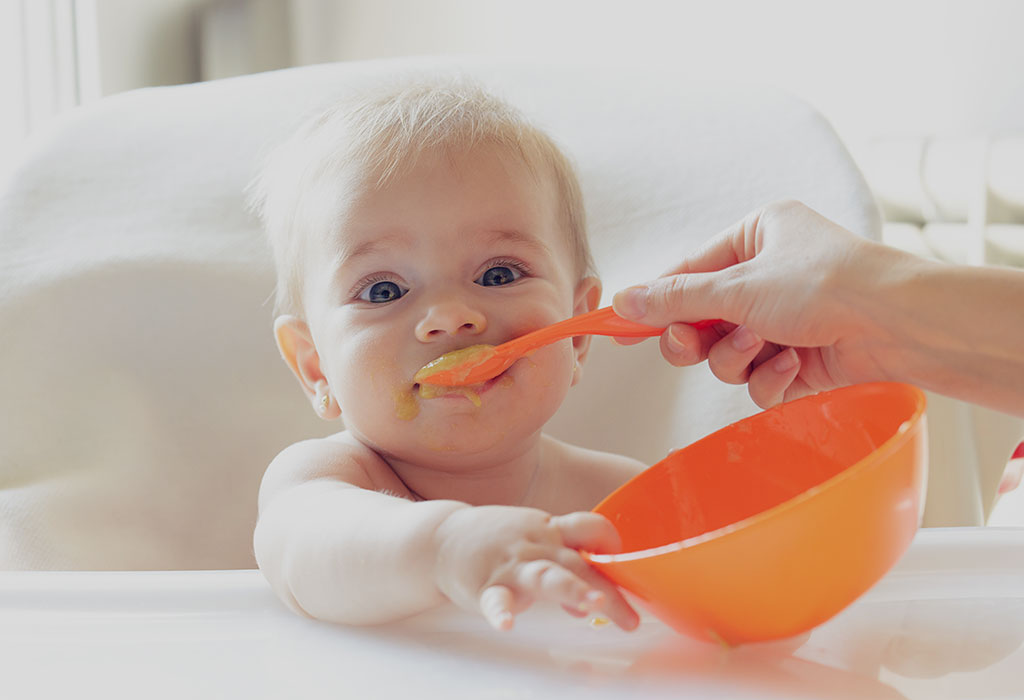

If your baby is going to turn 14 months in a couple of days, you must be looking for some food items that can be given to him, aren't you? But coming up with a 14 months baby food menu will not be an easy task for a parent. The feeding habits of your growing baby will have changed considerably since he turned one and now you will have to give it a lot of thought before giving anything to your baby because this is the age when a child starts being picky. While introducing new foods to your 14-month-old baby, you must make sure that those foods meet his nutrient requirements. Well, if you are all confused now, then read this article to know what you can give to your baby.
Nutrient Requirements of a 14-month-old Child
Your child is still in a growing stage and needs the best nutrition to keep his development on track.
1. Calories
Energy is the biggest requirement for kids who are 14 months old. Beginning with 1000 calories from the previous months, the daily requirement would plateau somewhere around 1200-1300 calories at this time.
2. Proteins
If your diet usually focuses highly on carbohydrates, this can leave the amount of protein on the lower side. But don' ignore it. A 14-month-old kid requires around 13-15 grams of protein on a daily basis.
3. Carbohydrates
Carbohydrates should be included in your child’s diet since they not only provide energy but give the brain all the support it needs to function and grow. Their requirement is the same as that of an adult, i.e. roughly 130-150 grams per day.
4. Dietary Fibre
Dietary fibre is important for your child's good health. It helps in digestion and ensures bowel movement. A child's daily intake of fibre from fruits and whole foods should be at least 19 grams.
5. Sodium
Sodium is one of the most vital nutrients required for our bodily processes. Kids need it too. A baby would need around 1 gram of sodium every day.
6. Iron
If your child has weaned, he needs to keep his iron intake optimal from other sources. With a 7mg daily intake of iron, your child will easily steer clear of any kind of iron deficiency.
7. Water
While most parents might not look at water as a nutrient, the requirement of water to keep the body’s electrolyte balance perfect cannot be stressed enough. Make sure your child drinks at least 1 litre of water throughout the day.
8. Supplementary Nutrients
Apart from the major ones, some trace substances are also necessary to support different areas of the body. Omega 3 fatty acids, DHA, probiotics, and many others can be included by adding variety to your meals.
How Much Food Does a Toddler Need At 14 Months
Before looking for breakfast ideas for your little one, it is important to know that a 14-month-old toddler won't eat as much as they used to before. Even though they are growing, their development rate is plateauing down to a fixed pace. A daily requirement of 1000 calories is usually enough for kids at this age.
Best Foods for a Fourteen-month-old Baby
To ensure that your 14-month-old baby gets the best nutrition, here are some popular food items that you can include in his diet without fail.
1. Breastmilk
Although many mothers might choose to wean their child from their breast, if breastmilk consumption is continued at this age, it is quite beneficial for the little one. Numerous antibodies along with enzymes and vitamins are easily provided via breastmilk and keep your kid healthier and protected from infection for a longer duration.
2. Meat
While choosing meat, it is necessary to opt for lean meat products such as fish or poultry for your kid. These can provide the required amount of protein for your kid’s age as well as introduce him to a tasty and delicious palate at the same time. Around 30g of meat should suffice.
3. Cheese
Kids love to eat cheese. It doesn’t have to always be paired with bread items or any fast foods. Include cheese with your regular vegetables or breakfast items for an added twist, and your kid will get enough calcium and proteins from it.
4. Beans
When giving beans to your child, mash them. These are a blessing for families that are vegetarian since they can provide a good quantity of proteins and vitamin C. Furthermore, synthesis of iron within the body is also supported by them.
5. Eggs
Eggs are highly recommended and one of the most popular choices for breakfast. Since there are so many ways to make eggs, your child will never get bored. Along with that, the presence of folate, vitamin B12, iron, and other nutrients make it the healthiest meal your child will have.
6. Juices
When we say juices, we strictly mean the ones prepared at home from fresh fruits. Don’t give your child the commercial juices that contain preservatives, sugar, or any sort of additional elements. Stick to only 180-200ml of quantity at the most.
7. Milk
Some kids are weaned off by the time they are 14 months, so they must drink around half a cup of milk on a daily basis without fail. Pairing it with some interesting food items can elevate the taste, and the fat from the milk can provide him with energy.
8. Vegetables
These form the very core of any meal for a child. Avoid giving raw vegetables to your child and choose to steam or boil them, making them soft. Opting for items of various colours would make the entire dish interesting for your child, and help him meet his vitamin intake properly.
9. Fruits
It is a great habit to eat a fruit after having a meal since they top up any missing nutrients that your body requires. Make sure the fruits are ripe when given to your kid. A 14-month-old child can have around a small cup of fruit quite easily.
10. Grains
The largest constituent present in a child’s meal are foods made from grains. Whole foods or even vegetable pasta can be tasty ways to include grains in his diet. Opting for bread made from whole wheat or including oatmeal in breakfast is highly recommended for kids to make sure that their nutrients requirements are met in an easy way.
14 Month Old Baby Food Chart/Meal Plan
If you’re struggling to prepare a meal plan or a diet chart for 14 months baby, here’s a simple one that you can use as a starting point.
Day
Breakfast
Snacks
Lunch
Snacks
Dinner
Monday
French Toast
Veg soup
Spinach with Rice
Glass of milk
Oatmeal porridge
Tuesday
Sweet potato puree
Apple chunks
Egg rice
Cheese sandwich
Rice cereal
Wednesday
Wheat pancakes
Smoothie
Chicken with rice and steamed purred vegetables
Glass of milk
Oats pancakes
Thursday
Peas & potato puree
Banana puree
Meat puree with vegetables
Beetroot cutlets
Oats and pureed fruit mix
Friday
Banana pancakes
Oats cookies
Veg rice
Apple and pear puree
Eggs on toast
Saturday
Cheese sandwich
Chicken muffins
Fish with steamed vegetables
Glass of milk
Pasta with pesto & cheese
Sunday
Rice and fruits cereal
Milkshake
Chicken stew with vegetables
Sweet potato and papaya mash
Cheese omelette
Here are some great food recipes that can be used for various meals throughout the day.
1. Vegetable Pasta
If your kid is bored of eating the same thing, surprise him with this vegetable pasta and watch him dive into it.
Ingredients
Olive oil
Black pepper
Mixed herbs
Mayonnaise
Ketchup
Pasta
Salt
French beans
Capsicum
Carrot
Tomato
Onion
How To Prepare
Take a pan and add water to it. Add salt and oil to it and let it boil.
Once it starts boiling, add the pasta and let them cook on a low flame.
Later, strain it out and wash with cold water.
Take olive oil in a large pan and add some onion and sauté it properly.
Follow up with tomato, beans, capsicum, and let it cook together. Then, add some carrots and let them get tender as well.
Finally add all the seasonings and condiments along with mixed herbs, ketchup, and mayonnaise. Cook this entire mixture for a few minutes.
Add the cooked pasta to it and mix it well. Serve warm.
2.Cottage Cheese Pancakes
This is an excellent and yummy way to include calcium in your toddler’s diet.
Ingredients:
Cottage cheese
Flour
Oil
Eggs
How to prepare
Heat a large skillet over medium heat, and coat with cooking spray.
Pour 1/3 capfuls of the mixed pancake batter onto the skillet and cook until bubbles appear on the surface.
Flip with a spatula and cook until browned on the other side.
3. Carrot Rice
Plain rice can be too bland for kids. Pep up the taste with one of these healthy lunch ideas.
Ingredients
Water
Ghee
Cashews
Almonds
Cinnamon
Sugar
Rice
Carrots
How To Prepare
Sauté almonds and cashews in a pan with ghee and place them aside.
Cook cinnamon in the same pan, along with carrots. Add some water to it and let it boil.
Once it does, add rice to it and cover the pan to cook it well. Sprinkle some sugar midway.
Stir it properly and garnish with the nuts sautéed earlier.
4. Vegetable Noddles
For kids that may or may not like noodles, this combo will definitely have them drooling.
Ingredients
Mustard seeds
Black pepper
Turmeric
Salt
French beans
Capsicum
Carrot
Ginger
Tomato
Onion
Noddles
How To Prepare
Take a deep pan and add water, salt, and ghee to it and let it boil.
Add the noddles and let them cook.
In another pan, add ghee followed by mustard seeds. Follow up with onions and tomatoes when they pop. Later, add the vegetables and let them cook.
Finally, sprinkle the condiments with some salt and add the noddles to the mixture.
5. Oats Pancakes
Make the weekend a fantastic one with these pancakes for breakfast or even for dinner.
Ingredients
Ghee
Water
Black pepper
Coriander powder
Salt
Turmeric
Onion
Carrot
Flour
Oats
How To Prepare
Put together carrots, onions, condiments, flour, oats in a bowl and mix them to form a batter.
Coat a pan with ghee and use the batter to make round shaped pancakes.
Cook both sides till they are brown and coat with ketchup, honey, or jam.
Feeding Tips
Here are a few tips to keep in mind before feeding your child:
Continue breastfeeding your child if you can.
Make sure you give tiny pieces of fruit or other food items.
Teach him to take small bites and chew properly.
Make him eat only when he is sitting up.
Do not make him sip juices or milk around bedtime.
Teach your baby how to use a cup.
Try these amazing recipes for your 14-month-old baby and he will eat it without any fuss. With a proper meal plan and a diet that covers all the necessary nutrients, you can know for sure that your tiny tot is developing in the right way.
Also Read: 15 Months Old Baby Food - Ideas, Chart and Recipes
15 Months Old Baby Food - Ideas, Chart and Recipes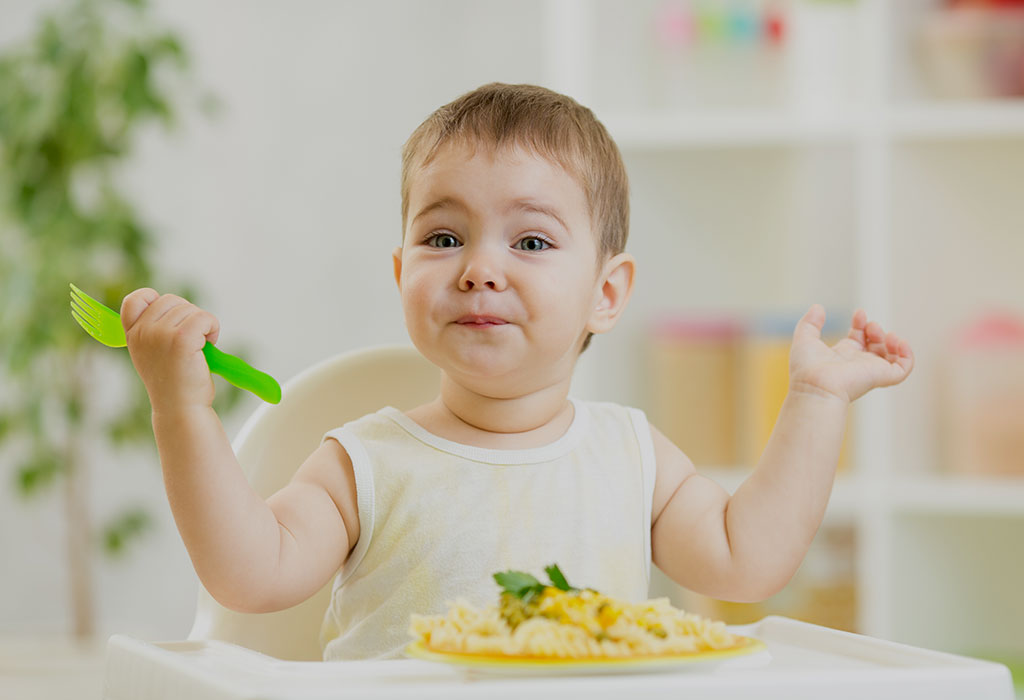

It is quite natural to completely run out of ideas for meals or even snacks for a 15-month-old child when you are used to a very typical meal schedule for yourself. The nutritional requirements for adults and kids are quite different and figuring out what food items can suffice them both can be quite tricky. This is where a proper meal plan and a simple schedule can be quite handy.
Nutrient Requirements for a 15 Months Old Child
The nutritional requirements for a 15-month-old child are all-encompassing. There is a necessity for all the major nutrients to be present in the appropriate quantities, even with reduced food intake.
Supporting nutrients
With reduced food intake, the chances of minor nutrients such as probiotics, omega-3 acids and others falling short in their required proportion are quite high. Therefore, a special focus is needed to ensure these are included in the diet.
Water
Including water, especially in the diet is highly recommended since most kids won’t remember to have as much water as they should. Roughly a litre of water is the least your child should drink in a single day.
Iron
The requirement of iron from other food items increases strongly as your child grows up, since his dependency on breastmilk, the primary source of iron, will begin to reduce. Make sure that he gets 7mg of iron daily from his food intake.
Sodium
The major food item that provides us with sodium is salt. While that might usually take care of the general requirement of a child amongst other food items, households that sparingly use salt should take extra care of this.
Fibre
Bowel movement and proper digestion are how your children can truly get the benefits that all the nutrients provide. Including fibre in the diet not only ensures this but also keeps the rest of the body functioning optimally.
Carbohydrates
The powerhouse of all energy, these form the core of any meal that your kid would have. There should be no compromise in the number of carbohydrates since there is a vast dependency of various bodily processes on it.
Proteins
Vegetarian families might worry about providing their kids with the necessary amount of protein they need. While meat does provide a substantial amount of protein, there are vegetarian alternatives providing good nutrition, too.
Calories
The growth rate of your kid might not be as rapid as it was during his early baby days. This results in a calorie requirement of around a kilocalorie or so, on a daily basis, which increases gradually over the years.
How Much Food Does Toddler Need at 15th Month?
Depending on your child’s physical activities and metabolism, a toddler’s food requirements stay within the range of 1000 to 1400 calories within the first few years. Hence, breakfast ideas and meal options need to strike a balance together to ensure proper nutrition for the child.
Best Foods for Fifteen-Month-Old Baby
Some specific food items make for great choices in giving your little one a wholesome meal that provides the necessary nutrition he needs.
1. Meat
It is important to know that little kids cannot have large pieces of meat such as steaks like adults do. The protein requirement for their age can be substantially satisfied by opting for lean meat alternatives, such as minced meat like a Bolognese sauce for pasta, soft fish, crumbled chicken, and so on. Precautions need to be taken when including seafood in their diet.
2. Legumes and Nuts
While eggs also make for a great meal choice to provide your kids with proteins and fats, vegetarians can rejoice with a better alternative in legumes and nuts. Giving nuts directly to your kid is not advised since it can be a choking hazard. However, using food items that contain nuts as an element shouldn’t be a problem.
3. Vegetables
Most kids will start eating their veggies around this age. Certain items might still be a bit difficult to chew, and those can be either boiled or steamed to soften them up. Avoid fried vegetables and opt for a variety that gives your kid a wider taste spectrum to enjoy.
4. Grains
Parents are suggested to go for whole grain varieties when choosing food items, as an easy way to keep up with the nutrient requirement of your child. These can exist in variants of rice and pasta as well. On the other hand, any fortified cereals free from artificial additions make for a great choice, too.
5. Fruits
Not only do fruits provide your kid with a different range of tastes as compared to other food items, but the presence of natural fibre in them also helps in stimulation of the digestive system as well as help in procuring different vitamins.
6. Snacks
While your little one might munch of tiny pieces of cookie or toast, it is best to avoid giving any sugar-heavy products early in life. Make use of cheese based items or steamed veggies to satiate the random cravings.
7. Oil
Even a 15-month-old baby requires fat, much more than anybody else. Those are the energy reserves that keep them going. Opt for oils that have no trans fats or go for alternatives like butter.
8. Dairy
A combination of protein and calcium is highly necessary for kids at this age since their bones and muscles need to be strong. Make sure you include whole milk and some yoghurt in your kid’s diet.
9. Juices
Although it is best your kids have fruits instead of juices, these still can be a great addition to his diet, but only when pressed fresh and absent of any additions. Don’t replace water intake with juices.
10. Multivitamins
The body constitution or family lifestyle might make a nutrient deficiency possible in a child. Such a scenario needs to be combated with a multivitamin that can supplement any dietary shortfalls.
15 Month Old Baby Food Chart/Meal Plan
Putting together a baby diet chart for 15-month-old kids isn’t an easy task. Referring to the one below, you can create your own that suits your child the best.
Day
Breakfast
Snack
Lunch
Snack
Dinner
Monday
Oats porridge with apples
Watermelon chunks
Cottage cheese sandwich
Orange pieces
Sweet potato and papaya puree
Tuesday
French Toast
Vegetable sticks
Lentils and rice mixed with green beans
Milk and cornflakes
Eggs on toast
Wednesday
Blueberry muffin
Cucumber and carrot chunks
Grilled Chicken with rice and veggies
Milkshake
Oatmeal porridge
Thursday
Sweet potato pancake
Potato fries
Noodles in chicken soup
Strawberry shake
Rice Cereal mixed with berries
Friday
Oats and fruits porridge
Cucumber & Tomato salad
Fish with rice and veggies
Yoghurt
Pasta Bolognese
Saturday
Cheddar sandwich
Strawberry chunks
Meat stew with veggies and brown rice
Banana milkshake
Apple and pear puree with yoghurt
Sunday
Apple and cinnamon waffles
Banana pieces
Beetroot and chicken with rice
Smoothie
Lentil soup with whole wheat bread sticks
Food Recipes for a 15 Months Old Baby
For parents struggling with unique meals or lunch ideas for their 15-month-old kid, these recipes can provide a quick escape as well as stoke their imagination to make some more.
1. Pasta
Let your child revel in delight as well when he comes across this weirdly beautiful recipe.
Ingredients
Milk
Rice flour
Green cardamoms
Jaggery syrup
Pasta
Water
How To Prepare
Take a pan and add water to it. Bring it to a boil, add the pasta to it, cook it, and drain it well.
In another pan, add ghee and butter with some cashews and roast them well. Follow up with milk and let it boil. Add the pasta to it and cook it all together.
In a cup, add milk, water and the rice flour. Mix it all properly till it is smooth. Pour it into the pan and stir continuously.
Once the kheer is thick, add cardamom seeds with jaggery syrup, and serve.
2. Roasted Green Beans
Do away with the usual boring snacks and add a great flavour to this healthy option that will make your child fall in love with greens.
Ingredients
Extra virgin olive oil
Sea salt
Green beans
How To Prepare
Start by heating the oven to a temperature of 425 degrees. Keep a pan inside it for 8-10 minutes.
Add the beans in a bowl and pour a little oil while sprinkling some salt. Toss them all together to mix it well.
Spread these beans on a sheet laid on the tray, without letting them cover each other.
Place them in the oven for around 10 minutes to make them crispy and soft.
3. Purple Veggie Puree
For kids that are bored with the same old purees, this vividly coloured version will have their eyes light up instantly.
Ingredients
Water
Lemon juice
Frozen spinach
Blueberries
How To Prepare
Take a pan and add water and spinach to it together. Bring it to a boil and let it simmer for 8 minutes.
Drain the water and mash together lemon juice, water, blueberries and spinach to form a nice thick puree.
4. Scrambled Eggs with Toast
This is one way your 15 month old will love to have eggs! Rich in calcium protein and fibre, it makes for a hearty start to the day.
Ingredients:
Eggs
Whole wheat toast
Milk
Butter
Salt and Pepper
How to Prepare
Break the eggs into a jug, add the milk and mix with a fork.
Melt the butter in a saucepan and pour in the eggs. Cook over a medium heat, stirring occasionally and make sure it is cooked through well.
Meanwhile, toast the bread and place onto warmed plates. Divide the egg between the toast and season with freshly ground black pepper.
5. Quinoa with Peas and Onions
Even if your toddler is a picky eater, this is a recipe for success!
Ingredients
2 cups water
1 cup quinoa, rinsed
1 small onion, chopped
1 tablespoon olive oil
1-1/2 cups frozen peas
1/2 teaspoon salt
1/4 teaspoon pepper
How to prepare
In a large saucepan, bring water to a boil and add the quinoa.
Reduce the heat; cover and simmer for 12-15 minutes or until water is absorbed. Remove from the heat and fluff with a fork.
Meanwhile, in a large skillet, sauté the finely chopped onion in oil until tender.
Add the peas; cook and stir until heated through.
Stir in the cooked quinoa and add a hint of salt and pepper.
Feeding Tips
With some simple tips, while feeding your kid, you can make the experience easier for you and better for the little ones.
Let your kid eat from the food prepared for your family as well, as long as it isn’t spicy
Start teaching your kid to eat certain items with his own hands
Don’t force your kid to finish up his food quickly
It is fine for your kid to eat intermittently than sit quietly for a full meal
Don’t fuss if your kid suddenly changes his eating habits
Make the entire experience of enjoying food items a fun-filled one
With numerous dinner ideas for your little kid at your disposal, your meals will take a new life of their own in the coming weeks. Observe your child and try to see what he likes and what he doesn’t, to balance out his meal schedule accordingly.
Also Read: List of 12 Healthy Weight Gain Foods for Babies & Kids
16 Months Old Baby Food - Ideas, Chart and Recipes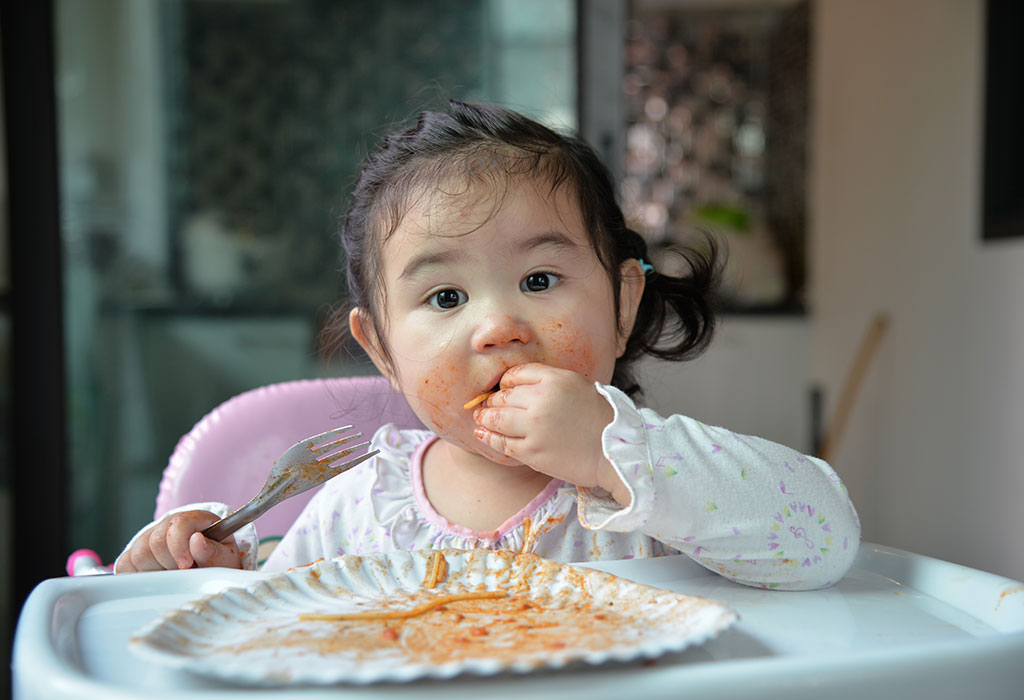

As kids start growing up, parents are constantly faced with a dilemma of figuring out what to feed them. He might have begun eating solid food items but the challenge of maintaining proper nutrition with a variety of food items that can appeal to him can seem like a circus act.
Nutrient Requirements for 16-months-old Child
Be it regarding breakfast ideas or any other meals, it is necessary that your 16-month-old toddler gets the right nutrients in the proportion that he ought to have.
Fruits: Fruits not only help in providing fibre but some very essential vitamins that can be absorbed by the body easily. A couple servings of fruits such as bananas, kiwis, mangoes, and many others are recommended.
Whole grains: These still remain an essential ingredient in the meal options that constitute a child’s healthy diet plan. Even a simple bagel or cereal crackers can be effective in providing enough grain proportion for a child.
Fats: Apart from being energy reserves to tap into, fats are what make your child healthier and larger in the coming months. Using olive oil in meal preparations or including coconuts and avocados provide good quantities of fat.
Vegetables: With solid foods being edible for your kid, it is necessary to expand the type of vegetables he consumes. Go with green leafy ones as well as broccoli and cauliflowers after steaming them. Sauces are a great accompaniment as well.
Meat and eggs: These are cheap, easy, and the best sources of protein for your little one. A simple egg, few pieces of shredded meat, or tiny chunks of seafood can be a great addition to your kid’s diet.
Iron: Apart from including iron-rich food items, it is also necessary to pair them with vitamin C rich foods, since it allows the iron to be absorbed within the body. Any leafy vegetables, red meats, and citrus fruits are a great combination to be included together.
Dairy: The weaning of the child from the breast makes it necessary to include fortified milk products in his diet to keep his nutrition intact. Different cheeses, yoghurt and full-cream milk are essential in that regard.
Nuts and legumes: The chewing ability of kids is put to great use by the inclusion of such items in the daily meals. Right from flaxseeds to peas or even peanut butter, a small serving of these on a regular basis is quite beneficial in the long run.
How Much Food Does Toddler Need At 16 Months
Toddlers experience a reduction in the pace of their growth when they turn 16 months old. While their nutritional requirements are pretty much the same, their calorie intake hovers roughly between 1kcal to 1.5kcal at the most.
Best Foods For Sixteen-month-old Baby
When putting together lunch ideas for your 16-month-old baby, there are certain essential food items that are considered the best choices to be included in his diet plan.
1. Porridge
Being a complete package of multiple nutrients such as proteins, carbohydrates and fibre, porridge is not only healthy but also quite filling for the little one, early on in the day.
2. Seafood
Yes, certain fish products do contain mercury and arsenic, making them harmful for the little one. However, fishes such as herring, mackerel and salmon are quite safe and contain enough omega-3 acids that benefit the brain development of the child.
3. Eggs
A simple food item that can provide a huge boost of energy is an egg. Prepare it in whichever form that suits your child, the healthiness in their constitution provides great taste and ready-to-use energy, which should ideally become a lifelong habit. (Avoid the semi-cooked recipes though - sunny side up, soft boiled eggs, and poached eggs.)
4. Beans
Beans are great for either breakfast or even evening meals since they are pretty light on the digestive system and provide enough vitamins, fibre, and iron to fulfil the child’s daily requirement. Preparing soups with legumes are also a great way to include them in the diet.
5. Vegetables
While eating steamed and boiled veggies is a great way to consume them, you can even make use of vegetable stock to provide him with the necessary immunity boost.
6. Poultry
Not only is chicken meat rich in protein, but it is also a great source of iron, which is necessary for kids at this age. Simple chicken recipes are not quite difficult to prepare.
7. Fruits
If your little one hasn’t started gorging on fruits yet, it is high time that he begins. Vitamins and minerals are not the only reason for it. The palate that different fruits provide, along with their smells and textures, help in evolving the taste buds of your child.
8. Yoghurt
Amongst many dairy products, yoghurt is recommended by dieticians and doctors alike. These can be paired with different food items to elevate their flavour as well as provide the benefit of probiotics entering his gut and enriching it to function properly.
9. Whole Milk
If you are still breastfeeding your child, then you are all set. But if not, start giving him full cream milk via a cup instead of a bottle. Drinking milk is extremely essential in keeping his growth on track, and keep his nutrient levels optimal.
10. Whole Grains
You don’t need to resort to the typical grain preparations when giving to your child. These can be acquired from a variety of items such as bread, muffins, sandwiches and so on. Make sure different options are included in his meal pan regularly.
16 Month Old Baby Food Chart/Meal Plan
To help you get started by putting together a 16-month-old baby food schedule for your own kid, we have provided a sample that can be used as it is or even tweaked to better suit your lifestyle.
Day
Breakfast
Snack
Lunch
Snack
Dinner
Monday
Banana pancake
Oats biscuits
Pasta
Glass of milk
Cottage Cheese Sandwich
Tuesday
Oatmeal porridge
Blueberry muffin
Chicken with rice and veggies
Fruits and Yoghurt
Veggie cheese quiche
Wednesday
French toast
Smoothie
Spinach rice
Glass of milk
Peanut butter sandwich
Thursday
Cereal mixed with fresh fruits
Apple chunks
Cooked meat with rice and veggies
Oats biscuits
Oats pancakes
Friday
Wheat pancakes
Soup
Pasta with Pesto
Beetroot cutlets
Scrambled eggs on toast
Saturday
Cheddar cheese sandwich
Banana milk shake
Carrot rice
Glass of milk
Apple cinnamon waffle
Sunday
Cheese Omelette
Muffins
Steamed fish with rice
Hummus
Vegetable noodles
Food Recipes For 16 Months Old Baby
Whether they are proper meals or even evening snacks for 16-month-old kid, these recipes will be quite effective in rustling up something quickly and being nutritive for your little one, too.
1. Beetroot Rolls
A wonderful evening calls for some great snacks. Surprise your kids with these beetroot rolls that are downright delicious.
Ingredients
Oil
Bread
Semolina
Lemon juice
Salt
Mixed spices
Mustard seeds
Cumin seeds
Onion
Carrot
Beetroot
Boiled potatoes
How To Prepare
Take a pan and add oil to it, along with onion, cumin and mustard seeds to sauté them.
In a bowl, add carrot, beetroot, and potatoes along with seasonings and mix them well. Follow up with the onions.
Add moist bread slices to the mix and roll them up in a plate of semolina to cover them fully.
Fry these rolls deep in oil and serve with ketchup.
2. Pasta with Basil Pesto
Pasta is a kids favourite and this healthy recipe is bound to be a success!
Ingredients
Penne Pasta
Basil Pesto Sauce
Parmesan Cheese
Onions
Oil
Water
Salt and pepper
How to prepare
Cook the pasta in a large pot of boiling water until done and drain.
Meanwhile, heat the oil in a frying pan over medium low heat. Add the basil pesto, onion, and salt and pepper. Cook about five minutes, or until onions are soft.
In a large bowl, mix pesto mixture into the pasta and stir in the grated cheese.
3. Banana Pancakes:
All kids love bananas and who doesn’t love pancakes! This one will be a hit every time you serve it!
Ingredients:
1/2 cup (60g) all-purpose flour
1 1/2 teaspoons (6g) granulated sugar
1 teaspoon baking powder
1/8 teaspoon salt
1 medium-to-large very ripe banana
1 large egg
2-3 tablespoons milk
1 tablespoon vegetable oil or melted butter
1/2 teaspoon vanilla
How to prepare
In a small bowl, whisk together flour, sugar, baking powder, and salt.
In a medium bowl, use a fork or potato masher to mash peeled banana very well. Add egg, 2 tablespoons of the milk, oil, and vanilla, and mix until well-combined.
Add flour mixture and use a spoon to stir until just combined. If batter seems too thick, add up to 1tablespoon more milk.
Heat a griddle to 350°F or a skillet over medium heat (no higher). Once cooking surface is hot, lightly grease with butter or cooking spray and add pancake batter using a 1/3 cup. Cook on first side until the tops of the pancakes begin to bubble. Flip and cook until cooked through.
4. Corn Flour Crusted Baked Cod Fish:
This is a great way to get your child used to eating a very healthy source of protein. Kids will love it!
Ingredients
1 tablespoon olive oil
1-pound cod fillets
1 cup crushed cornflakes
1 tablespoon Dijon mustard
1 tablespoon melted butter
1 egg
Salt and pepper to taste
How to prepare
Preheat oven to 400 degrees F.
Drizzle olive oil over a baking sheet. Combine the cornflakes, mustard, melted butter, and egg and mix it together thoroughly.
Dip each cod filet in the liquid, shaking off the excess, and then into the cornflakes, turning to ensure the whole filet is coated. Shake off any extra flakes and place on the prepared baking sheet.
Bake 15 to 20 minutes, until the fish is opaque throughout and flakes easily with a fork. The baking time will depend on how thick the fillets are. Check at 15 minutes. If not done, continue baking, checking every 2 minutes until done.
Feeding Tips
Apart from the usual dinner ideas, here are a few tips that can make the entire food experience better for your kids.
Try out old items that your kids have rejected in a different way
Present food items creatively to entice kids into eating them
Choose a variety of colourful foods to make the palate visually appealing
Put together tasty foods with the ones your kid dislikes
Offer small portions instead of large ones that would go waste
Make sure your kid drinks water at the end of the meal
There are loads of Indian food recipes that can be great meal options for your little kid to gorge on. Just make sure they aren’t too spicy or strong on any particular flavour, and make sure to offer desserts in controlled portions.
Also Read: 12 to 24 month Baby Food Chart and Feeding Tips
17 Months Old Baby Food - Ideas, Chart, and Recipes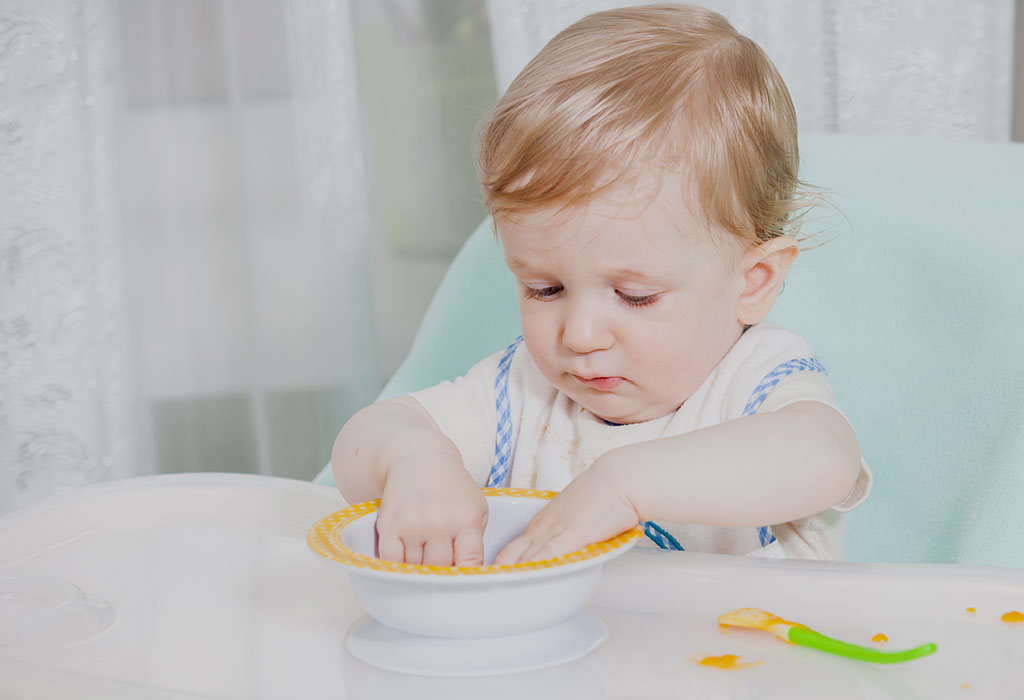

Feeding a toddler is not an easy job. By the time your toddler turns 17 months, he will throw a lot of tantrums and feeding him will become a challenge for you. If you constantly wonder what to feed to your 17-month-old toddler, then worry no more. You are not alone in this. All new moms face this situation in life as their babies grow. Taking care of a toddler is not an easy task but slowly you will learn to take care of him. Meanwhile, here are a few tricks and interesting recipes that can turn the tables in your favour and maintain your toddler's health at optimal levels.
Nutrient Requirements of a 17 Months Old Child
While putting together some great breakfast ideas, parents should remember that the nutritional requirements of their 17-month-old child should be met appropriately. Here is what your child requires at the age of 17 months.
Carbohydrates
Carbohydrates make it possible for the little one to carry out all the activities of a day. Apart from giving energy, carbohydrates also promote brain development in toddlers. A toddler should consume around 135 grams of carbohydrates daily.
Proteins
Proteins are another essential requirements for a baby. Hence, you need to make sure that your child's protein intake is not compromised.
Iron
Once the baby is weaned, his iron consumption may be affected. When a baby is breastfed, he gets enough iron from the breastmilk but later it may be compromised and as a result, it can affect the growth of the baby. Hence, when a baby is 17 months old or above, you should include iron-rich foods in his diet. Around 7mg of iron intake is necessary at this age.
Sodium
Sodium is rarely considered essential, primarily because most of our salts and other food items do contain sodium in the required quantities. Families that follow a very unique dietary pattern do need to ensure the presence of sodium in their meal choices.
Calories
The appetite of your child might not be as high as before, but that also poses a risk of them not getting enough calories required to stay active in the day. Maintaining a range of 1000 to 1400 calories on a daily basis is a great way to keep them healthy.
Dietary fibre
Most parents wonder which food items or vegetables can provide the required amount of fibre to a child. While there are numerous whole wheat food items, choosing some simple fruits that are fibrous in nature can be an easy way to keep your diet balanced.
Water
You may fail to keep a track of your toddler's water intake as he runs around the house. But, you must not take it lightly. Make sure that your child drinks enough water during the day.
How Much Food Does a Toddler Need at 17th Month?
The food requirements of a kid vary according to size, weight, metabolism, and many other factors. Some kids may be more active than others and may need more food. However, in general, they may need around 1-1.2 kilocalories on a daily basis.
Best Foods for a Seventeen-month-old Baby
Whether you are putting together some kickass lunch ideas for your toddler the following food products have been known to satisfy substantial nutritional requirements of kids.
1. Eggs
Eggs are the best multipurpose option you can go with at any time of the day. The perfect balance of protein and low cholesterol makes it great for the entire family itself.
2. Milk
The inclusion of milk in a young kid’s life is irreplaceable, be it breastmilk or full-cream milk from the dairy. If your child is lactose intolerant, you can opt for soy milk as an alternative. Ensure that it is fortified with all the necessary nutrients your kid needs.
3. Other Dairy Products
While milk is essential for a child's development, other products derived from it are just as important. Yoghurt provides probiotics, cheese provides protein, and butter just makes everything tastier than it already is. So, include dairy products in your baby's daily diet.
4. Seafood
Most parents may not consider seafood as a safe food choice for a 17-month-old baby and they are not wrong. Fish such as shellfish and swordfish should be strictly avoided. Consuming safe fish can provide tons of additional elements like DHA and omega-3 acids to a baby in a healthy proportion.
5. Meat
Avoid giving heavy meat items such as turkey, steak, or lamb to a baby. Instead, stick to poultry items as that meat is easy-to-digest and provides good proteins to the child. Grilled meat that is fresh and organic remains the healthiest choice in this matter.
6. Nuts
While nuts are extremely beneficial for kids, it is essential to check your little one for the presence of any allergy before starting him off with them. If your child has no allergy, you can give him some chopped almonds or walnuts regularly with his meals.
7. Fruits
Choosing fresh and organic fruits over any commercially available juices is always the right decision. Citrus fruits can provide numerous vitamins that a child needs, while some fruits like avocado can provide a good proportion of healthy fat in a single serving.
8. Vegetables
Almost all vegetables are safe to consume for a toddler at this age. If your kid is throwing tantrums and refusing to eat vegetables, get a little creative. You can chop and steam the vegetables and then serve. You can also give vegetables in the form of curry.
9. Grains
Quinoa is quite an interesting choice that should definitely be tried out since it is rich in proteins and iron. Similarly, millets and rice should be included regularly in a child’s diet.
10. Oil
Although oil is not specifically a food item, it is necessary to prepare the meals in healthy oils to ensure that your baby gets enough fats and nutrients from it. While preparing any snacks, use olive oil.
17 Month Old Baby Food Chart/Meal Plan
The meal plan mentioned below for a 17-month-old toddler will prove useful if you want to give different foods to your child every other day.
Day
Breakfast
Snack
Lunch
Snack
Dinner
Monday
Waffles with blueberries and milk
Watermelon chunks
Grilled salmon and beans
Banana smoothie
Red rice with black lentils
Tuesday
Banana oatmeal
Papaya milkshake
Rice with Meatballs in tomato sauce
Milk and cornflakes
Spaghetti and cheese
Wednesday
French Toast
Chopped grapes
Cooked chicken with carrots and beans
Whole wheat biscuits
Cheese Omelette
Thursday
Pancakes with maple syrup
Banana pieces
Brown rice with lentils and cooked mea
Milk and veggie kebabs
Pasta with tomato soup
Friday
Cottage cheese sandwich with juice
Blueberry smoothie
Chicken and hummus wrap
Honey and cinnamon porridge
Peas and onion couscous
Saturday
Eggs on whole wheat toast
Strawberry chunks
Pasta Alfredo
Yoghurt
Mix veggies
Sunday
Peanut Butter and jam on toast
Apple chunks
Spinach and Cheese quiche
Carrot and cucumber with yoghurt dip
Chicken and red kidney bean wrap
While dinner ideas amongst many other meal options might be easy to come up with, snacks can get quite tricky and repetitive after a few weeks. Here are a few interesting snacks recipes that you can try for your toddler.
1. Toast with Avocado
Fats are essential for kids and including avocado in his diet through this recipe can make sure he gets the right amount of it. So, try this tasty recipe for your baby.
Ingredients
Salt
Pepper
Cheese
Whole wheat bread
Banana
Avocado
How To Prepare
Take an avocado and separate the seed. Mash the fruit properly in a bowl so that it forms a creamy paste.
Add some salt and pepper to it to enhance the flavour.
Toast the slices of bread and arrange them on a plate. Spread the avocado mashed mix on the slices. Add banana pieces over it and shred some cheese on top.
2. Banana Oatmeal
Breakfast time is the perfect time to ensure that a child gets the most of nutrients. This recipe can provide enough fibre and vitamins in a single go, as well as keep your child satisfied for a long duration.
Ingredients
Cinnamon
Bananas, chopped
Almond milk
Water
Oats
How To Prepare
Cook oats in a pan. Make use of water or even almond milk as a base for it. Stir the oats intermittently so that they are cooked properly.
Once the oats are softened, add cinnamon powder to enhance its taste.
Turn off the flame and let it cool.
Transfer it to a bowl and mix some banana pieces in it and the dish is ready!
3. Mediterranean Salad
A toddler may not show much interest in eating salad but if you garnish it with cheese, he sure will eat it. Try this salad recipe for your baby.
Ingredients
Cheese
Black pepper
Salt
Coriander
Black olives
Tomato
Bell pepper
Onion
Vinegar
Olive oil
Quinoa, cooked
How To Prepare
Dice the vegetables in small pieces and put them in a bowl.
Take a pan and add olive oil to it. Put onions, bell pepper, tomatoes, and coriander and sauté them.
Add these vegetables with cooked quinoa in a large bowl and garnish with cheese.
4. Tasty Risotto
When looking for a dish that is light on flavour and heavy on nutrition, go with this choice.
Ingredients
Cheese
Lemon juice
Butter
Frozen peas
Carrots
Vegetable stock
Rice
Olive oil
Spring onion
How To Prepare
In a pan, add butter and spring onions, and saute them until they soften.
Add peas and rice and cook it well. Follow up with the vegetable stock, and stir it until it is absorbed fully. Add more stock thereafter till the rice softens. Cover the pan with a lid.
Once the rice is cooked, grate cheese over it and serve fresh.
5. Pumpkin Dip
Not only will this add great flavour to your snack, but it is a great source of vitamin A as well.
Ingredients
Lemon
Pepper
Salt
Pumpkin, canned
How To Prepare
Make pumpkin puree and add pepper, salt to it.
You can also add a few drops of lemon.
Serve with digestive cookies or even various fruits.
Feeding Tips
Feeding your toddler won’t be a difficult task anymore if you keep the following tips in mind.
Let your child handle plastic cutlery by himself.
Allow judicious meal times for your kid to eat calmly.
Focus on trying out variety instead of finishing the food.
Keep the diet balanced at all times.
Talk to your doctor before introducing a new item.
Make sure your kid drinks water after a meal.
Use colourful bowls to make the food look appealing.
Cut fruits and foods into tiny pieces when giving it to your baby.
Don’t let your kid eat without your supervision.
Don’t scold your kid if he spits out any food he doesn’t like.
Meals always constitute a larger portion of your child’s food but snacks for 17-month-old baby are what tend to do the trick many times. Offering a variety can help your kid warm up to food items he hated earlier and you never know he may start eating them.
Also Read: 5 Indian Winter Foods for Babies with Recipes
8
18 Months Old Baby Food - Ideas, Chart and Recipes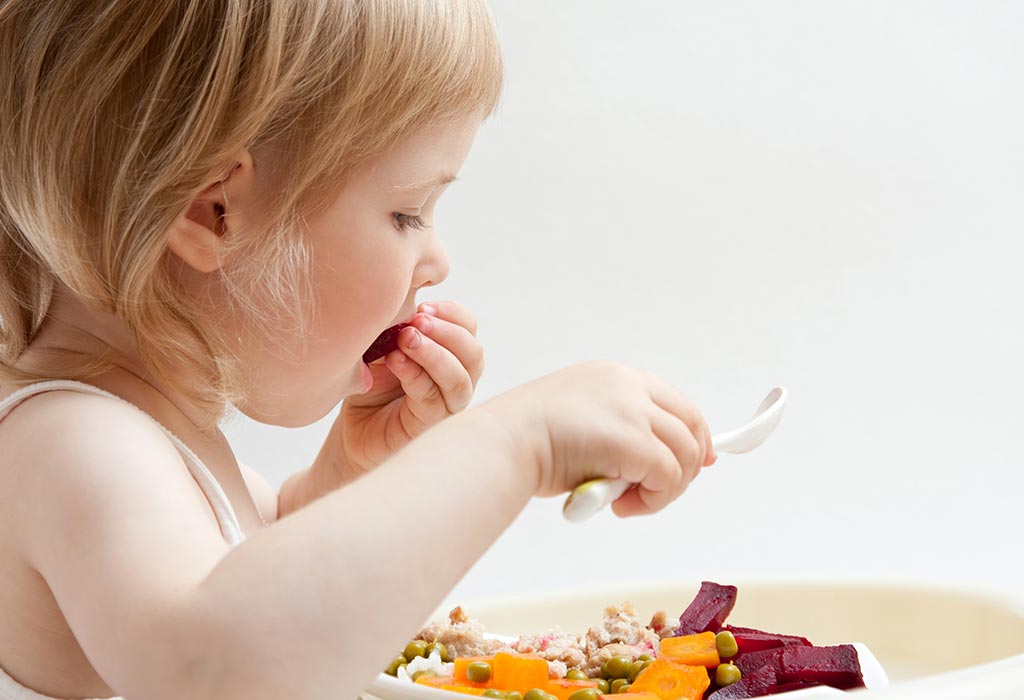

Simple biscuits and milk along with some random food items won’t be the favourite snacks for the 18-month-old toddler in your home anymore. He is growing up, and so are his tastes and preferences. Therefore, a little variety in his meal plan can go a long way in ensuring he meets his nutritional requirements as well as looks forward to his food once again.
Nutrient Requirements for 18 Months Old Child
While putting together some awesome lunch ideas to hook your 18-month-old on to, here the nutrients that need to be in them.
Iron: The importance of iron-rich foods in your child’s diet keeps getting important throughout his growing years. It is necessary to ensure that your kid keeps getting items like broccoli and spinach regularly in his meals.
Fats: Your kid’s appetite would not be as high as it used to be earlier. Hence, it is important to ensure he gets the right amount of fat on a daily basis. A couple of servings of butter along with coconut or fat-rich fruits is a good way to make that happen.
Whole Grains: The benefit of consuming whole grain food items is not instantly visible but takes place internally over time. Even simple habits such as using whole grain bread instead of white can bring about an improvement in your child’s health.
Meat Products: With his growing age, your child might begin to prefer meat, as well as his digestive system, will get stronger. Nevertheless, a controlled amount of meat intake, along with eggs, is a good way to meet his protein requirements.
Legumes: Some families might tend to use leguminous foods in their veggie preparations regularly while others might go for nuts once in a while. If your child is allergic to nuts, you could try using peas as well as flaxseeds or hemp for him.
Dairy Products: Milk continues to be a major foundational element in the growth of kids during the early years. While whole cream milk is highly recommended, supplementary products such as cottage cheese, can provide health benefits, too.
Vegetables: Parents may be at their wits end in figuring out how a variety could be maintained in vegetables in the longer run. Keeping a balance of leafy vegetables with raw salads, you can mix and match preparations to satisfy your kid’s nutritional requirements.
Fruits: Including fresh fruits with your kid’s breakfast is a great way to make sure his body appropriately gets the necessary nutrition. Don’t refrain from giving dry fruits as well, since they have a whole other constitution that can benefit your kid.
How Much Food Does Toddler Need at 18th Month?
The quantity of food a toddler eats around this age is comparatively less than what he would have been earlier. Therefore, it is necessary to match a calorie intake of about 1.2 kilocalories than looking at a quantity of food.
Best Foods for Eighteen-Month-Old Baby
Figuring out the right food items for your little toddler might present some obstacles, as your dinner ideas might not fit well with his requirements. Here are some foods you can include in the meal plans.
1. Milk
If your child is still on breastmilk, it would be great if you can alternate it with a little full milk once in a while. Apart from the nutritional benefit, it is necessary to teach your kid to start drinking milk as well as water from a cup instead of a bottle.
2. Fruits
It is best to keep away from juicing the fruits or pureeing them since it robs your kids of the fibrous benefits they provide. Mix up different fruits to keep a balance of tastes.
3. Vegetables
Various recipes can make even the hated vegetables pretty interesting to eat along. Using coloured vegetables as raw alternatives in small pieces can be easy finger food, too.
4. Meat and Nuts
While this combination might seem weird, pairing both these foods together packs quite a ‘protein’ punch! Supplement portions of chicken or fish with soy chunks, sprouted beans, cashews, and so on. You don’t have to do this every day; having this combination every alternate day of the week should still provide you with the benefits you’re looking for. However, discontinue having portions of meat and nuts together if you notice any signs of a food allergy.
5. Bread
Avoid choosing white bread for your kid as much as you can. Whole wheat bread should be your go-to option for any sandwiches you make. To meet the grain requirement, you can even go with dry cereal or crackers instead of bread.
6. Butter
When making sandwiches, make sure you butter the bread lavishly for your child. Even when preparing meals you can use a good dollop of ghee to go along with it. These tiny measures will ensure a good fat intake by your child and keep him healthy.
7. Jaggery
Most of the processed and refined sugar in the market don't pose any direct, using jaggery instead as a sweetener comes as a recommendation from the old ages. Not only is this more natural and healthy, but the sweetness is quite controlled as well.
8. Cheese
Even if your child is consuming milk daily, supplementary dairy products are necessary to go along with it. Different varieties of cheese along with yoghurt provide probiotics and other nutrients that simple whole milk may not always do.
9. Salad Mixes
Use raw salads or other vegetables in a tasty salad or in a baked recipe to entice them and keep their diet plan going.
10. Water
Before you even think that your kid has enough water, it is important to note that juices and liquid foods are not an equivalent for drinking plain good water. There are chances of your kid suffering from digestive issues and health problems if his water intake is not up to the mark.
18 Month Old Baby Food Chart / Meal Plan
A food chart that establishes some general meals for each week can assist you in creating your own.
Day
Breakfast
Snack
Lunch
Snack
Dinner
Monday
Cheddar Cheese and tomato sandwich
Banana pieces
Chicken Shawarma wrap with hummus
Glass of milk
Pasta Bolognese
Tuesday
French Toast with blueberries and strawberries
Orange chunks
Peas and cauliflower with rice
Glass of milk with almonds
Eggs on toast
Wednesday
Peanut butter and jam sandwich
Guava bites
Lentil and rice Koshari with boiled pasta
Orange smoothie
Greek Salad with feta cheese and crackers
Thursday
Oats porridge with apple pieces
Kiwi chunks
Spagetti with meatballs
Hummus and bread sticks
French Toast
Friday
Pancakes and milkshake
Strawberry chunks
Steamed fish and veggies with brown rice
Mini pizza
Cottage cheese sandwich
Saturday
Banana Waffles
Watermelon pieces
Creamy mushroom chicken with rice
Berry Milkshake
Broccoli and cheese baked in the oven
Sunday
Egg and cheese sandwich
Papaya chunks
Spinach & cheese quiche
Glass of milk with almonds
Banana and Berry pancake
Your kid should also have at least half a glass of milk every day.
Food Recipes for 18 Months old Baby
Coming up with new breakfast ideas or novel plans for dinner can be made easier if you have a few recipes at your disposal that you can get started with right away.
1. Soya Cutlets
Bring together the goodness of soya chunks with the tasty preparation of cutlets made from it.
Ingredients
Onions
Oil
Coriander
Pepper
Salt
Mixed spices
Boiled and mashed potatoes
Soya bean and lentil paste
How To Prepare
Use a large bowl and mix the soy paste, potatoes, spices, coriander and some salt. Mash the potatoes further and mix them well.
Now, use portions of this mix to roll balls and flatten them to create the cutlets. If they are loose, keep them in the fridge for 30 minutes.
Add some oil to a pan and shallow fry the cutlets on both sides using a medium flame.
Pair with some tomato salsa or sauce and serve.
2. Cheese and Spinach Quesadillas
This hearty, healthy and delicious meal will not only waw your toddler but will keep him full and well nourisdhed too!
Ingredients
3 Tablced spoons of olive oil
8 oz. fresh baby spinach
2 large flour tortillas, burrito size
16 oz oaxaca or monterey jack cheese, shredded
How To Prepare
In a large skillet on medium-low heat, place 1 table spoon of olive oil and the spinach. Cook for about 1 minute, tossing constantly to ensure even cooking. Once it darkens and wilts, remove to a bowl or plate.
Place another table spoon of olive oil in the skillet and a tortilla. Move it around a little to soak up the oil. Spread about half of the shredded cheese on half of the tortilla, then sprinkle a small amount on the other half. Top the cheese with about half of the spinach. Cook for 30 seconds – 1 minute until the cheese starts to melt.
Fold the tortilla over on itself, like an omelet. Cook for 30 seconds, then flip and cook for another minute.
Remove to a plate and cut into fourths. Repeat the process with the remaining oil, spinach, tortilla and cheese and then serve for your little one to enjoy!
3. Banana Pancakes
We were just as surprised to read the title as you are. But once we tasted it, there was no going back.
Ingredients
Ghee
Bananas
Pancake Batter
How To Prepare
Take a large bowl and add banana pieces to it, mash them well. Mix these with the pancake batter properly.
Coat a pan with ghee and add a cup of this batter on it, while sitting on medium flame.
As you spread, add a little more ghee on the edges.
Flip it around and cook both sides. Pair this with honey for an ecstatic flavour.
4. Oats Apple Porridge
This breakfast recipe can be made for the entire family in a single go.
Ingredients
Honey
Apple
Cashews
Walnuts
Raisins
Almonds, soaked
Milk
Instant oats
How To Prepare
Heat together oats and milk in a deep pan for a few minutes to cook them well.
Peel and grate almonds along with other nuts, and add them to the mix with raisins and the honey. Keep stirring constantly.
The moment it starts thickening, turn off the flame. Garnish with apple pieces and some more nuts before serving.
5. Hard Boiled Egg and Avocado Bowl
Avocadoes and eggs are an excellent combination and a great source of good fats and proteins for your toddler and he will love this quick and easy preparation!
Ingredients
2 hardboiled eggs, chopped
1/2 large avocado, chopped
1 heaping tablespoon of sauted red onion, finely chopped
1 heaping tablespoon sauted red bell pepper, finely chopped
A little pinch of sea salt and ground pepper
How To Prepare
Combine the hardboiled eggs, avocado, sauted onion and bell pepper in a bowl.
Sprinkle on a pinch of sea salt and ground pepper.
Feeding Tips
Here are a few tips to make your meal times better.
Lead by example so that your kids follow
Use attractive cutlery to add visual appeal
Pair food items to mask the hated ones
Let your kid play around with the food
Focus on table foods from this age
Avoid including too many sweets or fried foods
Resort to smaller meals on a frequent basis
Keep the variety going to expand their palate
Keep juices to a minimum
Teach your kid to chew food properly
With the recipes mentioned above and the diet chart as a benchmark, you would have a good answer to your question around what to feed my 18-month old for his meals. Tweak them to your liking and keep track of his behaviour over the months.
Also Read: 15 Healthy and Tempting Finger Foods for Toddlers
19 Months Old Baby Food - Ideas, Chart and Recipes

Most of our traditional meals would revolve around typical Middle Eastern food recipes. These can quickly get repetitive for children, even though our flavours are quite diverse. Opting for some different snack choices or creating a fusion of various cuisines is how you can create a meal chart that has exciting recipes all around.
Nutrient Requirements for 19 Months Old Child
All the meal planning right from lunch ideas to the little snacks your kid would have in the evening need to work together in ensuring a balanced nutrition all around.
1. Carbohydrates
For kids carbs are everything that they need to keep their energy levels high which allow them to play around and engage in anything they wish to.
2. Proteins
The actual physical growth of a child is highly dependent on protein, even though the daily requirement might not be as much as you might think. Based on your own family diets, the protein intake needs to be regulated accordingly.
3. Iron
Anaemia in children is not unheard of and it can severely impact their development in myriad ways. The inclusion of iron in different forms is highly recommended since children might not be breastfeeding at this age.
4. Multivitamins
Contrary to the popular opinion, multivitamins are not suggested by doctors after an issue is diagnosed. These are usually prescribed as a pre-emptive measure to balance any kind of deficiency a child might be at the risk of experiencing.
5. Sodium
An addition of sodium can lead to heart-related issues later in life, while its absence can cause developmental problems now.
6. Calories
Energy and nutrition might be two sides of the same coin, but both are procured by the body in different ways. A nutritive diet may not necessarily be an energetic one, which makes it necessary to keep a proper track of calorie intake.
7. Fibre
The deficiency of fibre is one of the rarest things to occur with a child since their presence is prevalent in numerous food items. The more you maintain a regularity in consuming certain raw veggies and fruits, the better your fibre intake remains.
8. Water
Time and again, kids are advised to drink water throughout the day. It is quite simple to lose track of keeping yourself hydrated only to reach a breaking point and experience its side effects. Eight glasses of water are all it takes.
How Much Food Does Toddler Need at 19 Months?
Most kids begin to increase their activities as they cross the 1.5-year mark. Therefore, their calorie requirements usually hover between 1.2-1.4 kilocalories (1200 to 1400 calories), which depends on their physical constitution and metabolism as well.
Best Foods for Nineteen-Month-Old Baby
Here are some snacks for a 19-month-old that you can try.
1. Meat
It is important to remember that the meat procured needs to be fresh and organic, as well as, prepared in the right way. Offer small chunks of meat rather than large pieces.
2. Milk
A glass of milk on a daily basis provides a substantial amount of nutrition in a single go. Whether your kid drinks that in the morning or in the evening, fortifying it with some added nuts is also a good way to maintain high nutrition.
3. Fruits
Simple fruits such as bananas and apples are quite useful along with kiwi and pears included occasionally. Eating them directly is better than drinking their juices.
4. Milk-Based Products
Curd and buttermilk keep a balance of nutrition and better health simultaneously. Cheese sandwiches are a good choice, too.
5. Nuts
Whether you mix them up in milk and other products or offer them directly to your little one, nuts include many nutrients ranging from omega-3 acids to fats that are quite beneficial for your kid.
6. Seafood
Keeping away from the fishes that contain higher amounts of mercury as well as different varieties of shellfish that could trigger allergic reactions, is all you need to know when giving seafood to your child.
7. Grains
If your child is not a fan of bread or similar products, you can switch the foods by replacing them with brown rice or even millets. These whole grain foods are great for the body and provide good amounts of protein.
8. Eggs
Whether you make omelettes, use them with sandwiches, give them in a boiled egg form, scrambled eggs, you can immerse yourself in a large variety of egg preparations and come up with ideas that can provide a boost of nutrition and energy in the best way possible.
9. Oil
Sunflower oil is not advised for adults so you might be keeping its usage minimal in your family. It is best to switch to a healthier oil and use it in proper amounts so that your child receives the health benefits from it as well.
10. Vegetables
Use different vegetables in a variety of cooked food preparations such as courgettes and okra. It is important to note that some veggies can be used raw in various salads as well, adding a twist to their usual taste.
19-Month-Old Baby Food Chart/Meal Plan
When figuring out what to feed your 19-month-old, don’t fret too much. All you need to do is make small changes in your existing one, and the following meal plan can be a good guide for doing so.
Day
Breakfast
Snack
Lunch
Snack
Dinner
Monday
French toast with berries
Watermelon chunks
Chicken shawerma and hummus wrap
Glass of milk and veggie cutlets
Spaghetti Bolognese
Tuesday
Feta cheese sandwich and orange juice
Papaya smoothie
Rice and cooked meat with veggie salad
Yoghurt
Wheat pasta with basil pesto and soup
Wednesday
Pancakes with maple syrup
Banana pieces
Baked salmon with brown rice
Salads with pumpkin dip
Cottage cheese and whole wheat toast
Thursday
Oatmeal Porridge
Milkshake
Spinach, cheese onion quiche
Strawberry smoothie
Meatballs in tomato sauce
Friday
Cinnamon waffle with bananas
Strawberry chunks
Brown rice cream of mushroom chicken
Milk and cornflakes
Scrambled eggs on toast
Saturday
Banana oatmeal
Apple pieces
Fish fingers and potato mash
Digestive grain biscuits and milk
Rice and lentil Koshari with pasta
Sunday
Melted Cheese Mankousha
Grapes
Chicken Nuggets with tomato salsa dip
Porridge with honey
Red beans and veggies taco
Here are some interesting recipes that can leave your little one smacking his lips at the end of the meal.
1. Carrot Cheese Tortilla Wrap
The nutrition of two essential ingredients all wrapped up within a delicious tortilla wrap.
Ingredients
Ghee
Tomato
Black pepper
Cheese
Carrot
Wheat flour
How to Prepare
Heat a pan with oil.
Add in the tomato, carrots, black pepper and salt, letting them all cook together.
Once it cools down, use the flour to make some dough and roll a flat tortilla out of it.
Fill it up with the veggie mix and grate some cheese over it.
Roll it up again to close it and cook it on the pan with ghee.
2. Steamed Riced Wraps
When your kids are extremely hungry and you barely have any time to make a meal, a simple rice wrap could be your best buddy.
Ingredients
Ghee
Rice batter
How to Prepare
Take a pan and heat it well.
Once hot, add a dollop of batter in the centre and spread it into a circle.
When the holes begin to form, add some ghee over and around the rice batter.
Let it cook for a few minutes with a lid and remove it once it gets spongy.
Pair with tomato salsa or flavour the batter with some other ingredients such as cucumbers and avocadoes with sautéed onions and bell peppers.
3. Semolina on Toast
Semolina not only provides health benefits but the toast is quite crunchy and delicious in its flavour as well.
Ingredients
Bread
Ghee
Black pepper
Salt
Capsicum
Onion
Carrot
Milk cream
Semolina, roasted
How to Prepare
Keep the bread and ghee on one side. Take a bowl and mix all the other ingredients together in it.
Use this as a paste and coat the bread slices.
Take a pan and add some ghee to it. Toast the bread slices on the pan upside down.
Once done, flip it around to make both sides brown and then serve.
4. Wheat Pancakes
Pancakes can be a nutritious breakfast item as well if you pair a sweet dip with these healthy wheat ones.
Ingredients
Ghee
Fennel seeds
Water
Honey or maple syrum
Wheat flour
How to Prepare
Mix the honey/maple syrup with the flour to form the batter. Follow up with fennel seeds and water. This can be prepared overnight as well.
Add some ghee to a pan. Heat it up and pour batter to form a solid circle.
Spread it, cook one side, and then flip it around. Serve with some honey for added sweetness.
5. Spring Rolls
This awesome recipe will literally have the little one eating out of your hand.
Ingredients
Salt
Olive oil
Wheat flour
Soy sauce
Black pepper
Salt
French beans
Baby corn
Cabbage
Capsicum
Onion
Carrot
How to Prepare
Prepare a dough with medium consistency using the flour and water.
Take a small portion and roll it, shaping it to be a rectangle. Make multiple such shapes as thin as possible. Cover them with a wet napkin.
In a hot pan, sauté onions in oil, with veggies and seasonings, keeping them slightly crunchy.
Take wheat flour and water in a bowl to form a thick paste.
Now, fill the veggie mix in one rectangular shape and paste it up with the flour mix. Roll it up and close the open end with more paste.
Prepare all the rolls in this manner and deep fry to make spring rolls. Pair with tasty dips and sauces.
Feeding Tips
In lieu of preparing different breakfast and meal ideas in general , try to adhere to some important tips to ease the experience.
Keep adding variety to the meal plan
Let your child use plastic spoons by himself
Teach him to use a fork with small food items
Talk to your doctor when starting your child on meats
Keep mealtimes a relaxed affair
Squeeze a lemon on vegetables to pep up the taste
Let your child drink limited water during meals
Avoid giving whole nuts or even whole finger foods
Don’t stop breastfeeding just to get him to eat
Keep liquids to a minimum around dinner time
Putting together an effective meal plan that works for your kid as well as giving him the nutrition he needs can take a huge load off your chest. It is better to come up with dinner ideas that are easy to prepare, keeping the complex ones for the weekends or holidays as a celebration.
Also Read: 17 to 20 Months Old Baby Food Ideas
20 Months Old Baby Food - Ideas, Chart and Recipes

By the time your little one reaches the age of 20 months, he will start throwing tantrums. He won't accept what you feed him and those amazing breakfasts that he loved earlier won't work anymore. Children are at a peculiar stage when they approach two years, and their eating habits change as well. In such scenarios, keeping certain quick-to-prepare recipes at your fingertips and opting for a meal plan that he willingly accepts, can make your life easier.
Nutrient Requirements of 20 Months Old Children
Even while putting together interesting lunch ideas for your 20-month child, it is important to keep in mind that certain nutrients are essential for a baby and you cannot do away with it. Following are the nutrient requirements of a 20-month-old child. Make sure your child gets these nutrients:
1. Calories
Calories help provide energy for the body. The key aspect here is to know the difference between a diet that provides good nutrition as well as enough calories that power the core of the body. A balance is necessary in order to avoid a meal plan that skews towards either direction.
2. Proteins
Proteins are considered to be the building blocks of the body and are essential for toddlers, especially in their development stage. Ensure that his diet consists of adequate protein.
3. Carbohydrates
Carbohydrates help provide fuel for the brain, muscles and nervous system.
4. Fibre
Fibre helps in proper bowel movement and proper digestion. A simple habit to ensure enough fibre content in your kid’s meal is to opt for whole food items instead of any processed stuff. Most of the times, many carbohydrate-rich food items have a substantial fibre content in them.
5. Sodium
Not many doctors or nutritionists stress on the necessity of sodium to be present in the child’s diet. All it takes is just 1 gram of sodium every day. Any reduction can severely hamper the nerve function in a kid.
6. Iron
Iron is required by the by the body for the proper functioning of the blood. Most kids that have an iron deficiency are primarily those that have a strong preference in their food choices. Iron supplements are barely needed, and most of it can also be obtained from vitamin C rich fruits or even utensils made from cast iron.
7. Vitamin D
Vitamin D is needed for children of this age as it helps to absorb calcium and improves bone growth. This can be found in milk and through adequate exposure to sunlight.
8. Water
Water helps in numerous bodily functions such as digestion, the creation of saliva and regulating body temperature. The activity of your child and the consumption of water needs to be directly proportional at all times. Even if your little one isn’t playing around all the time, keeping up with the daily water intake is essential in every way.
How Much Food Does Toddler Need at 20th Months?
The activities of your little one will begin to increase as he approaches the 2-year mark. Therefore, his calorie requirement will now begin to approach closer to 1400, even though his appetite stays more or less the same.
Best Foods for twenty-month-old Baby
Your dinner ideas for your little one can be enhanced by including certain foods in the diet of your 20-month-old baby.
1. Fruits
When it comes to including fruits for nutrition variety can make it so much easier. Mangoes, kiwi, berries of various types, grapes, bananas, and even dry fruits play a vital role in introducing numerous tastes and nutrients to your kid.
2. Eggs
Eating an egg every day can be great for your child’s health. Pair them up with bread to ensure a breakfast that provides all nutrients or even include them in various vegetable recipes.
3. Dairy Products
Apart from a glass of milk, there are multiple items such as cheese, yoghurt and laban, that ought to be a part of your child’s diet. Lactose intolerant kids can opt for fortified alternatives.
4. Fatty Oils
Coconut oil and avocado oil have a special place in the diet of kids that are 20 months old. Appropriately served, these provide enough fat supply to the child, which creates energy reserves that keep the body going.
5. Vegetables
While leafy vegetables, as well as greens like peas, cauliflowers, broccoli and numerous other veggies, are good for your child, these are not the only sources. Simple tomato sauces and salsa do contain beneficial nutrients, too.
6. Meat
As your child comes closer to completing 2 years, you can start introducing small chunks of different meat items such as turkey, lamb, beef and so on. Make sure to start off slow and teach him to chew them properly.
7. Legumes And Nuts
Right from seeds such as hemp, chia, flaxseeds as well as legumes like peas, lentils, beans and many others, a couple of servings provided each day to your child would be a great addition to his nutrition.
8. Greens And Citrus Fruits
Leafy vegetables in a large proportion combined with fruits that are rich in vitamin C work together in providing the kid’s body with iron and helping it absorb within the system effectively. Red meat is known to do the same job, too.
9. Bread and Oatmeal
The reason oatmeal is highly recommended for kids, along with whole wheat bread, is the larger benefit, the inclusion of grain food items brings to their body. Quinoa is also suggested by most parents for kids between 1-2 years old.
10. Seafood
Seafood is a tad tricky since it does have some great benefits but also comes with the risk of arsenic or mercury poisoning. As long as you stick to specific fishes which are procured from reliable sources, your kids would benefit greatly from them.
20 Month Old Baby Food Chart/Meal Plan
Here’s a diet chart for a 20-month-old baby to help you with planning his meals.
Day
Breakfast
Snacks
Lunch
Snacks
Dinner
Monday
Chocolate muesli
Wheat biscuits
Grilled chicken sandwich with cucumber and yoghurt
Apple and pear chunks
Scrambled eggs on toast
Tuesday
Tomato and cheese sandwich
Roasted peas
Baked seabass with lemon sauce and rice
Oat muffins
Spaghetti with meatballs
Wednesday
Banana Pancakes
Granola bar
Grilled beef Kofta and Fatoush salad
Strawberry milkshake
Basil pesto pasta
Thursday
Oatmeal porridge and berries
Watermelon milkshake
Chicken and spinach quiche
Wheat cake
Cheese and tomato omelette
Friday
Cinnamon and apple waffles
Oats bar
Lentil soup and crackers
Spinach fritters
Meatballs in tomato sauce
Saturday
Pumpkin pancakes
Fruit yoghurt
Capsicum rice with chicken cubes
Spring rolls
Cottage cheese and cucumber sandwich
Sunday
Sweet potato & papaya hash
Wheat biscuits
Egg rice
Cheese balls
Hard boiled eggs and melted cheddar
Food Recipes for 20 Months Old Baby
If you’re still figuring out what to feed my 20-month old that you can cook easily, these recipes can pave your way to make it happen.
1. Pumpkin Pancakes
These can be prepared and refrigerated in advance as well, to make for a quick and delicious breakfast.
Ingredients
Vanilla essence
Pumpkin puree
Eggs
Butter
Milk
Brown sugar
Salt
Nutmeg
Cinnamon
Baking powder
Whole wheat flour
How to Prepare
Mix flour, baking powder, cinnamon, nutmeg, salt and brown sugar together in a large bowl.
In another bowl, add milk, butter, eggs, puree and vanilla essence and mix it all well.
Pour this into the first bowl and whisk them until they are smooth. Let it sit for a while.
Use this batter to make pancakes on a pan coated with ghee at medium heat. Cook both sides to a golden brown colour and serve with honey or maple syrup.
2. Tofu Wheat Biscuits
Biscuits don’t have to be the same boring ones all the time. Here’s a great variant for you to try.
Ingredients
Salt
Curry leaves
Fennel seeds
Onion
Butter, salted
Baking powder
Whole wheat flour
Tofu, crumbled
How to Prepare
Preheat the oven to a temperature of 170 degrees and grease a tray.
Grind together curry leaves, fennel seeds and onions.
Take butter in a bowl and add tofu to it, while whisking it. Add in the flour along with other ingredients mixing it all together properly till it is stiff.
Cut out biscuit shapes from a thinly rolled layer of dough. Bake these in the oven for about 20 minutes and take them out once they get brown. Let them cool and then store in an airtight container.
3. Vegetables Manchurian
Homemade Chinese food is the best your kids will have, that is healthy and tasty at the same time.
Ingredients
Cornflour
Refined flour
Black pepper
Salt
Carrot
Cabbage
Cauliflower
Vegetable stock
Ketchup
Soy sauce
Ginger paste
Garlic
Onion
Oil
How to Prepare
Chop all veggies and mix them in a bowl with the flours to form a dough. Don’t add extra water.
Make balls from this dough and deep fry in a pan to a brown shade. Use a napkin to soak extra oil.
Take a pot and fry ginger garlic paste in it. Follow up by sautéing the onions and adding condiments and sauces.
Pour in the vegetable stock and let it boil. Add the cornflour paste to make it consistent and gently insert the fried balls in it.
4. Whole Wheat Cake
Give your little one a cake that is not just delicious but healthy all the way.
Ingredients
Baking powder
Banana
Dry fruits
Ghee
Jaggery
Milk
Wheat flour
How to Prepare
Fry the flour with ghee and let it cool down.
Blend the flour with jaggery and banana. Add fried nuts to the flour.
Coat a cooker plate with ghee and pour the mix into it. Add a little water to the cooker and let it cook on medium heat for half an hour without a whistle.
Let the cake cool down before serving.
5. Rotisserie chicken tacos
These Easy Rotisserie Chicken Tacos are a quick and delicious weeknight meal that the little ones are going to keep asking for!
Ingredients
2 cups salsa either homemade, or use your favorite jarred salsa
1 cup water
2 tablespoons tomato paste
½ teaspoon coriander
1 teaspoon ground cumin
1 small rotisserie chicken, meat removed from the bones
6 tablespoons vegetable oil
12 white or yellow 6” corn tortillas
8 ounces cheddar cheese, shredded
4 cups shredded iceberg lettuce
8 ounces Monterey jack cheese, shredded
How to Prepare
Preheat the oven to 450 degrees F.
Have a roasting pan with high sides ready that can hold 6 completed folded tacos
In a large skillet, place salsa, water and tomato paste. Start burner on medium, stir and combine.
Add the coriander, and cumin and stir again.
Shred the cooked chicken pieces into the salsa mixture and heat to hot then hold to keep warm.
Brush a sheet pans with half of the oil. Lay out the corn tortillas and brush the tops with the other half of the oil.
Divide the cheddar cheese between the tortillas.
Divide the warm chicken mixture between the tortillas, on top of the cheese but not completely to the edges.
Place in the oven for 12-15 minutes or until the edges start to get a little crispy and the mixture is hot and bubbly. Rotate pan half way through for even browning.
Remove pan from the oven and quickly top with half the lettuce. Then pick up each tortilla, fold in half and place in the reserved dish or pan, letting each taco stay folded by leaning on the one next to it, or the side of the pan. They will stay in this shape once folded hot. Turn off oven.
Then take the folded tacos and top with the Monterey jack cheese and place back in the oven with the oven off for 4-5 minutes. The residual heat will melt the jack cheese over the lettuce.
Serve hot with whatever toppings your little one prefers including sliced black olives, avocado wedges, sour cream, lime juice, fresh cilantro, etc.
Feeding Tips
Keep a few tips in mind when preparing a meal plan and feeding your little one.
Make sure vegetables are included daily
Don’t force him to finish his plate if he doesn’t like it
Don’t let him eat too much of anything as well
If a child skips lunch, make sure the snack is judicious enough
Let dinners include meals that can be had luxuriously
If a child hates a food item, make sure you eat it as well
Let your kid sit with you on the same dinner table with the family
Keep track of allergies when introducing new food items
Choose to mash food items than giving him whole
Sugary items should be given within strict limits
Figuring out great snacks for a 20-month-old toddler won’t be as challenging as it seems, once you start looking at the possible combinations of everyday food items.
Also Read: 17 to 20 Months Old Baby Food Ideas
21 Months Old Baby Food - Ideas, Chart and Recipes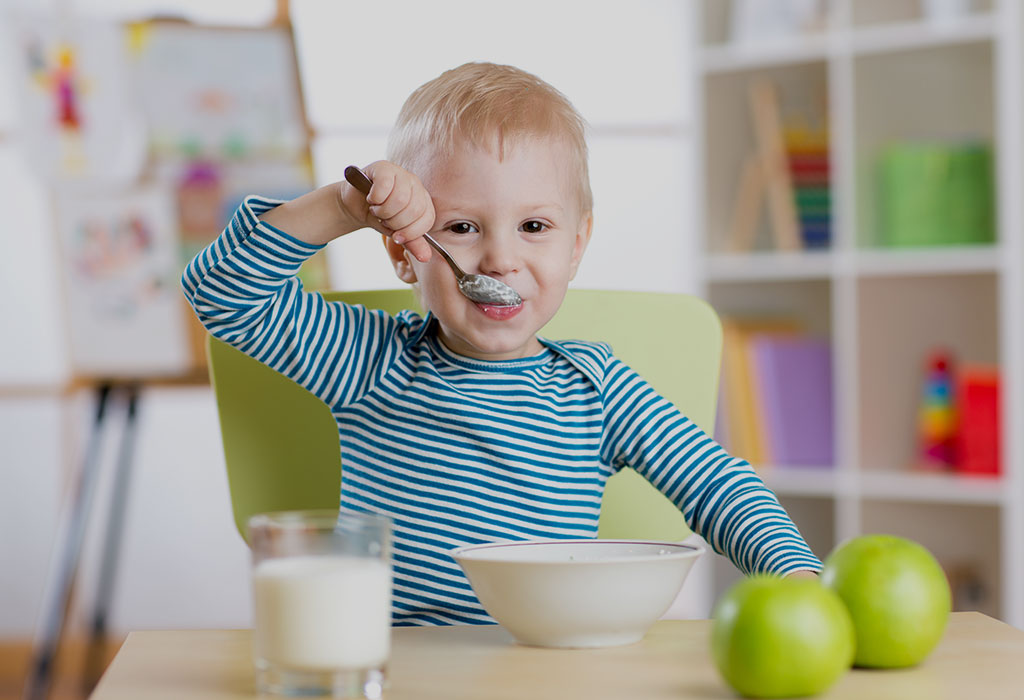

Toddlers can be a challenge when it comes to nutritional intake and feeding. This is the time that they begin to develop individuality and endeavour to control what they eat. Such developmental milestones can make mealtime a struggle for parents. It is important to support the baby with planned meals while also setting boundaries on who has control.
Nutrient Requirements for 21 Months Old Child
Listed below are some nutrients that are essential for children at 21 months of age:
1. Carbohydrates
Glucose from carbohydrates is used by the brain to fuel itself. The amount of carbohydrate required by a 21-month-old child is around 130 grams. This is the same amount needed for an adult brain to work properly.
2. Protein
Babies require a low protein diet. A toddler requires a mere 13 grams of protein per day.
3. Fat
Fats are an essential nutrient for toddlers. They're is required by the body for absorption of fat solvable vitamins, cellular building, muscle movement and blood clotting.
4. Sodium
Sodium works as an electrolyte in the body, and it is imperative for nerve function, muscle contraction and to regulate blood pressure. An infant requires a minimum of 1 gram per day for optimum functioning.
5. Iron
Iron is required to produce red blood cells that carry oxygen through the blood. Iron insufficiency can lead to frequent infections, fatigue, and pale skin. Toddler requires 7mg of iron per day.
6. Calcium
Calcium is an important micronutrient required for the development of bones, teeth and even heart function. Toddler up to the age of 3 require 700mg of Calcium per day.
7. Vitamin D
Vitamin D is vital for absorption and utilization of calcium by the body. Children require 300-400 units of Vitamin daily.
8. Water
Toddlers at 21 months of age require 1.3 litres of water that should come from mixed sources such as water itself, from food, and water contained in milk. Water forms 70-75% of your body weight and is required to structure large molecules, transport other nutrients, lubricate and cushion organs, and flush toxins from the body.
How Much Food Does a 21-Month-Old Toddler Need?
Toddlers have a lower calorific need than infants due to a slowdown in growth. Toddlers require anywhere between 1,000 to 1,400 calories every day, depending on their size, physical activity level and age. This translates to roughly ½ a cup of rice, 1 small fruit, 1 cup mashed or cooked vegetables, 1 cooked egg, and 1 cup of milk each day. Toddlers also require a healthy amount of oils in their meal.
Best Foods for 21-Month-Old Baby
Homemade food that is processed as little as possible is the best way for children to meet their nutritional needs. Some of the best foods to offer 21-month-old babies are listed below:
1. Cooked eggs
Eggs can be boiled or scrambled and can be served with butter or cheese.
2. Bread rolls
Flatten the slice of bread and butter it. Roll to make finger food.
3. Nut butter and jam sandwiches
Dress up your regular sandwiches by adding a fistful of peanut butter and jam.
4. Cheese quesadillas
Maybe you can add a bit of spinach or tomotoes to them for variety
5. Avocado and boiled egg
Excellent source of a variety of nutrients and good fats
6. Poached chicken with bbq sauce
Great and tasty source of protein that will leave your toddler wanting for more!
7. Cream of tomato soup
Pureed tomato with a dash of cream would make a healthy and tasty meal for your child.
8. Banana pancakes
Mashed banana on pancakes can be served with a drizzle of honey to increase its appeal.
9. Fruits
A mixed bowl of whatever fruits are in season will help improve the nutritional intake of your toddler.
10. Lentil Soup
This is a wholesome soup option that can be paired with whole wheat crackers is a hearty dinner option.
21-Month-Old Baby Food Chart/Meal Plan
Encourage your toddlers to try a bite of all new food given to them. Here is a suggested food chart for a 21-month- old baby.
DAY/ MEAL
PRE-BREAKFAST
BREAKFAST
MORNING SNACK
LUNCH
EVENING SNACK
DINNER
MONDAY
1 glass milk+ 4 soaked almonds
French toast with maple syrup and berries
Papaya cubes
Spaghetti with meatballs
Apple and pear cubes
Cheesead tomato omelette
TUESDAY
Milk
Banana pancakes
Muskmelon
Chicken nuggets and salsa dip
Bread slice with jam
Eggs on toas
WEDNESDAY
Pureed papaya
Peanut butter and jam sandwich
Strawberry Milkshake
Baked Hamour with lemon sauce and rice
Hot milk with 4 biscuits
Koshari with lenit
THURSDAY
Milk and poached apples
Cinnamon Waffles
Apple rice cakes
Mixed vegetables with rice and grilled meat
Dry fruits
Cheese and tomato sandwich
FRIDAY
Almond milk
Grilled cheese and bell pepper on toast
2 wheat-based biscuits
Cream chicken and mushrooms with brown rice
Mixed fruit bowl
Oatmeal porridge
SATURDAY
Pureed carrots and milk
Sweet potato and papaya hash
Small banana
Meat shawarma wap with hummus
Banana porridge
Couscous with peas and onions
SUNDAY
Soya Milk
Cereals and Milk with fresh berries
Orange
Vegetable rice with lentils
Milkshake
Green salad with feta cheese and crutons
Food Recipes for 21 Months Old Baby
Here are some wholesome and nutritious recipes that you can try for your 21-month baby:
1. Chocolate chip pancakes
You can add a handful of shredded zucchini or carrots or any other vegetable that your toddler does not like that can be masked in this delicious treat!
Ingredients
1 Cup all-purpose flour
1 tbsp sugar
2 tsp baking powder
¼ tsp salt
1 large egg
1 Cup milk (can use coconut, almond or dairy milk)
2 tbsp vegetable oil
¼ tsp vanilla extract
¼ Cup mini semi-sweet chocolate chips
How to Prepare
In a mixing bowl, combine the flour, sugar, salt and baking powder. Add the egg, milk, vanilla extract and vegetable oil and stir until combined but lumpy.
Fold in the chocolate chips.
Heat a skillet over medium heat. Spray with cooking spray. Pour ¼ cup of batter for each pancake onto the skillet. When the top starts to get bubbly, flip over and cook for an additional 1-2 minutes.
Serve with pure maple syrup.
2. Wheat Pancakes with Honey
Wheat pancakes make a soft and fluffy food item that your toddler would love.
Ingredients
1 cup wheat flour
1 teaspoon salt
1 tablespoon sugar
1 cup milk
1 egg
1 spoon melted butter
How to Prepare
In a mixing bowl, add together the flour, baking powder, salt, sugar and mix well. Make a well in the centre and pour the milk, beaten egg and melted butter. Mix until you have a smooth batter. Heat a griddle or pan and pour out a scoop of the batter. Brown on both sides and serve warm with honey.
3. Tortilla pizza
Tortilla pizza is wholesome because it contains proteins, calcium carbohydrates and fats.
Ingredients
1/2 cup Picante Sauce
1 large tomato, chopped (about 1 1/2 cups)
1/2 teaspoon dried oregano leaves, crushed
6 flour tortilla
1/2 cup chopped beef pepperoni
1 small green pepper, chopped (about 1/2 cup)
1 1/2 cups shredded mozzarella cheese
How to Prepare
Heat the oven to 400°F. Stir the picante sauce, tomato and oregano in a small bowl.
Place the tortillas onto 2 baking sheets. Spread about 1/4 cup picante sauce mixture on each tortilla to within 1/2-inch of the edge. Top each with the pepperoni, pepper and cheese.
Bake for 10 minutes or until the cheese is melted. Cut each pizza into 4 wedges.
4. Chicken Soup
A warm cup of chicken soup is as good for health as it is said to be for the soul.
Ingredients
¼ kg chicken with bones
1 small bay leaf
1 medium cinnamon
2 cloves
¼ tsp cumin seeds
¼ tsp ginger grated
4 cloves garlic finely chopped
1 medium onion finely chopped
1 tsp coriander leaves
salt to taste
1 tsp ghee
2 cups water
How to Prepare
Clean and chop chicken into small pieces. Finely chop or grate ginger, garlic and onions. Grind together the cumin, half the onion, and coriander leaves to a fine paste. Heat ghee in a cooker and splutter the cumin and sauté the cinnamon and cloves. Add remaining onions, chopped ginger and garlic and ground paste. Fry until it doesn’t smell raw. Now add rest of the ingredients and sauté for a few minutes. Add water and pressure cook for 4 whistles. Simmer for 2-3 minutes and turn the flame off. Strain the soup using a sieve before serving to a toddler.
5. Pasta in Cream Sauce
Whole-wheat pasta cooked with cream sauce is a health and tasty option for your young ones.
Ingredients
1 cup macaroni or fusilli
½ cup fresh cream
½ cup cheese
1 tbsp all-purpose flour
1 tsp butter
½ cup milk
peas
salt to taste
1 tsp olives
How to Prepare
Boil the pasta with salt and a spoon of oil. Run under cold water and set aside. Add butter to a pan and melt it. Add in the flour and stir. Don’t let it burn. Add the milk to the flour and stir without lumps. Let it come to a boil and then simmer to thicken and reduce the sauce. Add the peas, salt, grated cheese and fresh cream and let it simmer until the peas are soft. Add the pasta and toss it in the sauce. Cool and add a few olives as garnish.
Feeding Tips
Here are some feeding tips to help reduce the struggle during mealtime:
As a toddler is looking for control, they want foods that they can eat by themselves. Give them bite-sized foods or finger foods.
Ensure that foods are rich in Vitamin C to enable absorption of iron.
Do not make mealtime a battlefield. When you try to force your toddler to eat, there will be a natural resistance.
Limit the intake of juice and given them fruits instead.
Do not bribe your toddler them sweets as rewards for finishing the food.
Have several small meals or snacks rather than 3 big meals. It provides variety and makes sure that your toddler doesn’t feel hungry.
Start with soft foods and slowly add chewy or tough foods like meat.
Let your child sit during the meal and do not encourage running around.
Make mealtime fun by telling stories. Do not encourage eating in front of a television as it hinders the processing of taste and texture.
Appreciate your toddler for trying new foods but don’t force what they don’t like.
Toddlers at 21 months of age can experimental and tough. Do not let it stress you out. Understand that all children are not alike, and their appetites and tastes vary according to their temperament. You will lose some battles, but with patience, you will nurture a toddler who has a varied interest in food and grows up with an adaptable palate.
Also Read: Healthy Food for 2-Year-Old Baby
9
22-Month-Old Baby's Food - Ideas, Chart and Recipes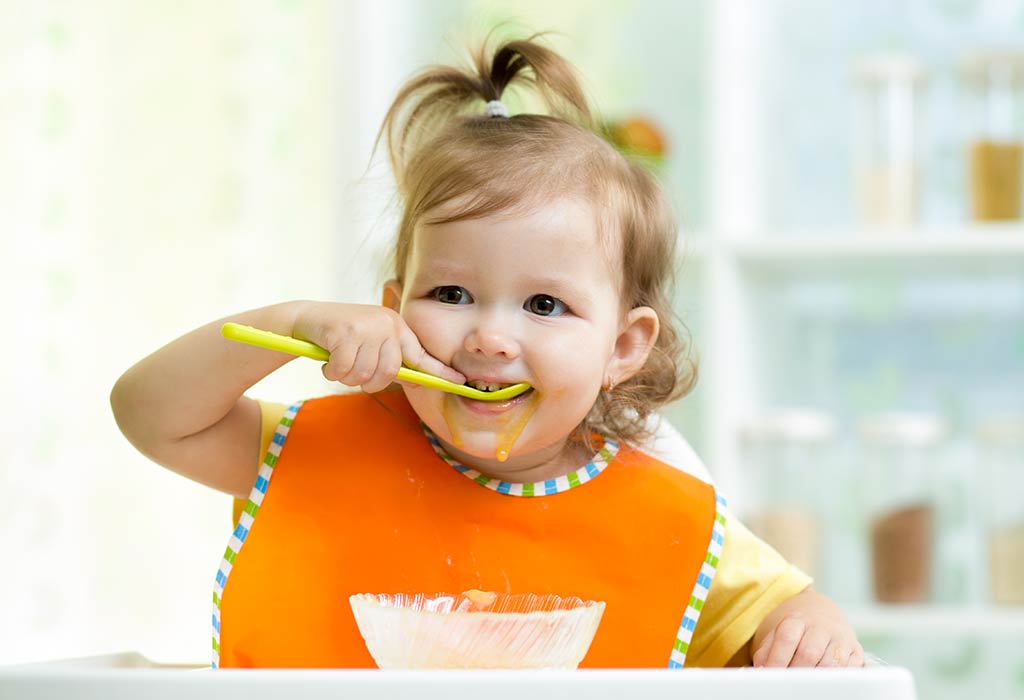

For first-time parents, feeding a toddler can be quite challenging. Toddlers between the age of 18 and 22 months are very active and playful. They can also be picky eaters and getting them to eat healthy foods can be extremely tough for you. If your 22-month-old toddler is giving you trouble when it comes to eating healthy food, read this article. This article will provide you with ideas and recipes that you can try to feed your 22-month-old toddler.
Nutrient Requirements of a 22-month-old Child
Proper nutrition is vital for the healthy growth and development of your baby. As parents, you should make sure that your baby gets all the essential nutrients that your body requires for proper physical and mental development. The various nutrients that a 22-month-old baby needs and the role that each nutrient plays in the baby’s growth and development are as follows:
1. Proteins
Protein plays a vital role in the development of body tissues and muscles. It helps in the formation and repair of tissues and muscles of your growing baby. Toddlers should have about 55 grams of protein per day. So, include dairy products, meat, fish, chicken, eggs, lentils, etc. in his diet.
2. Carbohydrates
Carbohydrates give toddlers the energy to stay active all day. Carbohydrates also promote healthy brain development of a child. A growing toddler should have six portions of carbs daily. To meet your baby's carbohydrate requirements, you can give him whole grains, bread, cereal, pasta, rice, corn, wheat, etc.
3. Fats
Fats are essential for the development of a toddler’s brain. Fats also help in muscle movement and build-up of cells. So do not hesitate in feeding healthy fats to your child. You can give ghee, olive oil, peanut oil, sunflower oil, and butter to your baby. Toddlers should get about three teaspoons of fats a day.
4. Vitamins
Vitamins play a crucial role in body metabolism, bone and tissue repair, immunity development, etc. Hence, it is an essential nutrient for a growing baby. You can give milk, cheese, eggs, fruits, and vegetables to a baby. Toddlers should have at least 1 cup of cooked vegetables and 1 cup of fruits per day.
5. Vitamin B12 and Vitamin D
Vitamin B12 are important for DNA synthesis, red blood cell formation, and brain function. It is not present naturally in plant foods. Hence, vegans should give their toddlers B12 supplements after consulting a doctor. Foods containing vitamin B12 can also be provided, like dairy products, meat, and fish. The body manufactures vitamin D with sunlight being the main catalyst. Make sure your toddler gets enough sunlight exposure in the early morning or evening.
6. Minerals
Minerals are vital for various body functions. Iron, calcium, phosphorous, sodium, copper, chloride, sulphur, zinc, selenium, etc. are minerals that a toddler requires for healthy development. Minerals are found in dairy products, fruits, vegetables, meat, fish, nuts, dried fruits, and green leafy vegetables.
7. Dietary Fibre
Dietary fibre is essential for good digestive health. Fibre makes food move through the bowel and thus stimulates bowel movements. Sources of fibre-rich foods for toddlers include unpeeled apples and pears, bananas, berries with seeds, and whole grains like oats, and yoghurt.
8. Water
It is important for a toddler to stay hydrated. Water makes up around 60% of the average body weight. Toddlers between the age of 1 and 3 years need 1.3 litres of water per day. The child’s fluid intake can also consist of other liquids like soups, juice, and milk. However, water is the best choice.
How Much Food Does a Toddler Need at 22 Months
A 22-month-old toddler has a stomach which is around the same size of his clenched fist. Hence, you cannot expect your toddler to eat quantities of food similar to that of an adult. Keep the meal portions small. On an average, a toddler needs 1000 to 1400 calories of food per day, depending on their size, age and level of activity. This would include around 80-85 grams of whole grains, 1 cup of vegetables, 1 cup of fruits, 2 cups of milk (450 to 500 ml), and about 55 grams of meat and beans.
Best Foods for a 22-month-old Baby
Here are some wholesome and nourishing food ideas for your 22-month-old toddler:
1. Vegetable Spring Rolls
Make tiny, palm-sized parathas stuffed with paneer, carrots, cauliflower, or boiled potatoes. Serve with a small dollop of ghee. This will provide a host of nutrients including essentials carbohydrates, fibre and more to babies for their overall development.
2. Cheese Sandwiches
Make cheese sandwiches and different vegetables to them like cucumbers, tomatoes, avocadoes..etc. Your child will love it. However, make small-sized sandwiches for your little one, and he will finish them in one go. Cheese provides calcium which is important for bone health. Ensure that your baby is not allergic to dairy.
3. Vegetable Soups
Make vegetable soups from carrots, mashed peas, spinach, or broccoli. This assortment of vegetables will give your baby ample Vitamin K, Vitamin B6 essential for the growth of hair, nails, etc, along with fibre.
4. Pancakes with Vegetable or Chicken stew
This dish is different from the standard fare and is also nutritious. Chicken stew and vegetable stew along with pancakes, made of rice batter, can be a complete nutrient package for your baby. Stew contains a good amount of fibre which can regulate the baby's digestive system.
5. Vegetable Koshari
Rice and lentils both are good for a toddler. And a koshari with vegetables will be more beneficial. This is a nutritious staple in most Middle Eastern households and kids will love it too when served warm. Rice and lentils both have useful proteins which are great for baby's development.
6. Vegetable Fingers with Hummus
Toddlers love hummus and it has many benefits for a child. It helps in the brain and retinal development of a toddler. It is also a good source of iron and your child will relish some cooked veggie fingers with the hummus dip.
7. Seasonal Fruits
Give your toddler seasonal fruits that are easily available in the market. This ensures that they get a variety of nutrients from different fruits. Different fruits have several nutritional benefits that can be associated with good health. A good dose of folic acid can help create red blood cells and fibre can soothe the baby's digestive tract.
8. Meal Combinations
Try usual meal combinations like shawarma wrap with Hummus, grilled cheese sandwich with vegetables, lentil rice with okra in tomato sauce, etc. Each of these food items come with their benefits be it protein, fibre, etc. This can help your baby develop his muscles and grow up healthy.
9. Scrambled Eggs with Tomatoes, Onions and Cheese
Make scrambled eggs with sautéed tomatoes and onions. Serve with grated cheese on top. Eggs are rich in iron, fat and protein which is essential for a growing baby.
10. Finger Sandwiches
Finger sandwiches with soft cheese, cucumber and carrots are tasty and nutritious for toddlers. Cucumber and carrots are a good source of fibre. Ensure you peel the skin off the cucumber before you give it to your baby.
22-Month-Old Baby's Food Chart/Meal Plan
Below is a 22-month-old baby's food chart –:
After Waking up
Breakfast
Mid-Morning Snack
Lunch
Evening Snack
Dinner
Monday
½ cup plain milk
Scrambled Eggs with bread slices
Watermelon cubes
Lentil Rice with Okra in tomato sauce
Chocolate milkshake
Spinach and cheese quiche
Tuesday
½ cup chocolate milk
Banana oats porridge
Fruit yoghurt
Baked almon and rown rice
Strawberry smoothie
Cheese and mushroom omelette
Wednesday
½ cup strawberry milk
Banana pancakes
Muskmelon pieces
Spagetti and meatballs
carrot and bell pepper finger cutlets.
Carrot rice seasoned with cumin
Thursday
½ cup milk
French Toast
Fresh fruit salad
Spinach and cream cheese pasta
Bowl of fruits
Hash brown potatoes with ketchup
Friday
½ cup milk blended with fresh strawberries
Apple and cinnamon waffles
Tangerine and Orange Slices
Grilled meat shawarma with hummus
Cornflakes or fruit loops with milk
lentil rice with peas cauliflower curry
Saturday
½ cup milk blended with banana
Soft Boiled eggs
Fresh Fig and Kiwi pieces
Vegetable fingers and backed chicken nuggets
Vegetable soup
Grilled cheese and tomato sandwich
Sunday
½ cup milk
Bread with peanut butter spread
Apple and pear pieces
Mixed vegetables and steamed fish with orange sauce
Bread with cheese and vegetable toppings
Cottage cheese sanwich and cucumber slices
Food Recipes for 22 Months Old Baby
Here are some nutritious recipes for 22-month-old toddlers:
1. Lentil, Rice and Vegetables
This makes a tasty and healthy dinner for a 22-month-old.
Ingredients
A pinch of turmeric, 3 tablespoons of rice, 1 small carrot, diced, some washed and chopped spinach, peeled diced potatoes, ½ teaspoon ghee and water.
How to Prepare
Soak the rice and lentil together for ½ an hour. Put the rice and lentil along with carrots, turmeric, and water into a pressure cooker. Cook for about 3 whistles until it is soft and mushy. Allow it to cool. Add some mustard and cumin seeds and serve.
2. Vegetable and Red Split lentil
Red Split lentil cooks very quickly and is high in proteins. Your toddler can easily digest it.
Ingredients
1 small carrot, diced, ½ an onion, finely chopped, 1 small potato, cubed; ½ teaspoon ghee, water, 2 tablespoons red split lentil.
How to Prepare
Add ghee to a pan and heat it on low flame. Add chopped onions and sauté until transparent. Add the carrot and potato and sauté for a few minutes. Add the red split lentil and water. Bring it to a boil. Cook for roughly 20 minutes until the lentil is cooked and the vegetables become soft. Puree this mixture in a food processor. Serve warm.
3. Mixed Vegetable Soup
This dish is flavourful and nutritious for toddlers.
Ingredients
5-6 spinach leaves, 2-3 beans, 1 small potato, a teaspoon of peas, 1 clove of garlic, ½ a carrot, water, ½ teaspoon ghee.
How to Make
Chop the vegetables and pressure cook them with water and a pinch of salt. Cook for 3 whistles until vegetables are soft. Add the ghee and blend the mixture until smooth. Vegetable soup is ready.
4. Strawberry milkshake
Toddlers find this nutritious milkshake very tasty.
Ingredients
1 cup of washed strawberries, 150 ml milk, a teaspoon of yoghurt, a teaspoon of sugar.
How to Prepare
Blend all the ingredients in a blender until smooth. Strain out the seeds and serve.
5. Bread Pizza
This dish is flavourful and healthy for toddlers.
Ingredients
Bread slices with edges cut off, grated cheddar or mozzarella cheese, tomatoes, green and yellow capsicum chopped into small pieces, grated carrot, peas.
How to Prepare
Toast the bread and lightly butter it. Add the grated cheese evenly over it. Sauté the vegetables until they are cooked. Spread them over the grated cheese. Melt the cheese in an oven for a few minutes. Bread pizza is ready.
Feeding Tips
Here are some feeding tips for a 22-month-old:
The diet for a 22-month-old baby should include fruits and vegetables. Cut the fruit into small pieces and chop vegetables and cook them until soft to avoid choking.
Keep the portions small. Do not try to feed your toddler too much food.
If the toddler does not want to eat more, accept her wishes and don't force her to eat. Babies have a mechanism that prevents them from overeating. If you overfeed the toddler, it interferes with their ability to stop when full.
Toddlers may have to be offered new foods at least 7 to 10 times before they decide to try it. So, be patient and introduce new foods 1 spoon at a time.
Toddlers are messy and tend to play with their food. Do not let that worry you. Put the food on a plate in before the baby. Let her have her fill. Clean up later.
22-month-old should drink full fat cow’s milk. They can have 100 to 150 ml twice a day.
Make sure your toddler is getting adequate amounts of iron and calcium in her diet. If you are concerned about nutritional deficiency, talk to your doctor about vitamin supplements.
Let the toddler sit at the table and eat with the family. This will encourage her to eat better and try new foods.
Give your toddler 2 to 3 different options to try for the main meals. Toddlers decide on their likes and dislike depending on the colour, texture and taste of the food.
Toddler meal plans are just rough guidelines. Each toddler is unique and has different tastes and nutritional requirements. What works for one toddler may not necessarily work for another.
Toddler’s appetites vary vastly. They could change based on growth, teething, and developmental milestones. Hence, do not compare the food intake of different toddlers. If you feel that your toddler is not getting adequate nutrition, talk to the paediatrician about it.
Also Read: Blueberries for Babies
23 Months Old Baby Food - Ideas, Chart and Recipes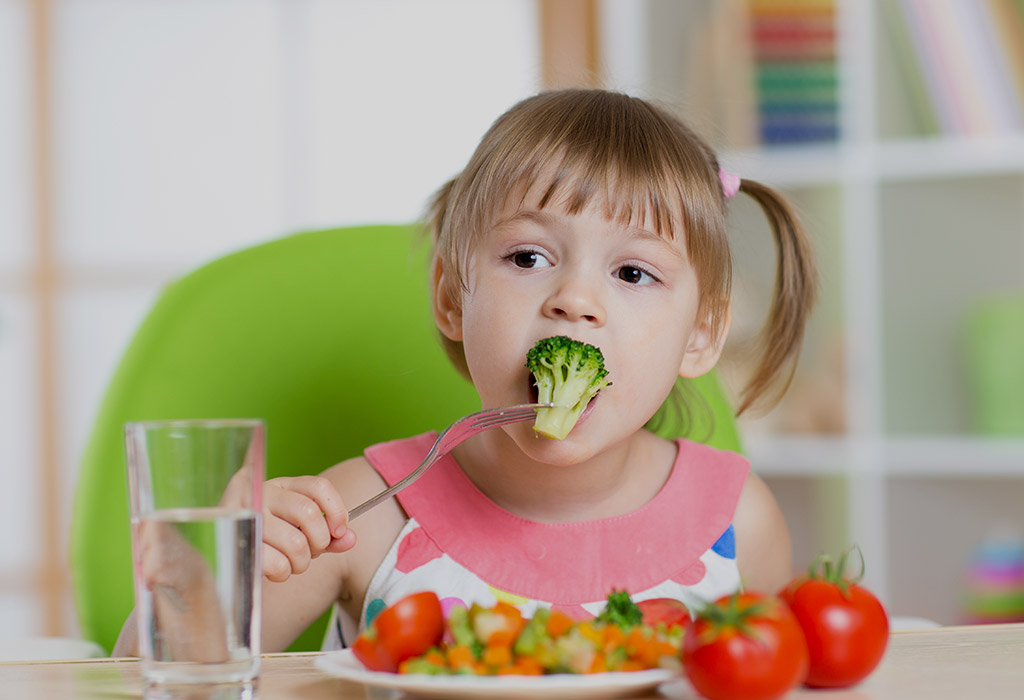

Your baby is now able to walk, run, climb, and effectively communicate with you. Milestones such as these indicate a change in nutritional requirements as well. Ironically, toddlers who tend to have much more active lives than newborns, require fewer calories. However, this does not mean nutrition is not absolutely crucial. Generally, solid foods are started when the baby is around six months old, with a slow increase in variety, flavours and textures as they grow older. Around the age of two, your little one can eat almost anything you can with some minor exceptions. This article will help you understand the food requirements of your toddler, along with a few ideas and recipes you can use.
Nutrient Requirements for 23 Months Old Child
While the nutrients required by all human beings are basically the same, the quality and proportions differ when it comes to toddlers and young children.
1. Carbohydrates
Carbs or sugars provide energy for metabolic processes, making them an absolute necessity. As your toddler is going through rapid growth and development, reducing carbohydrates at this point is extremely dangerous. Carbs are also used by the brain in order to function.
2. Sodium
Sodium is touted as a dangerous substance in excess, especially those with high blood pressure. But it is also an essential nutrient, as it maintains blood pressure by controlling the buffer levels of blood electrolytes.
3. Fats
Fats, especially from healthy sources, is important in growth, organ development, the formation of nervous tissue and so on. Further, fats like omega-3 fatty acids, DHA and EPA, are among the most important dietary nutrients for a growing child.
4. Protein
As you already know, protein is required to build muscles, perform various body functions, act as enzymes, and so on. However, toddlers function better on a high carb low protein diet, as their growth spurts are not imminent at this age.
5. Iron
Iron is required in the formation of blood and efficient functioning of the circulatory system. Deficiency of iron is very common among children across the world. Initially, breastfeeding provides the iron required by the baby, but as they are weaned, they need better sources.
6. Water
Water is not technically a nutrient but is more important than all the others combined. Water acts as a solvent, without which not even a single metabolic reaction can occur in the body. Even the production of proteins, fats and carbohydrates in the body requires water.
7. Fibre
Fibre can be obtained from most carbohydrate-rich whole foods. It regulates the digestive system and helps in easy waste removal from the body.
8. Vitamins
Vitamins are chemical molecules that perform a wide range of bodily functions. They are responsible for blood clotting, skin maintenance, bone growth, energy production, and innumerable other activities.
How Much Food Does a 23 Months Old Toddler Needs?
Toddlers around the age of two, require approximately 1000-1300 calories every day, but this can change based on how active they are. Coming to the other nutrients, per day they require around 1 g of Sodium, 7 mg of iron, 12 g of protein, 140 g of carbs, 19 grams of fibre, 40 g of fat, and around 1.5 litres of water.
Best Foods for Twenty-Three-Old Baby
Here is a list of the best foods for twenty-three-month-old babies:
1. Fruits
Fruits are a delicious snack and come in countless colours, flavours and textures. They provide carbohydrates, antioxidants, fibre, vitamins, minerals and water. These nutrients are great for building the immune system and protecting your baby from infections.
2. Yoghurt
Yoghurt and laban are a great food for children, especially those who find it difficult to process milk or have lactose intolerance. Yoghurt and laban are rich in probiotics, that is healthy intestinal microflora or bacteria. These bacteria are known to strengthen the immune and digestive systems.
3. Grains and Cereals
These foods include rice, wheat, barley, maize, quinoa, oats, millets and so on. They are great when it comes to energy, as they are rich in complex carbs. Ideally, you should feed your child whole grains, as the refined or processed versions have a lot of the surface nutrients degraded.
4. Veggies
Vegetables, like fruits, provide energy, fibre, minerals, water, fibre and antioxidants. They support metabolic functions as well as protect against diseases. Please ensure you wash them beforehand as there might be pesticides on the skins. Ideally, you should retain the skin as it contains a great deal of the nutrients.
5. Eggs
Eggs are an important source of protein and support your toddler’s growth and development. Eggs also contain important nutrients like omega-3 fatty acids, zinc, Vitamin B12, iron and so on.
6. Lean Meat
Meats are also a great source of protein, much like eggs. In addition to supporting muscle development, lean meats like chicken and fish are rich in selenium, niacin, folate, vitamin B6, vitamin B12, phosphorus, iron and so on.
7. Bread
Bread, preferable the whole-grain kind, is both tasty and nutritious. Brown bread or multigrain bread contain fibre, vitamins, antioxidants, minerals, and protein in addition to energy-producing complex carbohydrates.
8. Milk
Milk is considered a whole food, as it is rich in proteins, fats, carbs, minerals, as well as vitamins. Further, the calcium and phosphorus in milk are essential in the formation of teeth and bones.
9. Ghee
Dairy products like ghee have the same properties as milk, but can be used in a variety of ways. Further, ghee can be used by kids with milk allergies, as the allergens, namely casein and lactose, have been removed during preparation.
10. Nuts
Nuts like almonds, cashews, walnuts, and so on are rich in healthy fats, which are essential for growth, development, circulatory health, the functioning of the brain, and so on. Fats also provide some amount of energy in slow-release form.
23 Month Old Baby Food Chart / Meal Plan
Here's a food chart you can follow for your little one.
Type of Food
Servings Per Day
8-16 Months
Servings Per Day
16-32 Months
Examples
Cereals
At least three, preferably whole-grain
At least five, preferably whole-grain
A slice of brown bread; half cup pasta or brown rice; one cup oatmeal
Proteins
Two
Two to four
One boiled egg; half cup chicken or fish; half cup boiled lentils
Vegetables
One
Two
One cup cooked and diced veggies, such as tomatoes, onions, legumes, carrots, and so on
Dairy
Two
Two
One cup milk or yoghurt ; half cup cheese
Water
Four
Four
One glass of water
Fruits
One
Two
One diced apple; one banana; half cup of grapes
Food Recipes for 23 Months Old Baby
Here are a few food recipes for your 23-month-old baby that they will enjoy:
1. Breakfast Cereal
Breakfast cereal is a standard meal that can be varied to provide different flavours.
Ingredients
Half cup oats
Half cup milk
Half cup fruit juice
One tbsp honey
How to Prepare
Mix all the ingredients together in a bowl. Drizzle honey over the mixture. You can top it with nuts and raisins if you want.
2. Mixed Salad
This is a yummy meal that offers a wide range of health benefits.
Ingredients
Half cup milk
2 tbsp Greek yoghurt
Half cup berries, diced
Half cup boiled carrots
One sliced banana
One small cube of cheese
Two tbsp bran
How to Prepare
Boil the milk beforehand. Mix all the ingredients together and toss for even consistency. Add honey or ghee for taste.
3. Bean Rice
This lunch recipe is filling as well as delicious.
Ingredients
Half cup rice
Four tbsp cooked rajma beans
Half cup diced onions and carrots
Two tbsp milk
One tsp cinnamon
How to Prepare
Once the rice and beans have been cooked, mix them together. Then add the veggies, milk and cinnamon and mix well. You can also add a small pinch of garam masala, but only if your child can tolerate spices.
4. Macaroni and Cheese
This common recipe is employed around the world, and it is quite simple to prepare.
Ingredients
Half cup macaroni
Two tbsp grated cheese
Half cup chopped veggies like broccoli, bell peppers and carrots
Half cup milk
How to Prepare
Cook the macaroni until ready. Before it cools, add the cheese and allow it to melt. Then mix in the remaining ingredients until an even consistency is obtained.
5. Chicken Noodles
This non-vegetarian meal is high-protein. You can replace the chicken with vegetarian substitutes like tofu, soybeans, legumes, and so on.
Ingredients
Half cup chicken, cooked well
Half cup noodles
Two tbsp chopped carrots
Two tbsp shelled green peas
Half cup Greek yoghurt
How to Prepare
Cook the noodles, carrots and green peas together until ready. Mix in the chicken and yoghurt. You can add a pinch of pepper or turmeric for added flavour.
Feeding Tips
You can follow the below tips while feeding your little one.
Don’t allow your toddler to have sweet drinks during the day, especially between meals. Water is the preferred choice if they are thirsty.
Food items which are choking hazards include crisps, whole vegetables, nuts, bony meat, candy, chewing gum, popcorn, ice cubes and so on. If you need to use any of these, make sure they are sliced up well beforehand.
Ensure your toddler is sitting up while having their meals.
Allow them to indulge in physical activities as they provide various health benefits.
It’s fine if your baby spills while drinking. Simply replace their cups with a spill-proof one.
When serving fruits and veggies, make sure you extract cores, pits, seeds and rough peels.
Teach your toddler how to take smaller bites and make sure they chew their food properly before swallowing.
Establish a routine for mealtime, as this will avoid any hunger pangs or eating between meals.
Please ensure your child does not overeat during their meals, as this can cause weight gain, constipation, and various other complications.
Encourage your toddler to try different kinds of food, with unique tastes and textures.
Children know exactly when and how much they want to eat. As long as they are not too fussy, you should feed them according to their instincts. If they show disinterest, such as pushing away the food, turning their heads, spitting food out, refusing to open their mouth and so on, don’t force them to eat that food at that time. Just like us, babies and toddlers have their own tastes and act on them.
Also Read: 2 Year (12 to 24 month) Old Baby Food Chart
24 Months Old Baby Food - Ideas, Chart, and Recipes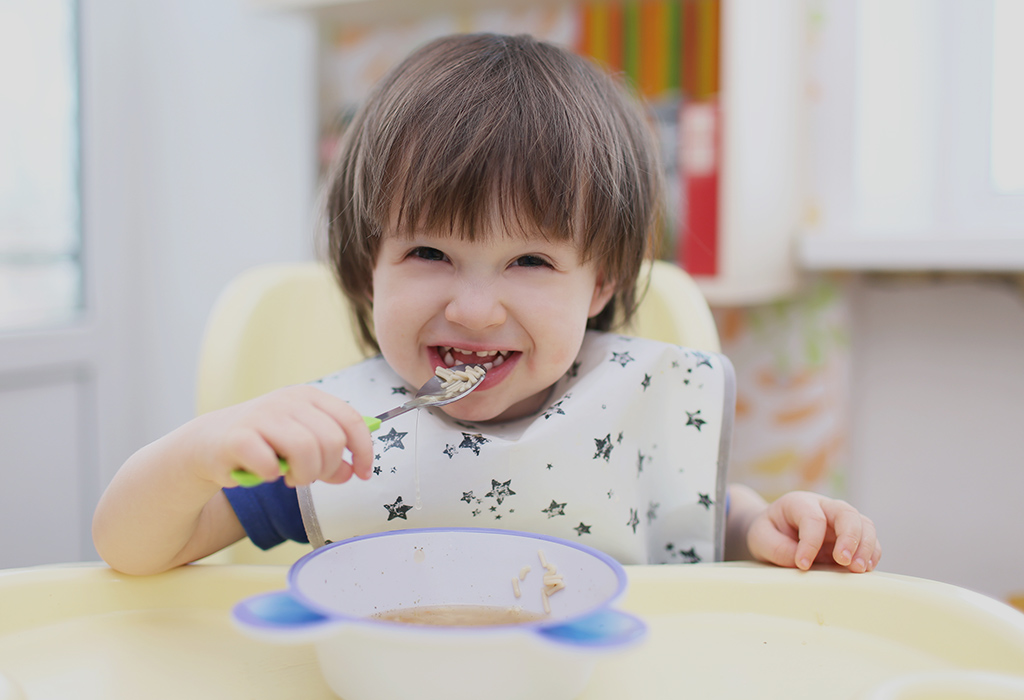

Your child has turned two and now he can eat almost every food item that is on your plate. While this might seem like a blessing, it also means that your child will be even pickier than before, and refuse to eat certain items just because he won’t like the taste. So, you will have to be more careful about his food choices. But there is no need to worry about your child’s food habits as we have some amazing ideas and recipes that you can try for your two-year-old.
Nutrient Requirements of a 24-month-old Child
At 2 years, your child’s appetite would definitely increase and hence you will see him gorging on whatever comes his way. While he eats anything and everything, it is your responsibility as a parent to see if his nutrient requirements are being fulfilled or not. Following are the nutrient requirements of a 24-month-old child:
1. Calories
Between the ages of 1 and 4 years, a child’s calorie requirement does not increase as extensively as you would expect it to. Most children need only about 1200-1300 calories on a daily basis.
2. Proteins
The growth of a child’s body and muscles heavily depends on his proteins intake. But that does not mean his diet should constitute only of protein-rich foods. A child gets enough proteins from the usual food products.
3. Carbohydrates
These pretty much form the core of each meal a child has at this age. A child needs around 130-150 grams of carbohydrates for a kid to keep functioning properly through the day.
4. Dietary Fibre
Since most meals include processed foods, it is important to maintain an inclusion of whole food items as well. Fruits or grains can incorporate fibre into your child’s diet and keep his digestive system healthy.
5. Sodium
Most parents fret about children getting a lot of sodium from the salt. But maintaining about a gram of sodium intake daily is utterly important for children at this age.
6. Iron
Along with sodium, iron is another element that plays a vital role in keeping the circulatory system of a child’s body at an optimal level. When the diet is balanced, there’s no need for iron supplements to be given along with it.
7. Milk
The importance of milk cannot be stressed enough. Milk is necessary for bone development and overall growth and development of a child, so make sure your child drinks a glass of milk daily. You can give him cow’s milk, soy milk, or almond milk too.
8. Water
The presence of water might seem surprising in the list of nutritive elements but you would be surprised to know that only a few children meet the daily requirement of drinking 1.3 litres of water every day. Hence, you must check if your baby drinks water enough or not.
How Much Food Does a 24-month-old Toddler Need?
Although your child is growing, it does not mean you feed him every hour. As per his current age, he requires no more than 1.5 kilocalories on a daily basis. And this can be easily achieved with a diet that has a good combination of grains, fruits, vegetables, and other food items.
Best Foods for a Twenty-four-month-old Baby
The completion of 24 months puts your child at an important stage in his life. Going ahead, it is important for him to gain a good amount of weight and develop an energy reserve to power him through life. A few specific foods can help him make that happen.
1. Eggs
Giving your little one a whole egg, either as an omelette or in the boiled form is a great way to add to his weight and make him a filling meal. Children can eat both the yolk and the whites without any issues.
2. Potatoes
This vegetable can go with nearly any kind of meal preparation. Yes, you must be bored of eating it, it is extremely vital for your kid. Your kid’s diet should include potato. Starchy vegetables are quite essential at this age.
3. Yoghurt
A child needs strength right from an early age. The cream of the milk is a great source of fat and even provides energy to the body, which can be synthesized by the body in the best form and prove beneficial for the child.
4. Milkshakes
Your child may whine when it comes to drinking his daily glass of milk. Combining the same with a fruit can help turn it into a delicious milkshake, which provides added nutrition and would be loved by your little one.
5. Ghee
While vegetables should be prepared in ghee itself, you could opt for using olive oil instead to keep your own health intact.
7. Nuts
Breakfast is a great time to include a variety of nuts in your child’s diet. Let it be mixed with cereal or let him have a few after he wakes up in the morning. Everything from almonds to cashews and raisins is good if given in moderation.
8. Flaxseeds
A healthy combination of proteins, fats, and fibre are essential for a growing baby. To meet these nutrient requirements, you can include flaxseed in his diet. Flaxseeds are immensely popular among those but pumpkin and melon seeds can do the trick as well.
9. Peanut Butter
Yes, this is a healthy food item for your child. Although it is best to keep peanut butter and jam sandwiches for special occasions, you can use the butter in various preparations, since it is a great source of fats and energy.
10. Honey
Most households make use of refined sugar to bring out the sweetness in their preparations. Replacing it with honey is not only a healthy alternative for everyone, but the child receives its health benefits as well.
24 Month Old Baby Food Chart/Meal Plan
Figuring out what to give your 24-month toddler can take up an entire day. Make use of a simple meal plan to get a foothold, and plan your own chart accordingly. The following meal plan is great for children who are 2.
Day
Breakfast
Lunch
Snacks
Dinner
Monday
Banana pancakes a glass of milk
Pasta with Basil Pesto and green salad
An apple with strawberry milk
Eggs on toast
Tuesday
Oats porridge with banana and a glass of milk
Italian style chicken with mozzarella and tomato sauce
A pear
Spinach and onion cheese quiche
Wednesday
French toast and buttermilk
Meat shawarma and humms wrap
Pineapple chunks
Grilled cheese and tomato on toast
Thursday
Apple and cinnamon waffles with a glass of milk
Lentil and rice Koshari with mixed vegetables
A bunch of grapes
Spaghetti and meatballs in tomato sauce
Friday
Cheese and bell pepper omelette
Fish fingers and hash bowns
Orange pieces
Vegetable spring rolls
Saturday
Boiled eggs and avocados
Penne pasta with basil pesto and peas
A banana
Cottage cheese and cucumber sandwich
Sunday
Honey with toast and a glass of milk
Okra in tomato sauce and grilled chicken
An Apple
Sweet potato hash
Food Recipes For a 24-months-old Baby
In order to make sure your little kid eats his meals properly, here are a few recipes you can make to ensure that he gets the right nutrients.
1. Spinach and Beetroot Cutlets
These make for a great breakfast item on weekdays and even on weekends.
Ingredients
Spinach puree, 2 tablespoon
Beetroot puree, 2 tablespoon
Whole wheat flour, 0.5 cup
Jaggery, 0.5 cup
Butter, 2 tablespoon
How To Prepare
Begin by preheating the oven at a temperature of 200 degrees.
Mix together jaggery and butter in a bowl along with spinach puree.
In another bowl, mix beetroot puree with jaggery and butter.
Add the flour to both the bowls with some water, and make the dough.
You can even mix spinach and beetroot puree and make their cutlets.
Make cookie shapes from the dough and line them on a greased baking tray.
Place them in the oven and let them bake for about 8-10 minutes.
Serve warm with curd or chutney.
2. Finger Millet Flour Cake
Satiate your little one’s sweet cravings with this healthy and delicious Finger Millet flour cake.
Ingredients
Olive oil, 0.5 cup
Vanilla essence, 1 teaspoon
Salt
Milk, 1 cup
Yoghurt, 1 cup
Baking soda, 1 teaspoon
Brown sugar, 1 cup
Cocoa powder, 2 teaspoons
Whole wheat flour, 1 cup
Finger millet flour, 0.5 cup
How To Prepare
Preheat the oven to 180 degrees.
Take wheat flour in a big bowl and add finger millet flour, brown sugar, baking soda, salt, cocoa powder to it. Mix it thoroughly.
Add yoghurt, oil, milk, and vanilla essence to it and mix well again.
Pour this mixture in a baking tray and place it in the oven for about half an hour. Serve it with some nice chocolate syrup.
3. Egg panckae
When a simple snack does not fill your child’s tummy, give it a twist. Make an egg pancake and he will finish it in no time.
Ingredients
Salt
Pepper
An egg
pancake batter
How To Prepare
Heat the pan and sprinkle a little oil on it.
Pour pancake batter in the centre and spread it around. Now crack an egg exactly over it.
Let each side be cooked properly and add salt and pepper for additional taste.
4. Sweet Potato Puffs
This food items is a great evening snack and can even be a major side dish for a light dinner.
Ingredients
Flour, 0.5 cup
Cereal, 1 cup
Applesauce, 1 tablespoon
Water, 2 tablespoons
Vegetable oil, 2 tablespoons
Sweet potato, mashed, 4 cups
How To Prepare
Preheat the oven at a temperature of 350 degrees.
Mix together oil, potato mash, and applesauce in a bowl. Add water gently till the mixture blends fully.
Follow it up with cereal and flour as needed.
Use the dough to make small ball-like portions. Poke a small hole in the middle to let the trapped air out, allowing it to puff up.
Apply oil on a baking tray and arrange the puffs on it. Bake them for about 15 minutes and serve.
5. Fried Bananas
For little kids who turn their face away at the sight of a banana, this fried delicacy would be hard to resist.
Ingredients
Oil
Cardamom powder, 1 teaspoon
Bananas, 2
How To Prepare
Slice the bananas after peeling them.
Add some ghee on a pan and fry the pieces. Sprinkle cardamom powder over those and enjoy.
Feeding Tips
A few handy tips for feeding your child can go a long way in making the entire meal experience a memorable one.
Do not reward or punish your child when it comes to his eating habits. He will learn in time what is healthy and what is not, so don’t force him to eat anything.
Do not feed spicy food items early in life.
Refrain from giving anything that is extremely hot or cold.
Make it a habit to sit together at the dining table and enjoy a meal.
When giving him snacks, choose nutritious options.
Keep meals frequent and small in quantity.
Let children take small portions of the food.
Avoid rushing through the meals.
Maintain a combination of vegetables, fruits, and milk.
When introducing any food, check if it provides him energy or not. Do not give foods containing empty calories.
Introducing healthy and nutritious foods at the right age can help your child pick good habits in the future too. Most kids warm up to the foods once they see the entire family enjoying it together and work towards developing a habit of doing the same. So, make sure that you eat with your family every day.












